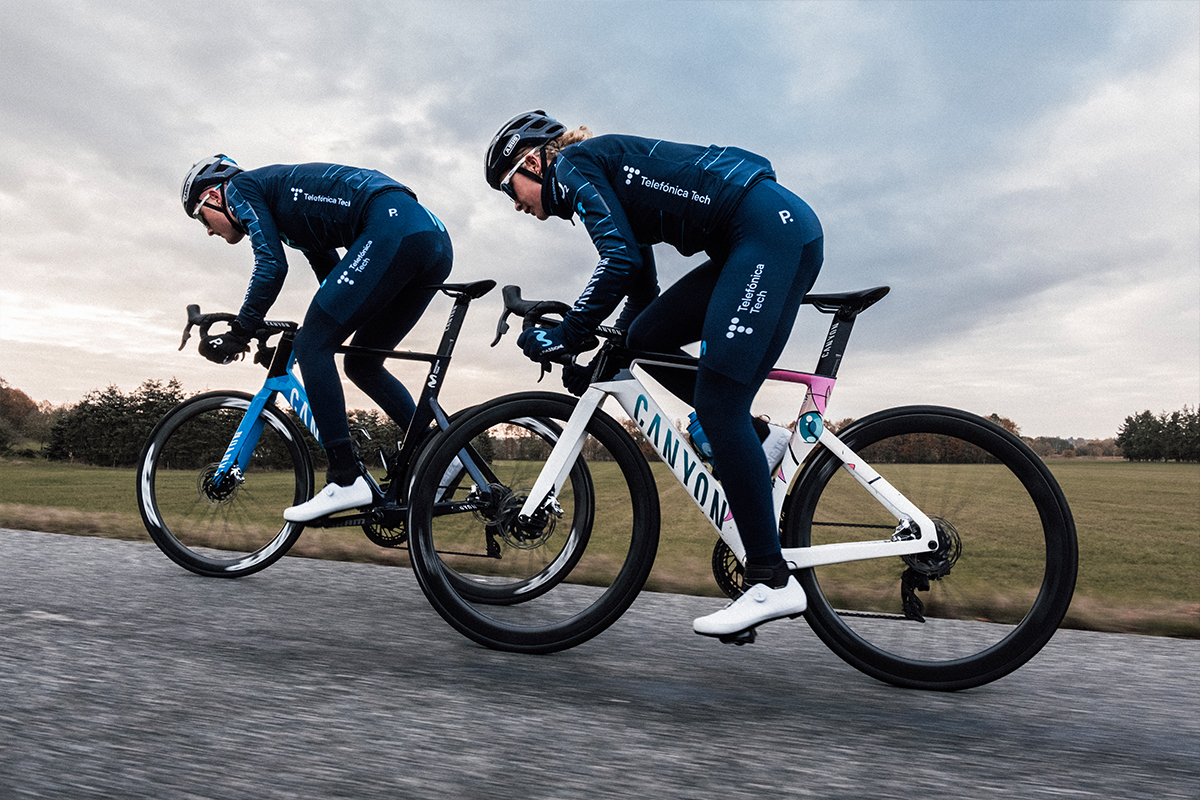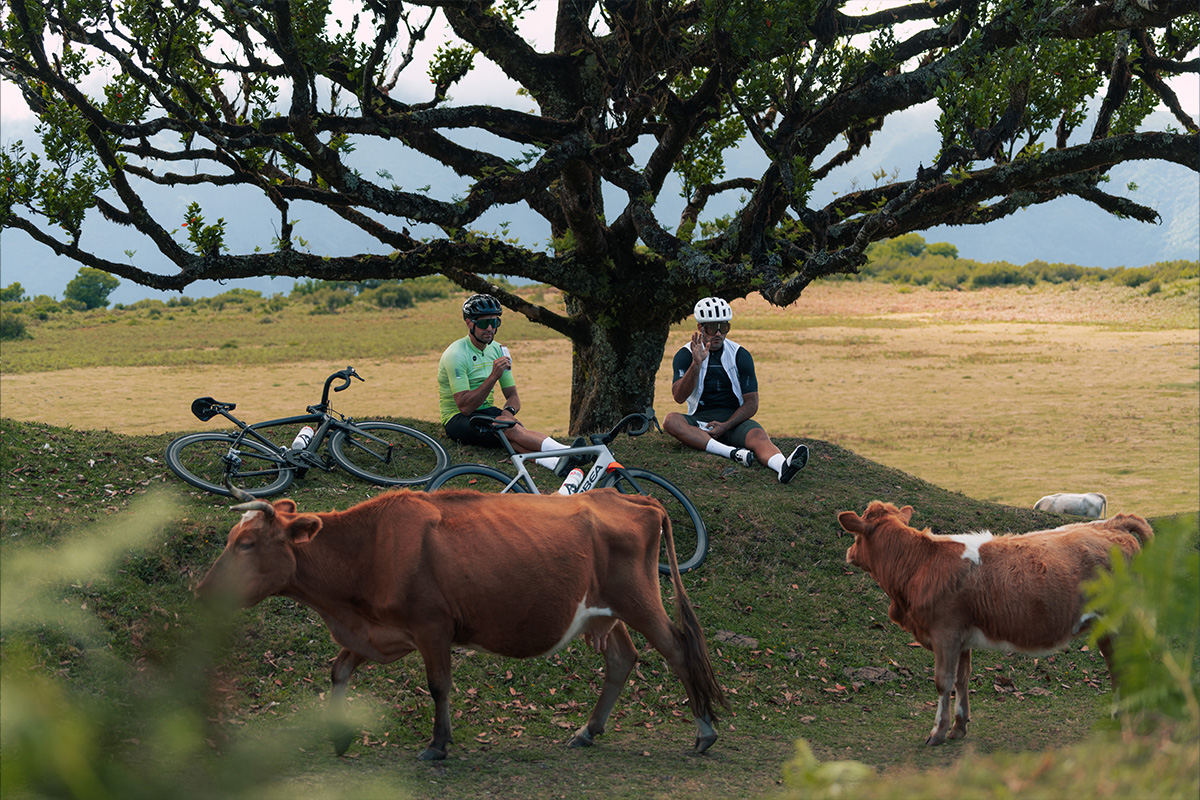Sometimes, the best journeys are those that incorporate multiple adventure disciplines, and of course, plenty of friends who are willing to come along for the ride. Last April, Sami Sauri was joined by her friends Gaby and Bella for a combination ski/bikepacking adventure in the French Alps that, despite early predictions, had no shortage of snow—or good times. Read on to learn about their special, cheesy trip.
I remember our conversations being like, “How are we going to pull this off?” We had an initial plan, but everything is green; everything is grass and there is no snow!
I remember joining Gaby on a Wednesday in early April at her house in Morzine. I came to ski and to bikepack, but on the day I arrived, we ended up doing our first ride in shorts to the top of a climb where we had to walk due to some icy, and then soggy, snow. The heatwave was real, and there was no snow anywhere.
The fact of putting a specific date on something like this is really hard. You don’t know the conditions months before, or even weeks or days, and everything can go wrong—or turn into a perfect adventure, and that’s what it was! A last-minute switch to the forecast made our days some glory days!
We met with Bella, a good friend of Gaby, and her husband. I hadn’t officially met her before, but I’d heard lots of stories of her adventures, so why not bring her along on our first-ever ski bikepacking trip?!
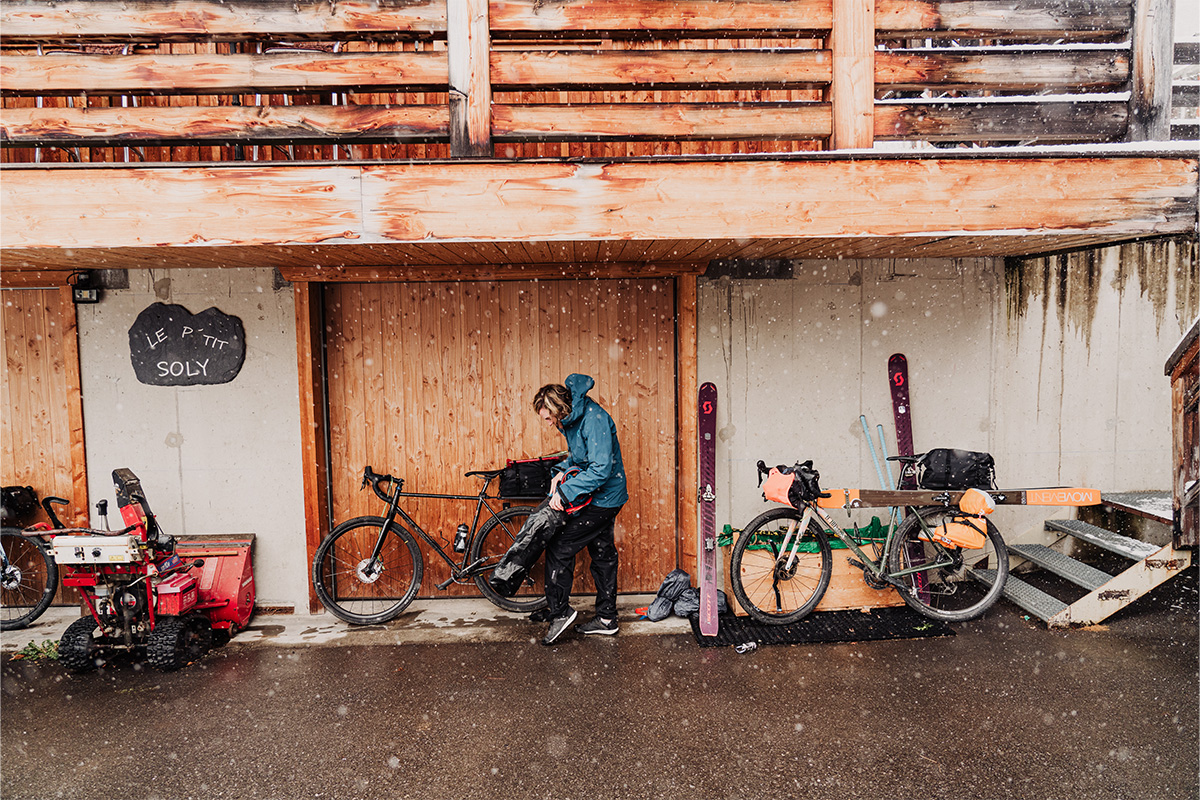

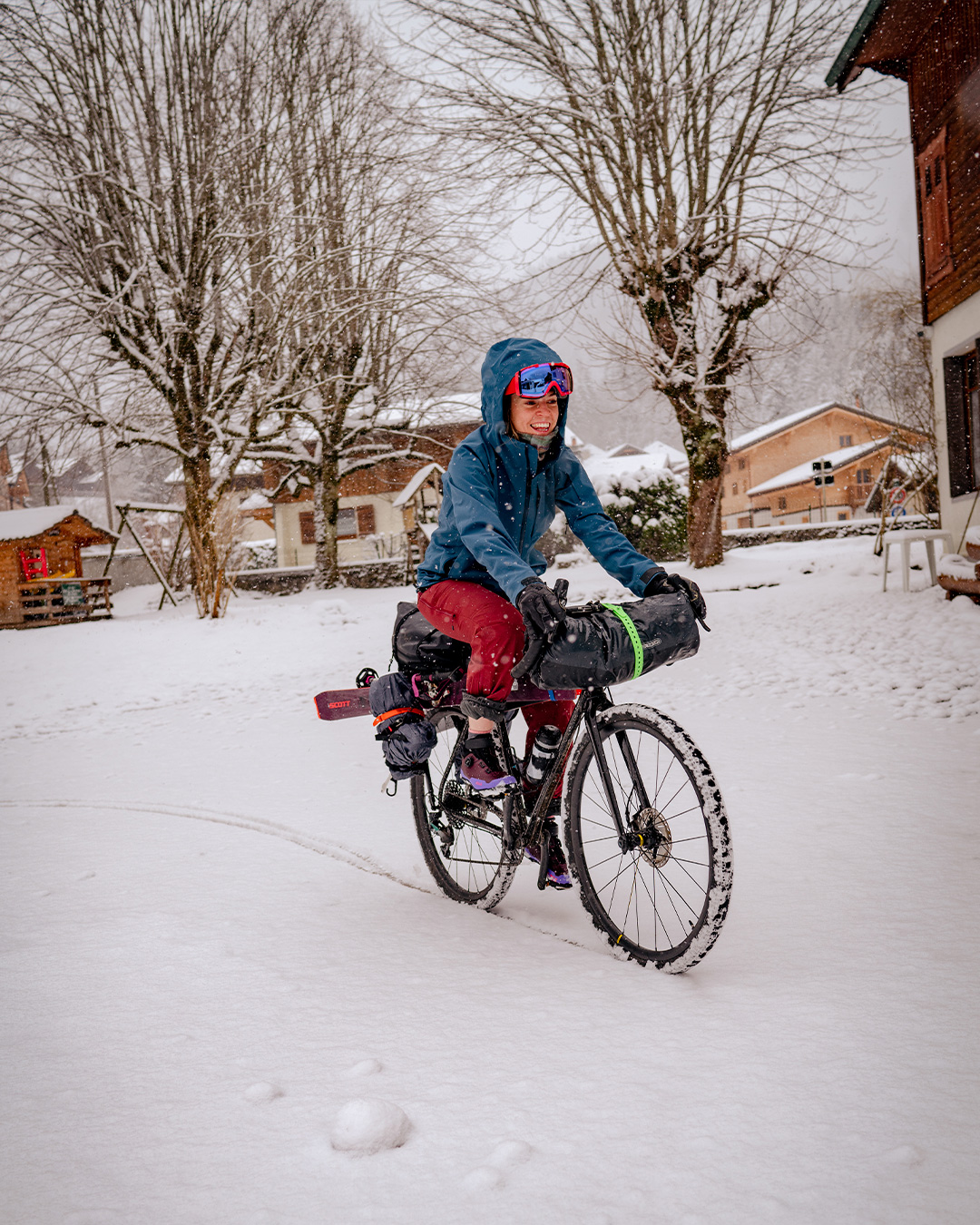
So, on a Friday around 12 am, we set off under the snow to go straight up and over Col du Corbier. Already making our tracks through the snow with our tires, we reached the top with big smiles on our faces, enjoyed some food and water, and dropped down into the valley.
Our destination was Abondance, but right before we got there, we were so lucky to find “la fromagerie” of the valley open, and of course we needed some good cheese for our lovely fondue, so we stopped and let the local surprise us with the best “fromage” of the region.
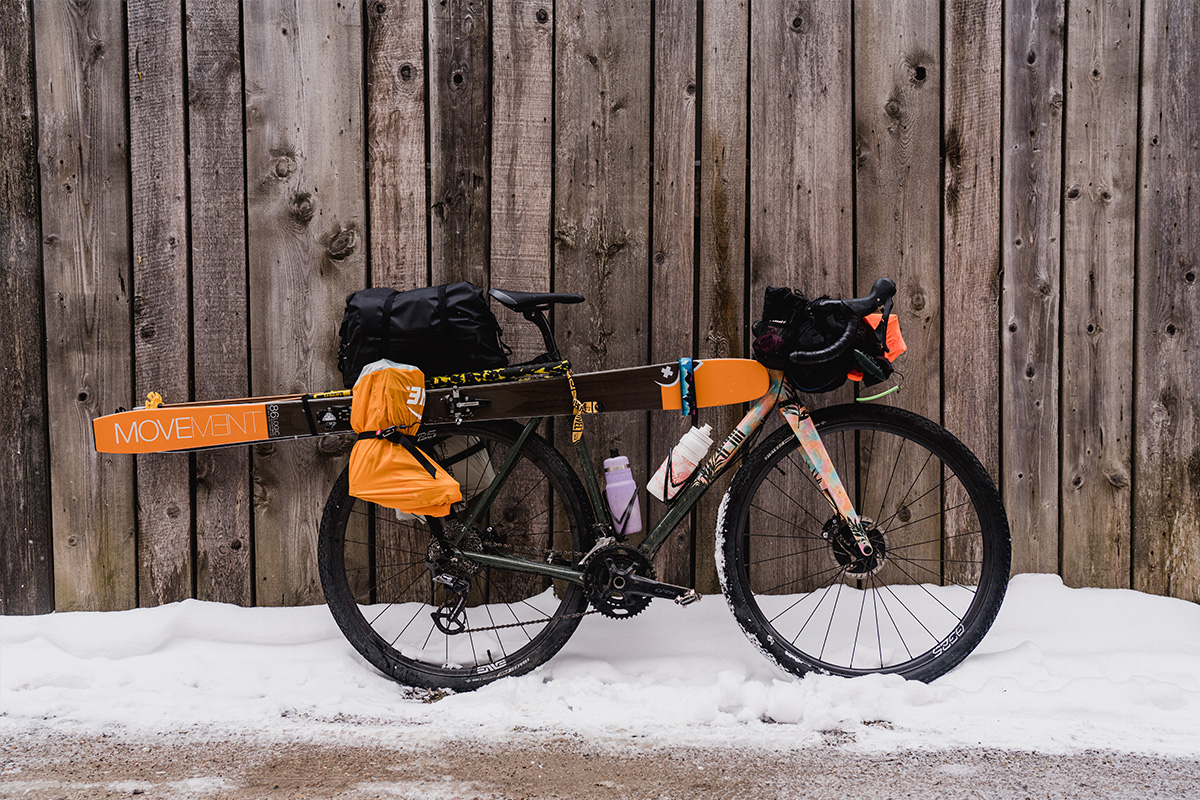
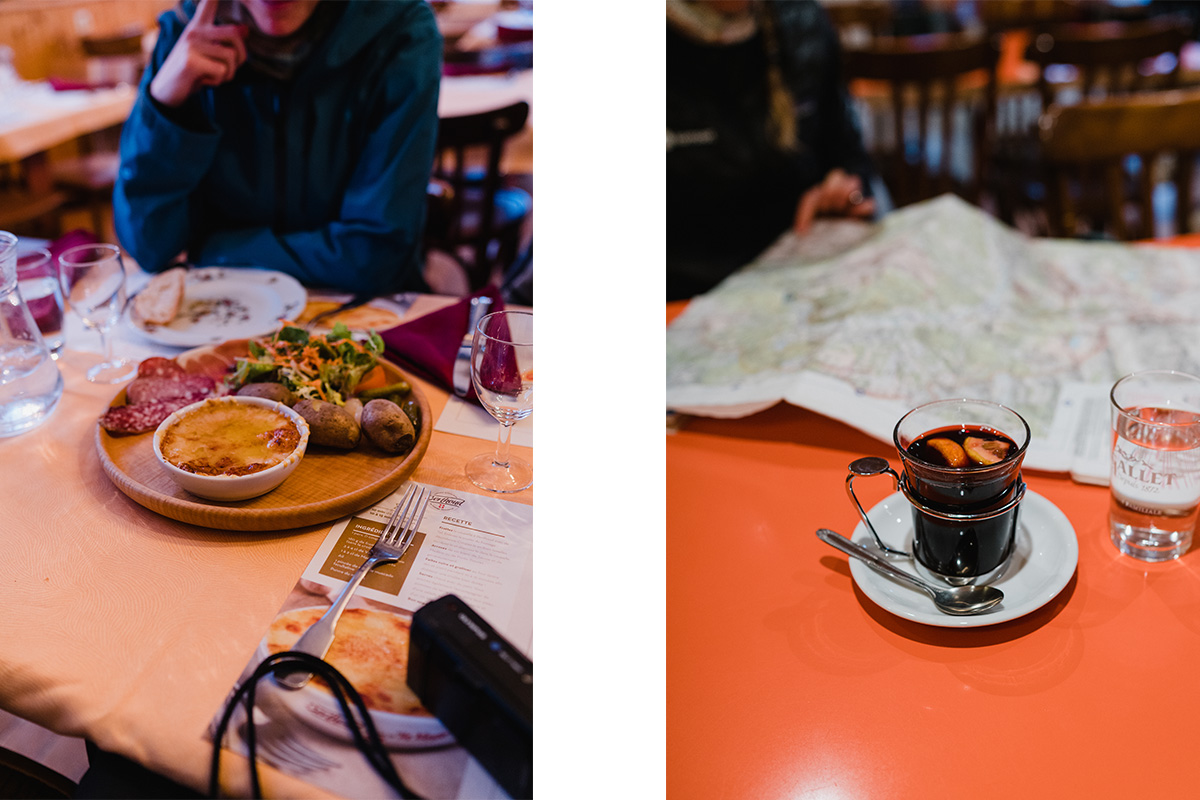
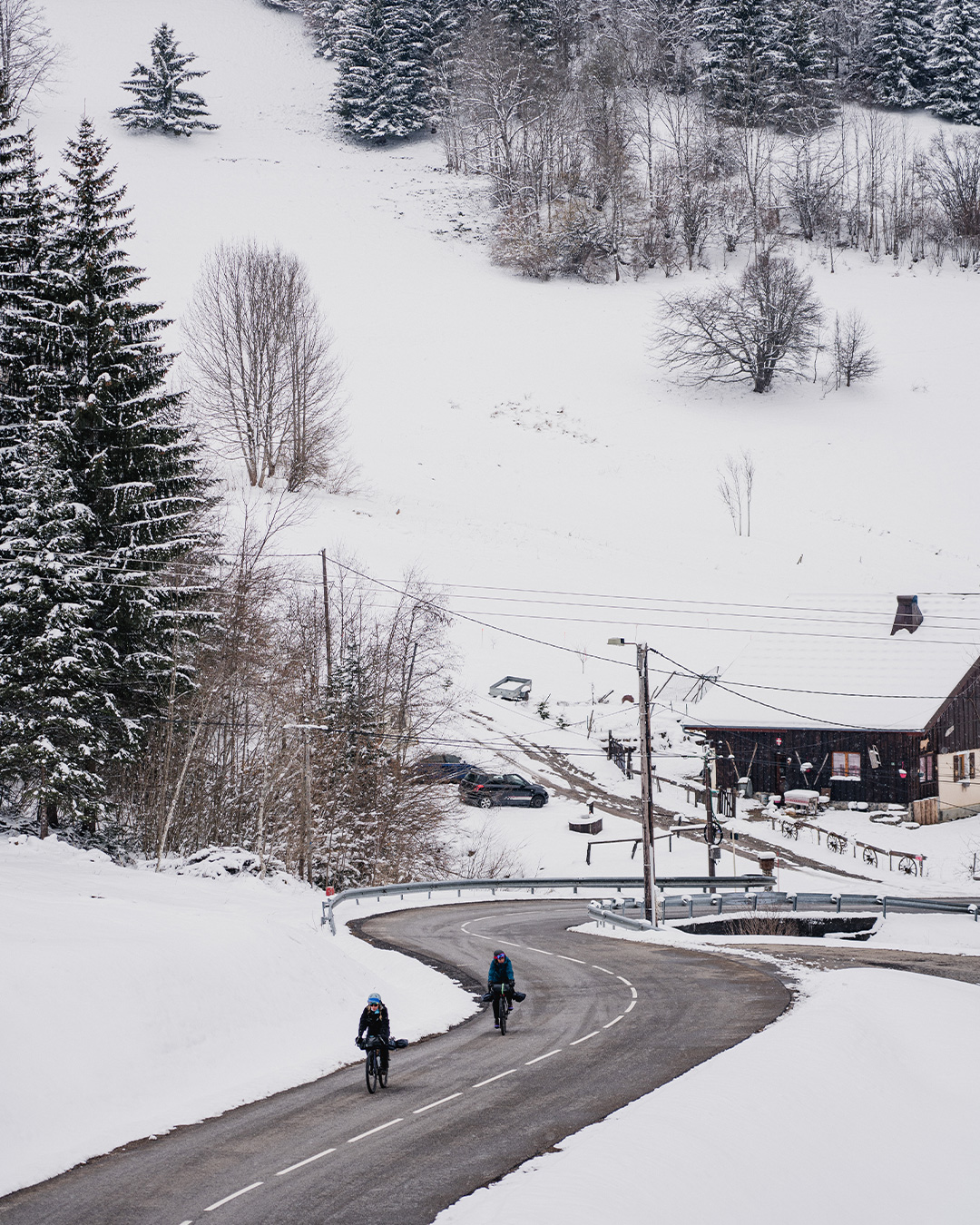
Abondance is a cute little village in the French Alps, very close to the Swiss border. Being that this was one of the last weekends of the season, only one hotel, one bar, and one supermarket were open, so lucky us, we got to stay in the “Tourist Hotel” (such a great name) where they accommodated us with a storage room for our bikes and some random music. We were early enough to do a little “apero” at the bar in front where some hot wines and beer were served while we looked at our plans for the following day.
We woke up relatively early and had breakfast in the hotel. We geared up and switched our Fizik gravel and winter shoes to our ski boots and started our walk to buy some bread and get the refuge key up a very steep hill. I’m not going to lie, we underestimated the walk to the initial point of skin up, and so we ended up getting a lift from a guy straight to the parking lot where the path started.
We skinned up this magical valley, and it was like a snowy fairy-tale. Everything was covered in snow; our skis were moving fluffy new snow all over and the valley had clear, pretty views we’d never expected.
After a little hill, we could start to see the refuge. But when we got the key, we didn’t really get any specifications as to where and which one was our little house—there were a few of them—and it took us a bit to get that sorted. But there it was: a little cabin on top of the hill surrounded by trees, the cosiest spot ever!
We didn’t waste any time, and we ate something quickly and then went to check our surroundings and have a great time. We skinned up around some bushes and trees until we found a nice point to drop down a bit, and from there, we skinned back “home”. It was just a nice little afternoon checking the terrain.
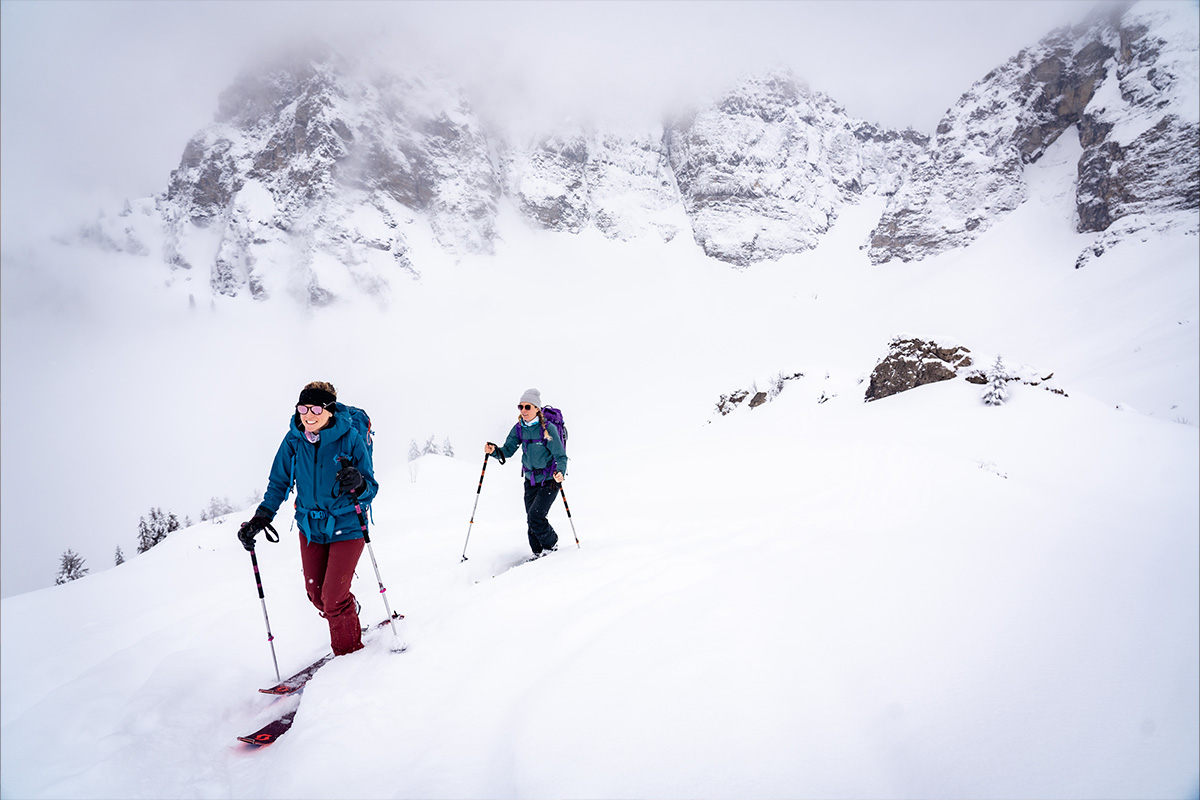
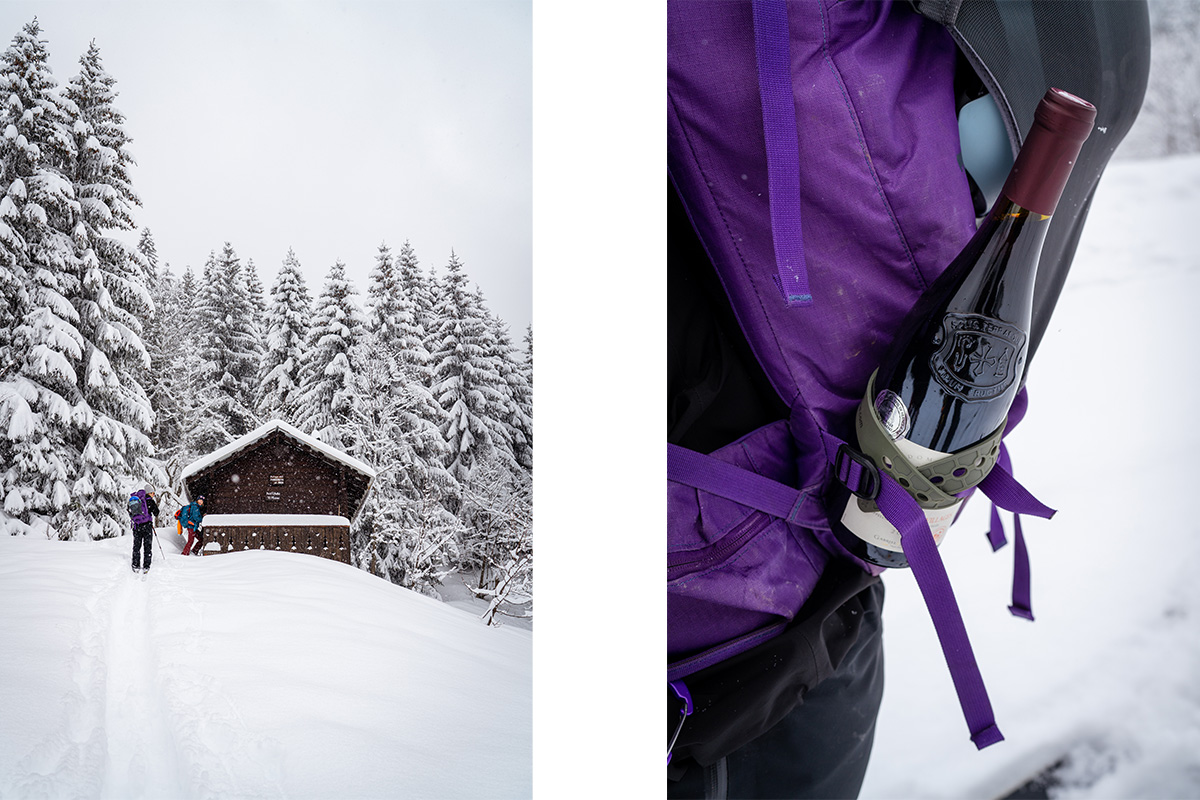

The time had come, and we were ready for fondue! The refuge of Tinderets, as it was called, had a fondue set already there, you just needed to bring a candle.Garlic, cooking wine, cheese, cheese, cheese, and mix—a bit of salt and pepper and voilà! You’re ready to dip in the bread! Good night with a full belly and a fire stove on.
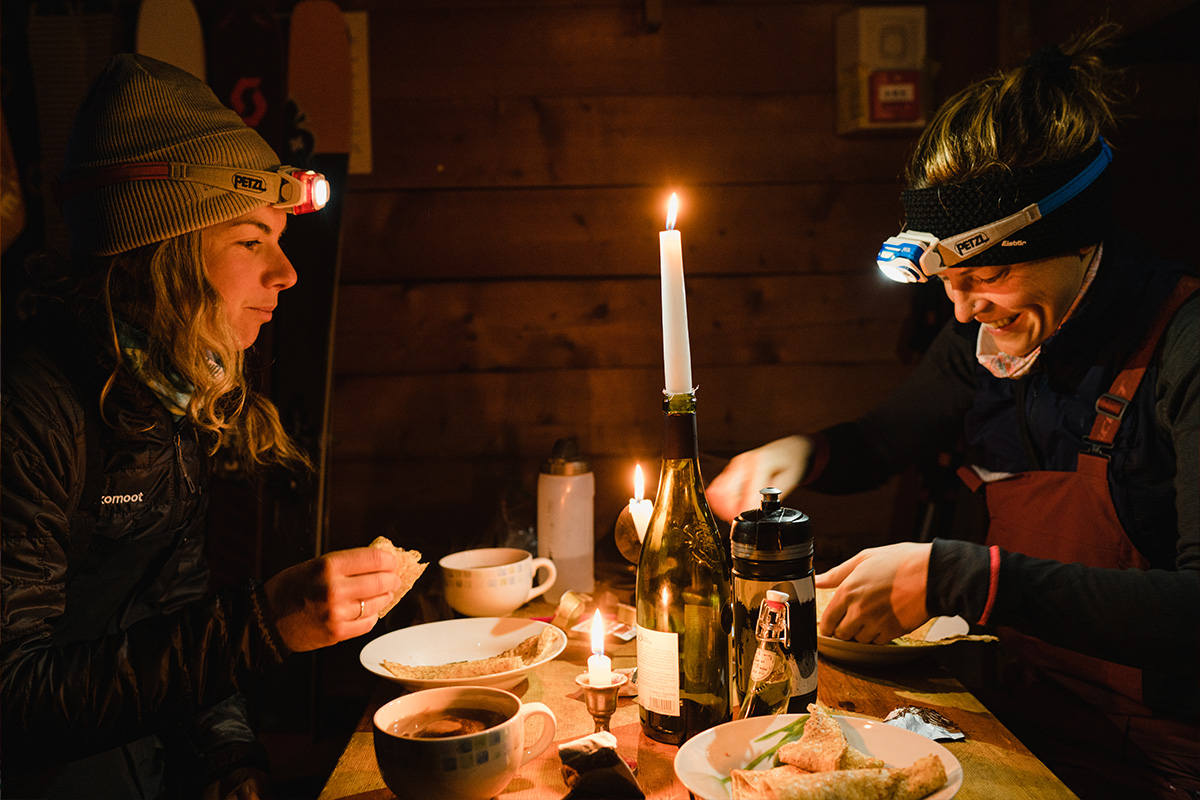

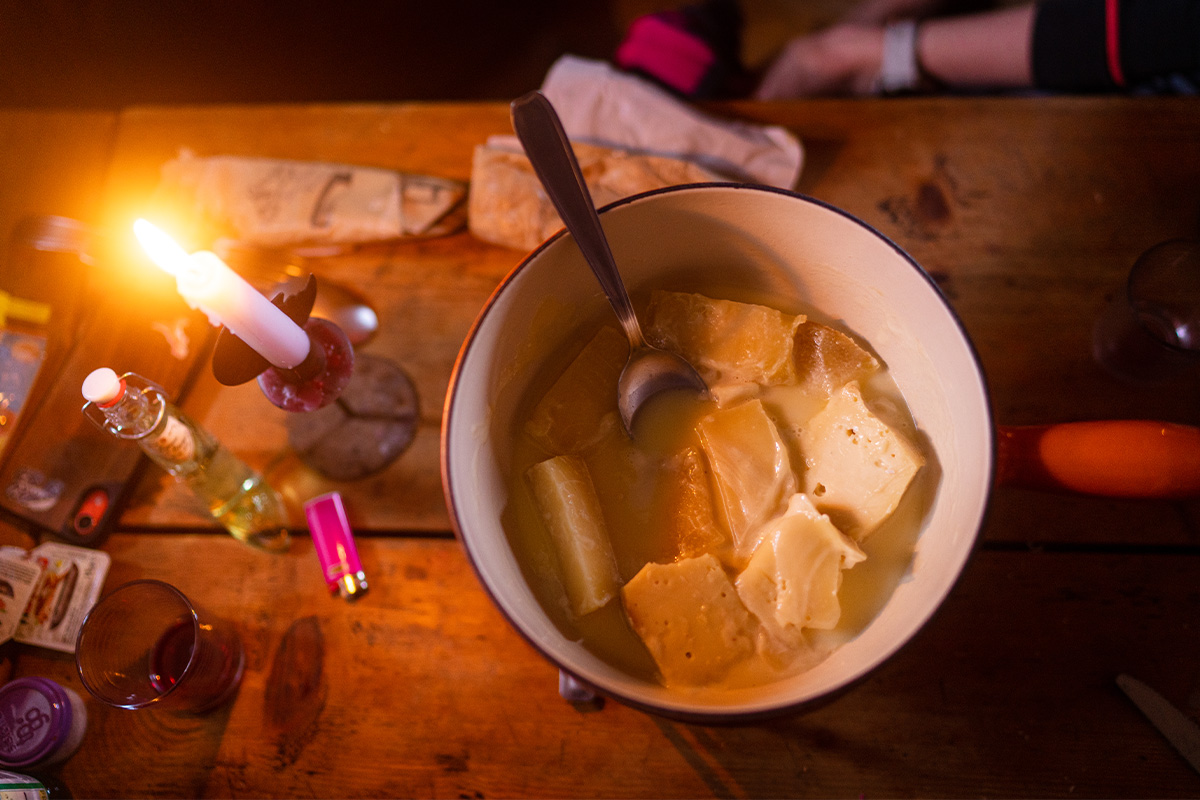
Day two started with getting all my clothes on to go to the toilet down the hill. It was a fresh and proper wake up!
Our goal was to go up and reach Point d’Arden’s 1960m peak, but as we woke up with not much visibility and still a lot of snow dumping, we didn’t know if we’d be able to make it all the way to the top.
We skinned our skis, put on our boots, and tackled what was to be an amazing adventure on the snow to the top. We passed trees, bushes, and even a snow-covered village mid-way through.
When the sky and fog cleared up, you could see the amazing, beautiful valley and some cliffs along the side; it really looked like a fairy-tale.
We had nearly reached the top of the peak, and doing some maths on timing and stuff (as if I was good at maths), a few meters before the summit, and due to a big fog cloud that had come in, we decided to drop our plan and head back down the mountain!
We, of course, went back by bike, and the switch from skis to bikes was fun, but hard, with our tired legs from the climb. Luckily, we had no more mega-storm, so the downhill was chill.
We celebrated with a little Génépy liqueur from a shoe glass bottle and a dance!
Sami’s Ski, Bike, Eat Fondue, and Repeat Route
Gaby’s and Bella’s trip memories
Quotes:
Gaby – It was fun answering questions from the surprised locals when we pulled up on bikes at the local bar in a snowstorm.
We went on a real mission to source local cheese and carry a lot of it up the mountain, then we found out Bella doesn’t really like fondue. 😂
But on a serious note, it felt really good to be able to go on a multisport adventure totally under our own power. It’s made me think twice about always jumping in the car to go skiing.
Bella – I just looked back at the messages to remind myself, they made me LOLLLLL….:
Sami’s dramatic, surprise crashes…
Laughing while we ate Swiss chocolates and drank red wine in our super cute hut while the snow fell.
And just how many straps we needed. Do you have a strap?!
Also laughing at when Sami’s mum saw a photo of me drinking the Génépi and thought it was young Sami 😂

Photo: SamiSauri Written by SamiSauri
Riders: @gabythompso @bella @samisauri
From the simplest game tracks to competition-worthy MTB courses, every trail has a story behind how it came be. And often, the areas around the routes we love to explore are equally rich with history, if you only know where to look.
That’s the idea behind ‘Trail Tales’ by Orbea, a multi-part video series that digs deep to unearth the untold sagas that surround us, one ride at a time. In their most recent release, Orbea riders Angus Hardie and Rory Skinner head to the northwest of Scotland to discover how mid-flight misfortune helped reshape the state of UK Mountain Rescue.
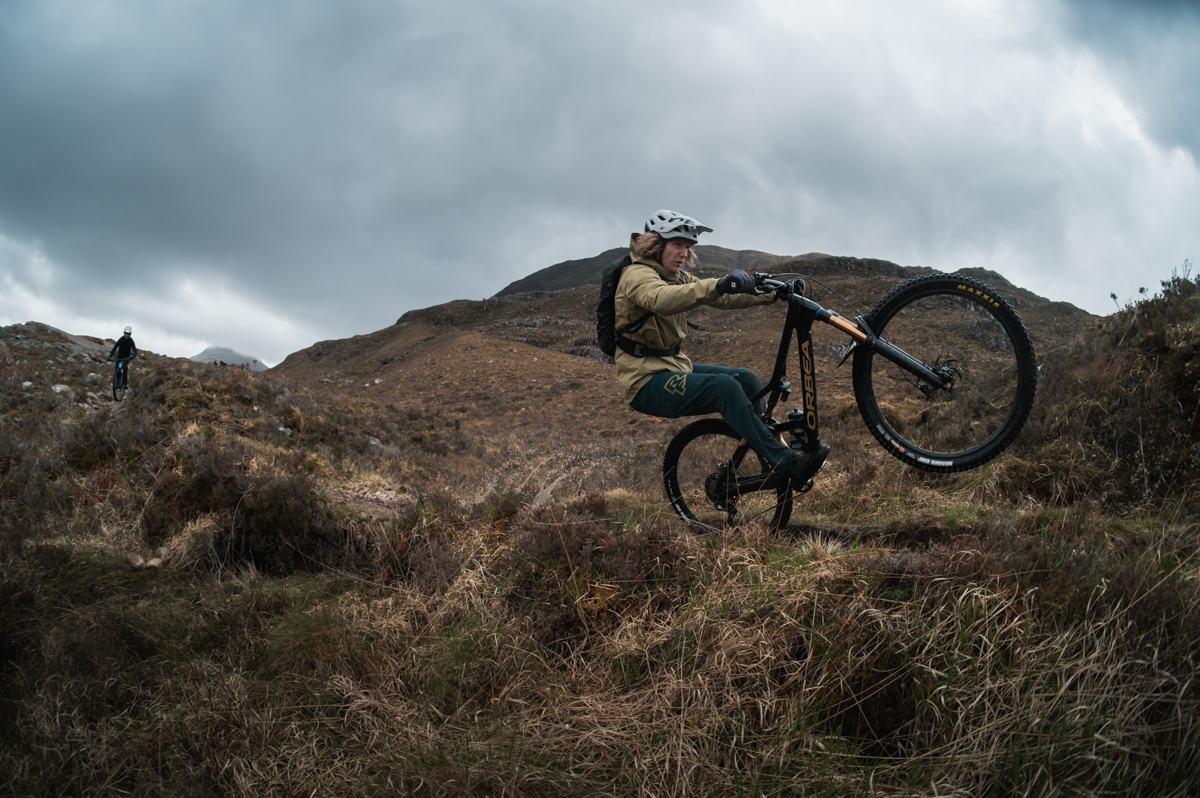
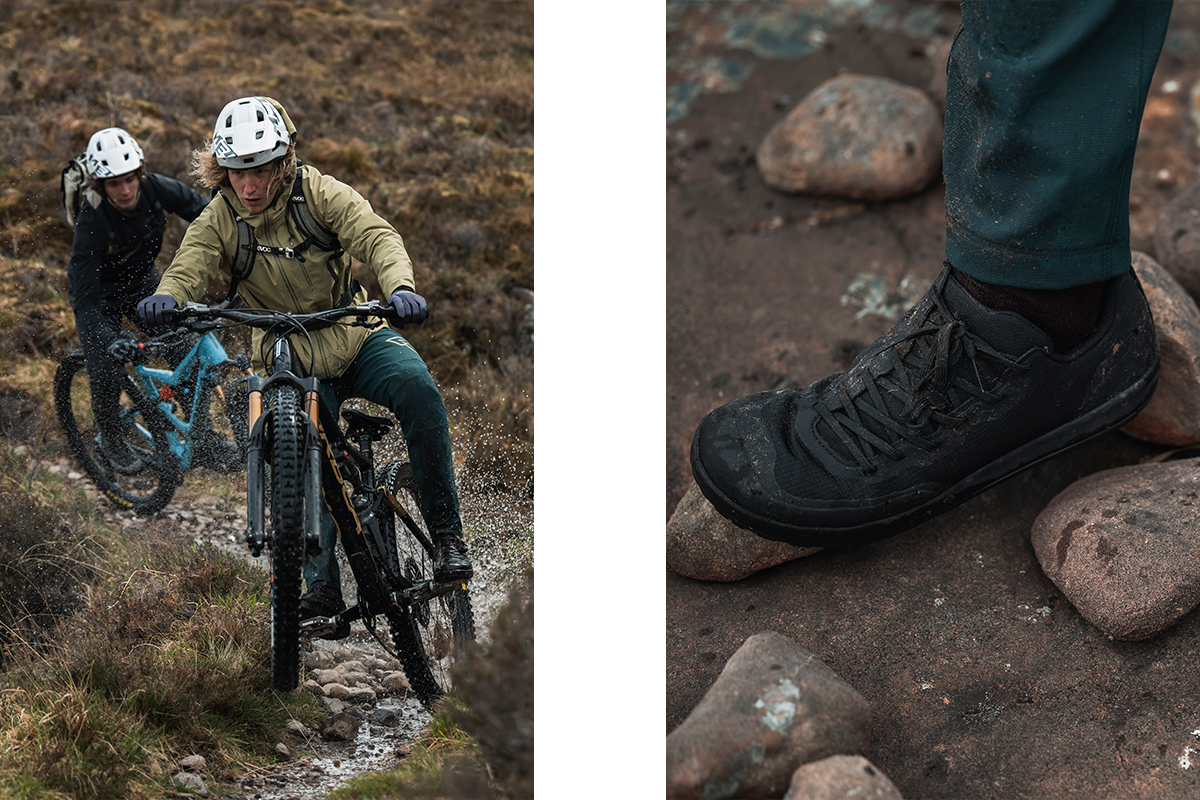
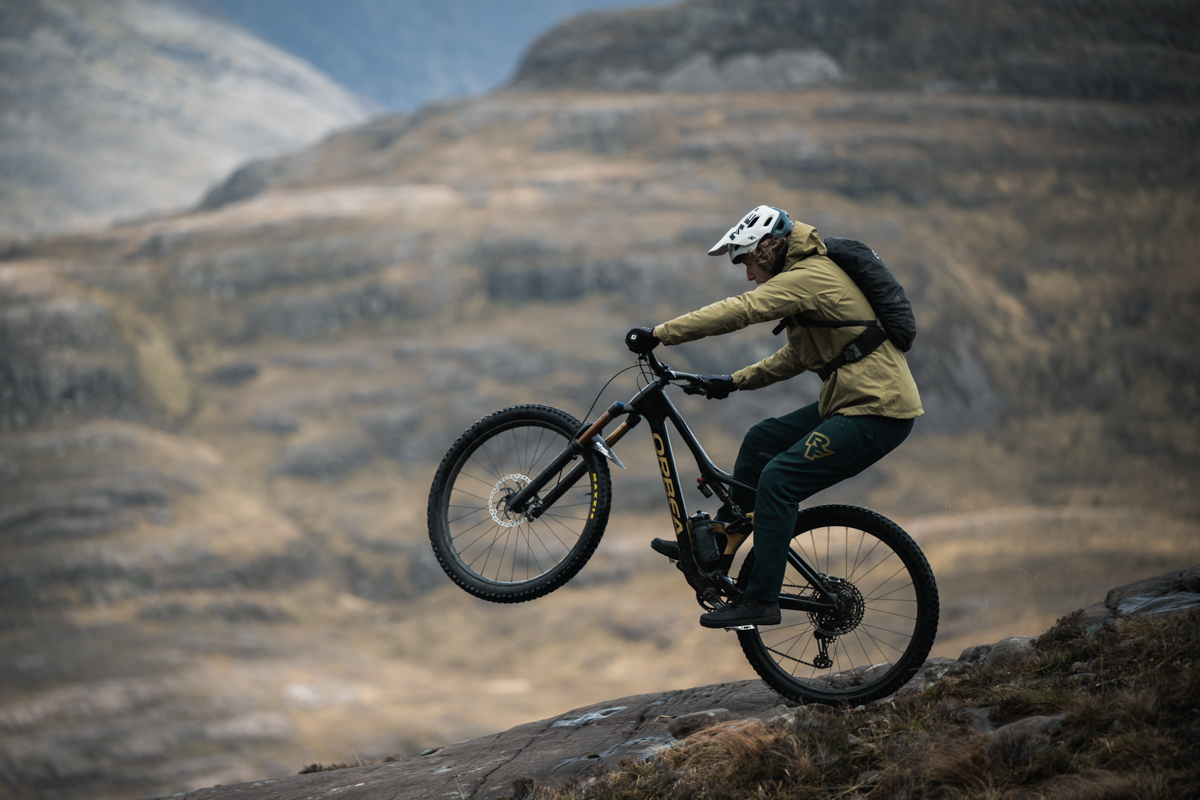
In episode 9, ‘The Last Flight’, Orbea take us back to the evening of March 14th, 1951, when a Royal Air Force mission went awry, resulting in a plane crash that cost the lives of eight young airmen high in the mountains above Torridon. The subsequent recovery efforts would take weeks to complete and would serve to highlight the importance of training and preparedness when attempting to overcome the harsh terrain of the Scottish Highlands.
Today, Scotland’s Torridon wilderness area serves as an outdoor enthusiast’s dream destination. Rugged, remote and beautiful, its jagged peaks and glacial valleys are crisscrossed by a network of hiking and biking trails which regularly draw visitors from around the world. Of course, Torridon is just as unpredictable now as ever, and those who choose to traverse Torridon, whether on two feet or two wheels, must be equipped for quickly shifting circumstances.
Doing so means having a solid plan for survival should things go sideways as well as the right gear from the start to ensure everything rolls smoothly. To keep pace during their time on the pedals in Torridon, Angus and Rory both complemented their Orbea Occam trail bikes with our Gravita Tensor Downhill MTB shoes, a versatile, performance pair that’s ready for all terrains and changing conditions underfoot.

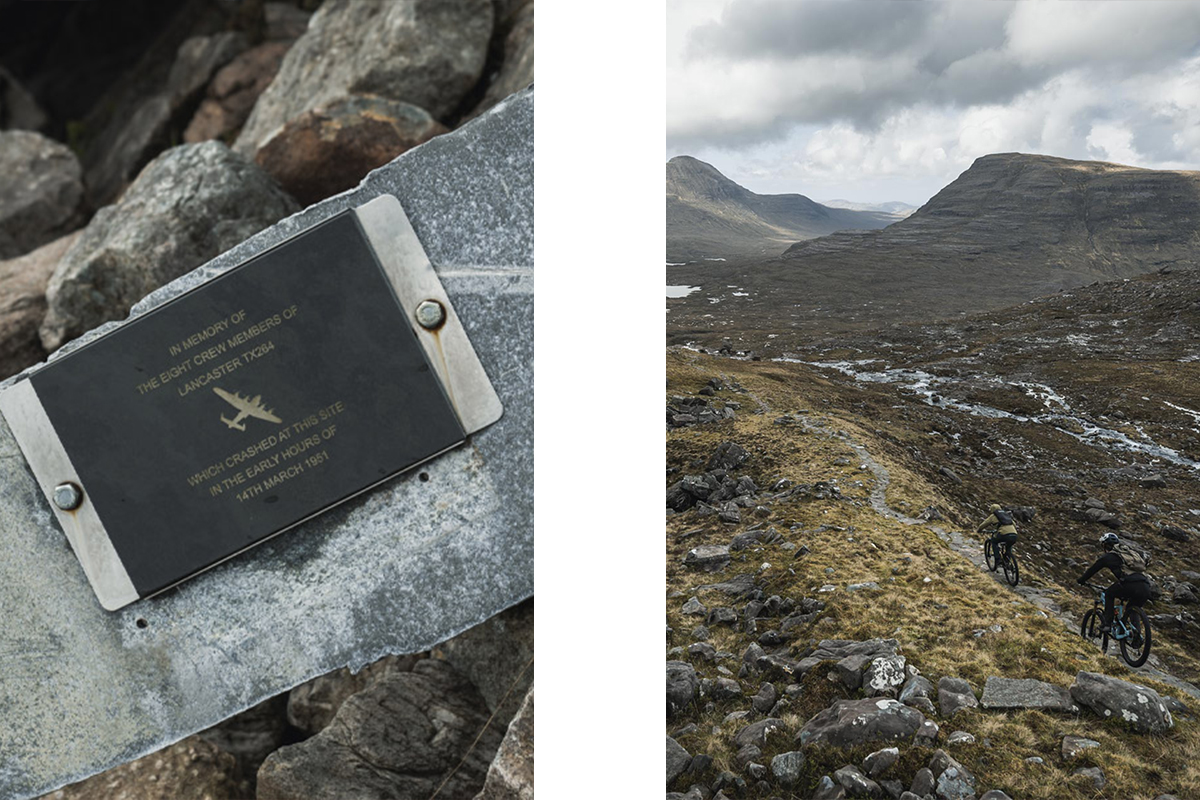
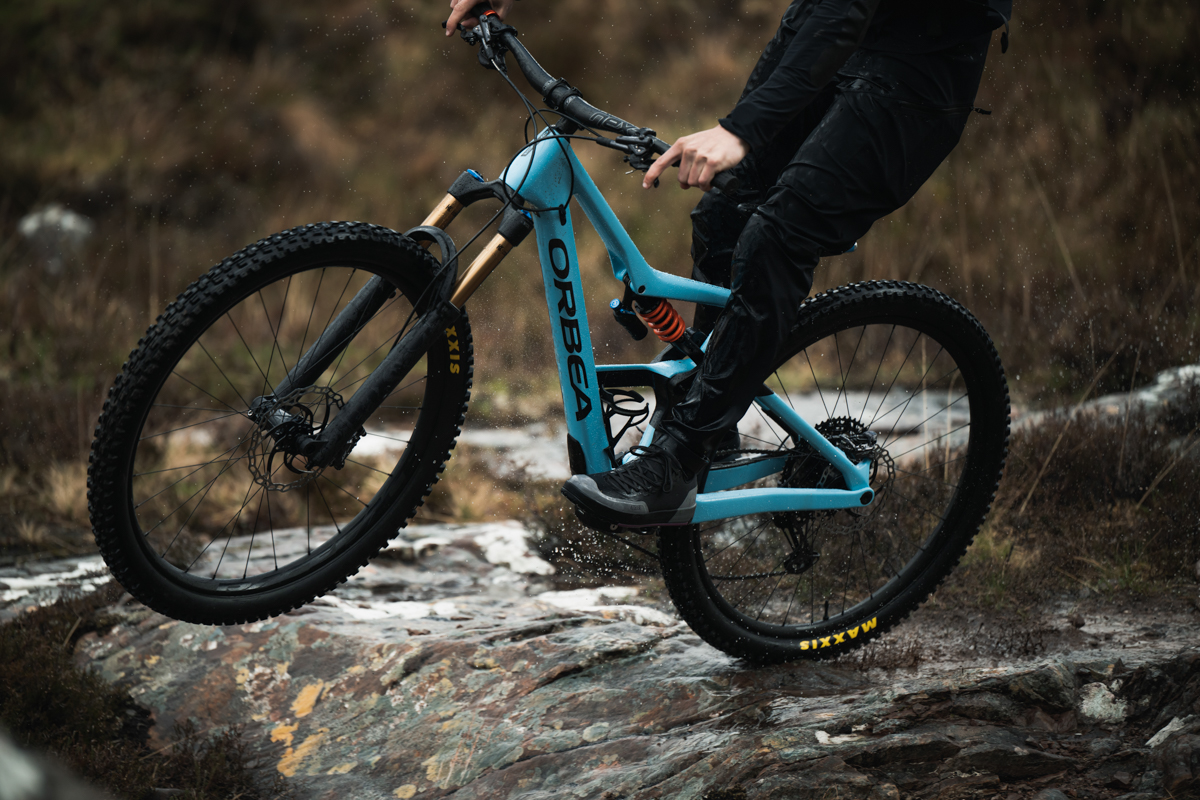
Project: Orbea Trail Trales
Riders: Angus Hardie and Rory Skinner
Movistar Team riders and super siblings Emma and Mathias Norsgaard know a thing or two about winter training. After all, cycling in their home country of Denmark means you either learn to embrace the cold or find a different sport. On a recent winter spin, Emma and Mathias put our new Artica GTX road shoes through their paces, chatting about cycling’s chilliest season along the way.
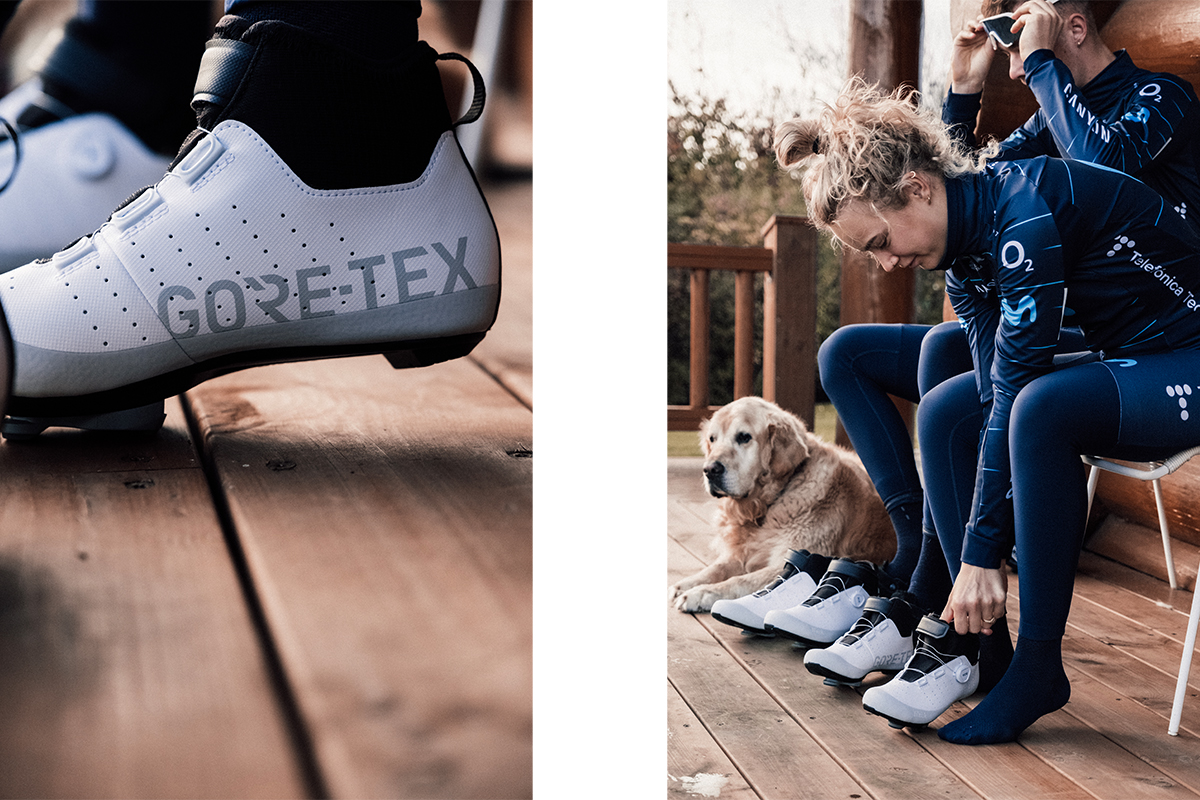
What’s your relationship with winter?
Mathias: The best thing about winter is you actually get to spend time at home. For me, it means I have to train in tough conditions sometimes, but how can you prepare for a wet Roubaix if you can’t even train in this weather?
Emma: For me, winter is the best time of the year because I get to spend so much time with my family, Mathias, and just spend some time here in Denmark and freeze a little bit. We sweat the whole year, so it’s super nice in the winter.
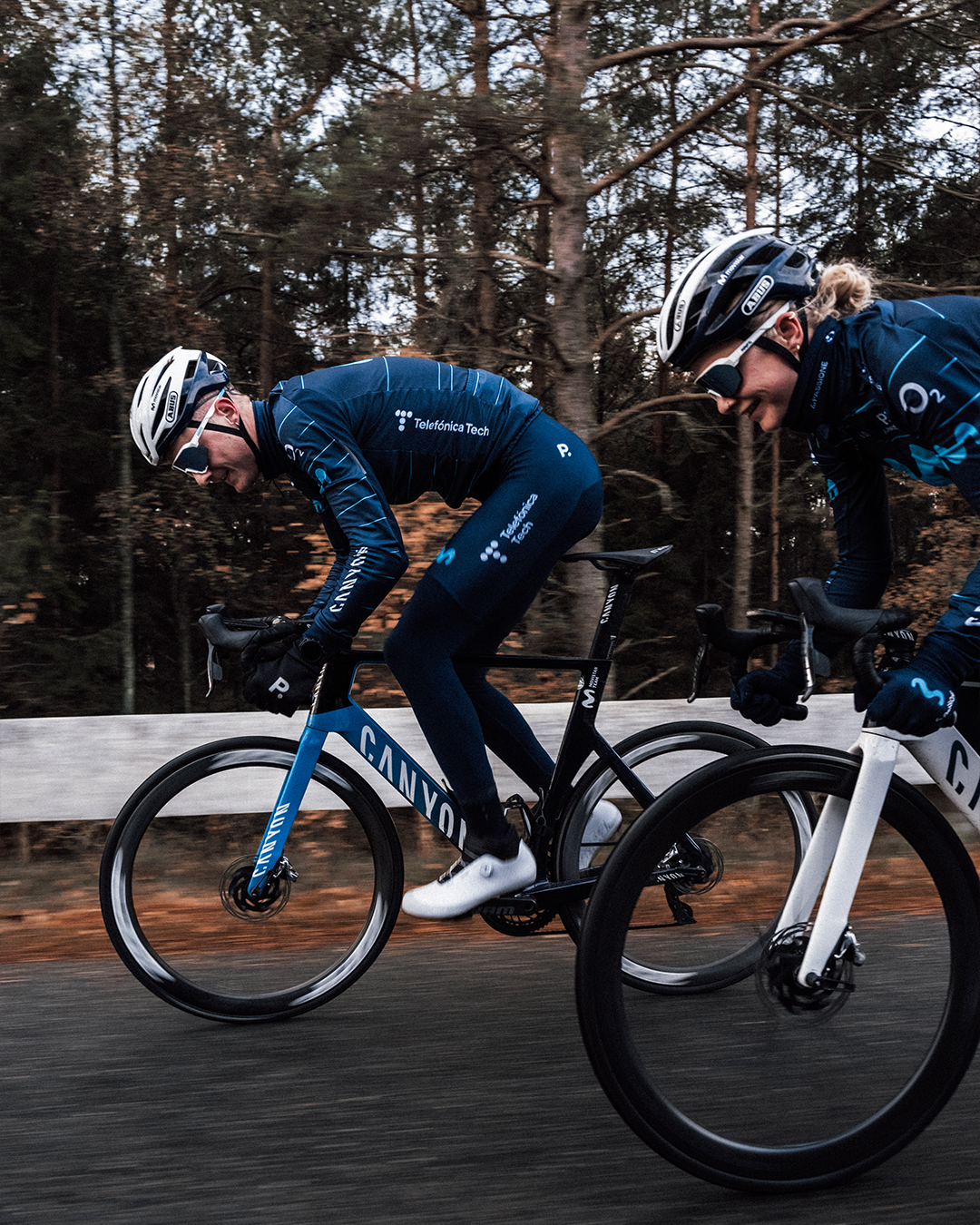
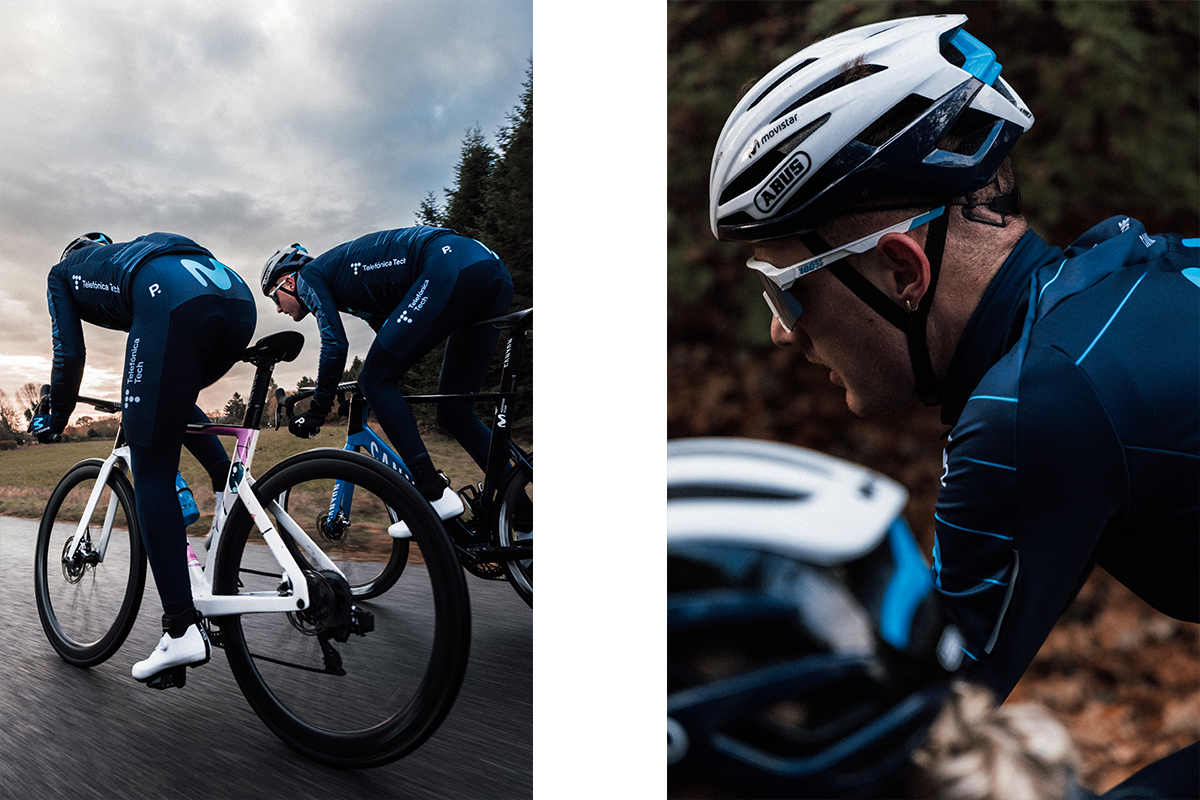
How do you prepare for a winter ride?
Emma: First of all: coffee. It’s important to get a good start to the day, and that’s of course with a hot cup of coffee. I like to wake up early in the winter when it’s still dark outside. That way, I have a lot of time in the morning to just relax and enjoy some Danish morning television.
Mathias: I always make sure to put on as many layers as possible, and I always have extra with me so I can put on another layer after a coffee stop. And if it’s really cold, I make sure to go super hard so that my body temperature rises.
What was your training like when you were a child during the winter in Denmark?
Mathias: When I was a kid, I remember we never really had the best winter clothing. On almost every Sunday ride in January and February, I would be crying when I came home because I was freezing. Sometimes I even changed clothing in the shower afterwards. But I loved it anyway, and I never sacrificed a ride because of the weather.
Emma: A core memory for me is winter training rides every Tuesday and Thursday evening with my dad. We always started the training at 17:00 when it was already completely dark outside. The best part was coming home to the smell of my mom’s dinner, freezing a little bit, so I would sit on the couch, tucked in a blanket, surrounded by my family with a really nice dinner.
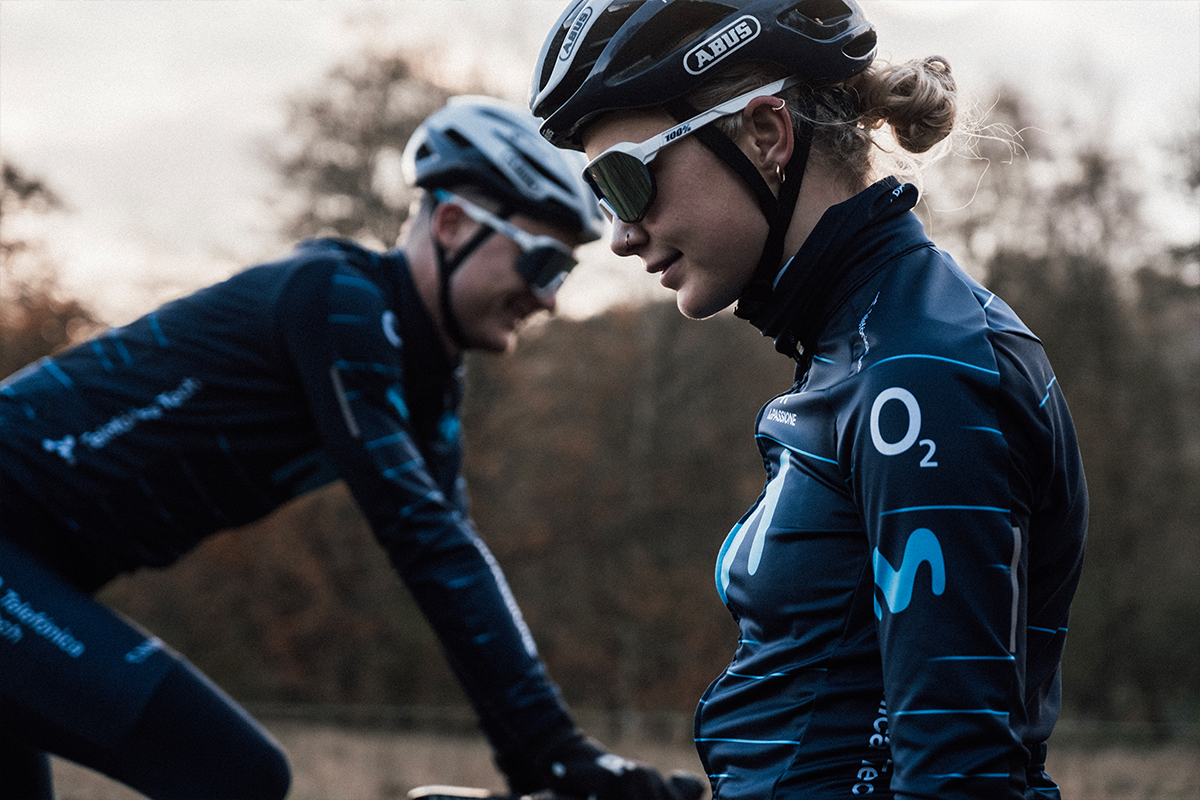
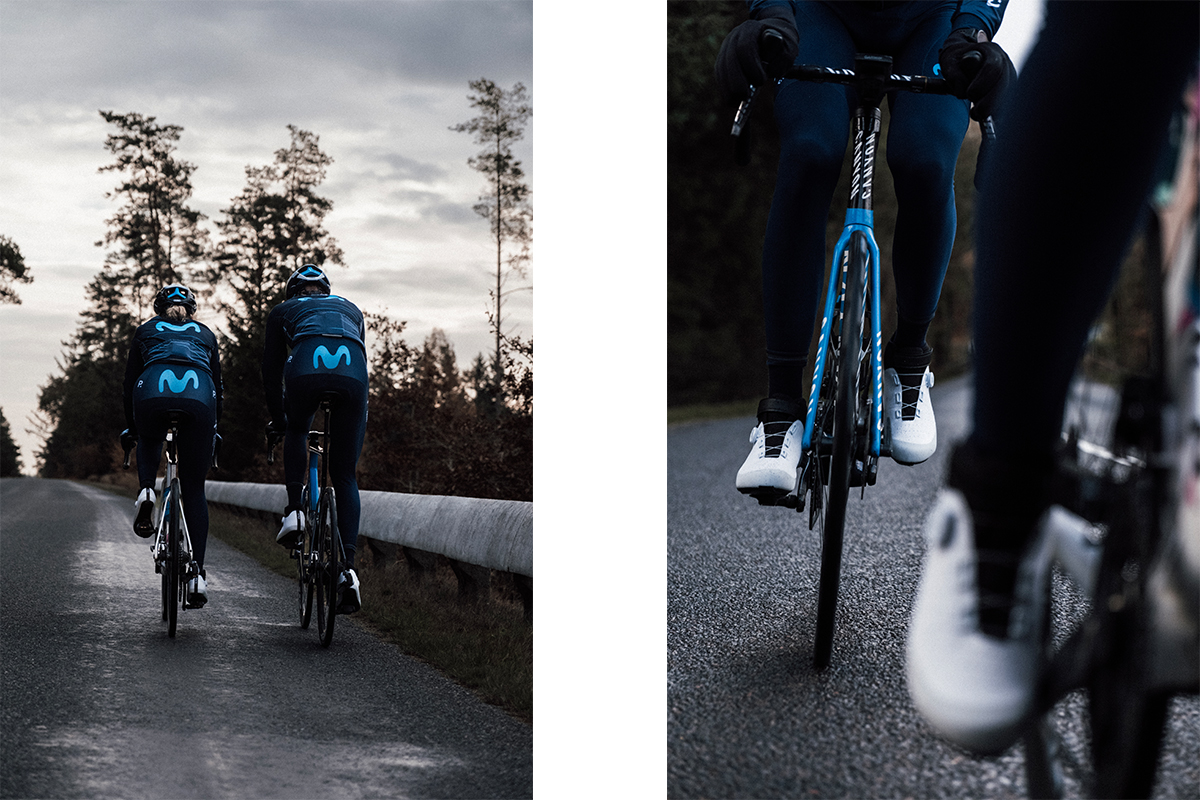
In Denmark and looking for a fun winter ride?
Riders – Emma and Mathias Norsgaard
Photo – Radcom
Equal parts rugged and refined, the Mediterranean island of Corsica blends picturesque seaside towns and pristine beaches with thick woodlands and jagged peaks, making it the ideal destination for a cycling holiday. Following the recent opening of La Grande Traversée, or GT20 for short, a 600-kilometer route across Corsica, Pol Tarres and friends flew to the island for exactly that: an unforgettable bike adventure in an unbelievable locale. Read on to enjoy their experience.
A NEW WAY TO ROLL
We wanted a challenge, a challenge in which we not only had to pedal but also enjoy new landscapes and, as always, soak up the culture and enjoy the gastronomy of the places where we go. We had always had Corsica in our sights and now, with the recent launch of the GT20, it was the perfect time to do this adventure. We have always thought that the islands have a different “something” that attracts us a lot, we like to pose and do adventures, in this case, we crossed Corsica from north to south in 5 days.
Whether you are an expert or you are just starting out in cycling, Corsica is your destination to practice your passion and the GT20 “la Grande Traversée”, the new 600km cycling route with a +9,500m that crosses the Island of Beauty from the north to south, starting in Bastia and ending in Bonifacio. You will be able to see the impressive landscapes and at the same time the amazing contrasts of sea and mountains that the island has, cross the authentic inland villages, discover the cultural heritage and taste local products such as wine, honey, the “brocciu” (goat and sheep milk cheese) and olive oil among others.
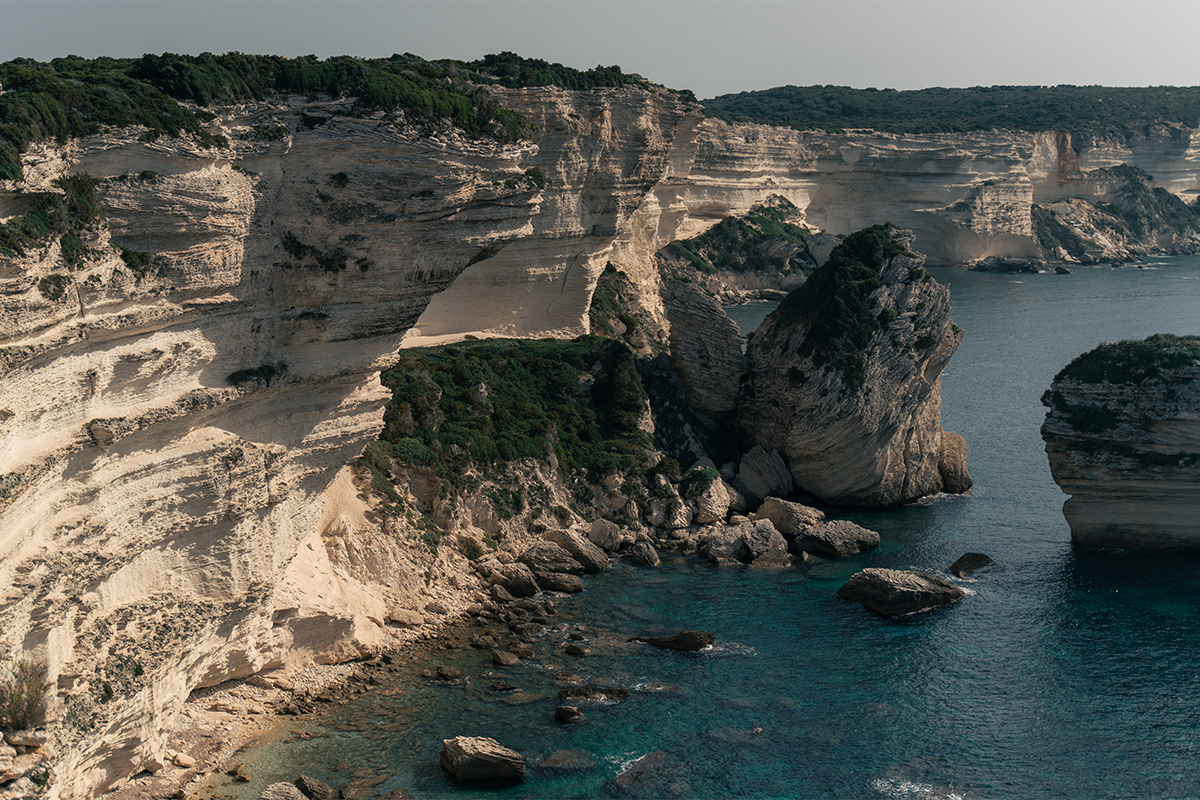
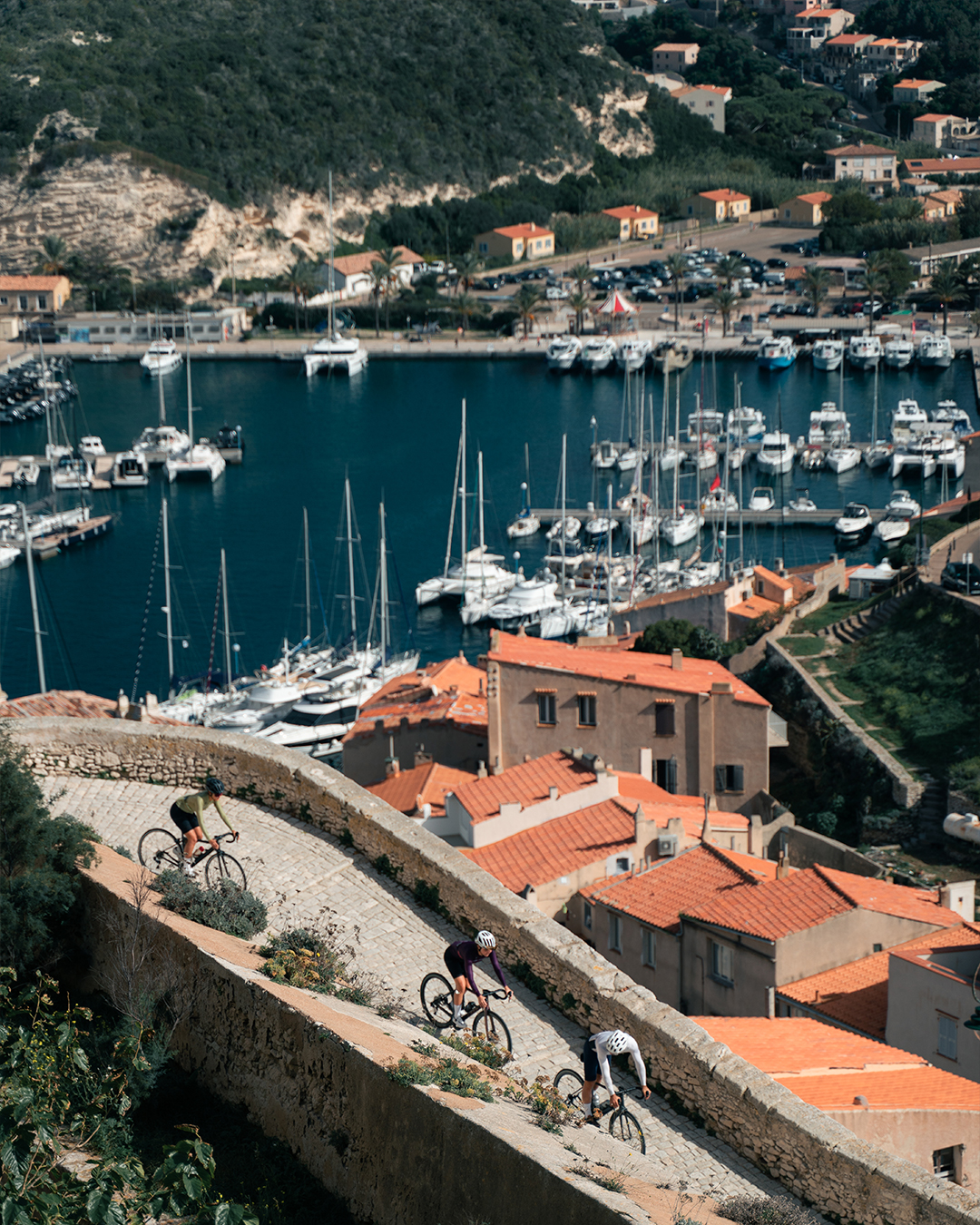
The GT20 is accessible to everyone, with any type of bicycle, and, although it is designed to do 12 stages, the most ambitious cyclists will be able to do it in less, it is an open route and eachone can adapt it to their tastes and needs.
THE COLORS OF CORSICA
Every day our perception of the island changed: before going we thought that there were only white sand beaches, turquoise blue and transparent water. And it was not like that at all. In the first GT20 part, in Cap Corse, we rode along the coast with roads touching the sea, passing through fishing villages and cliffside villages. We pass by the Molino Mattei viewpoint where you can see the west side of Cap Corse.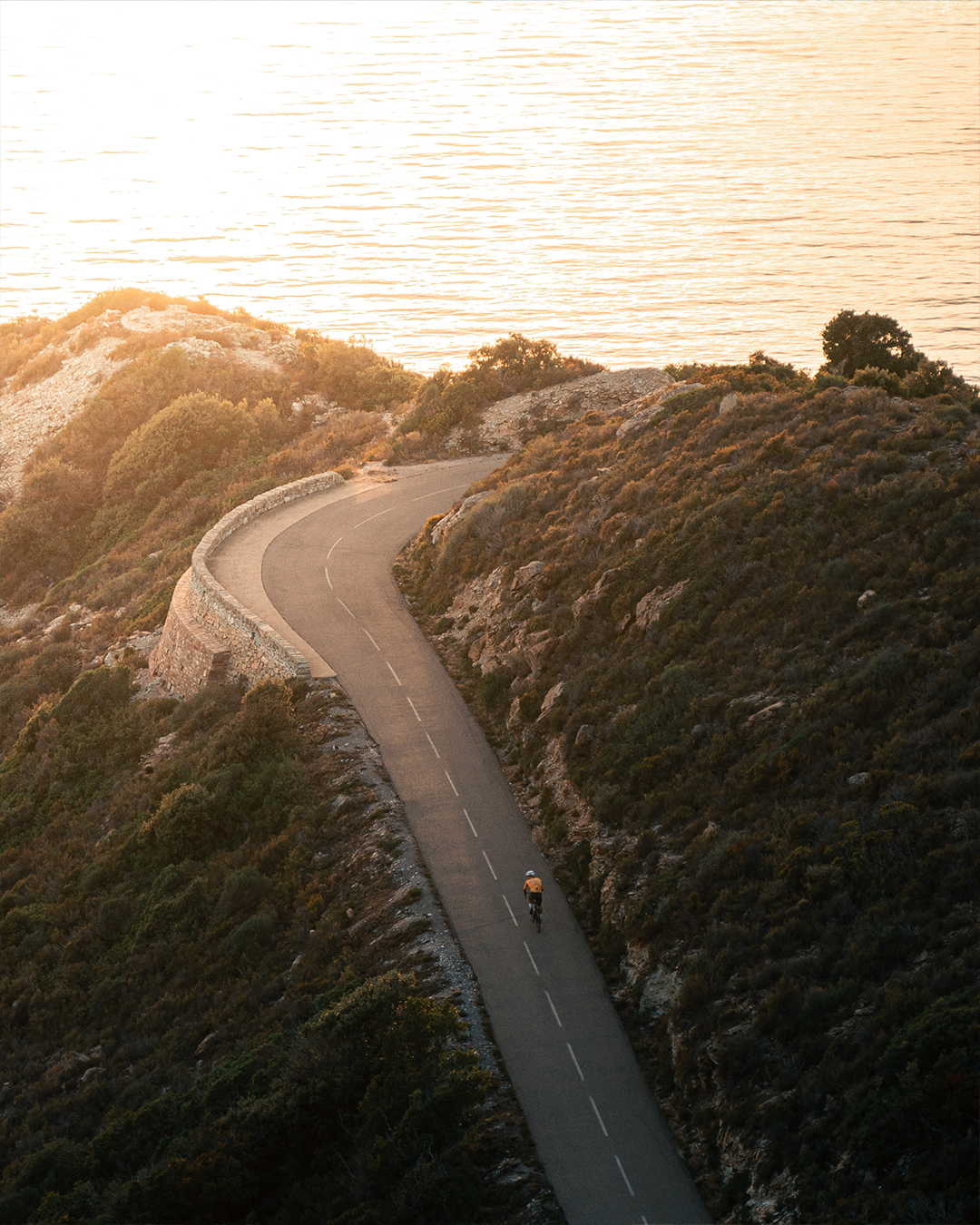
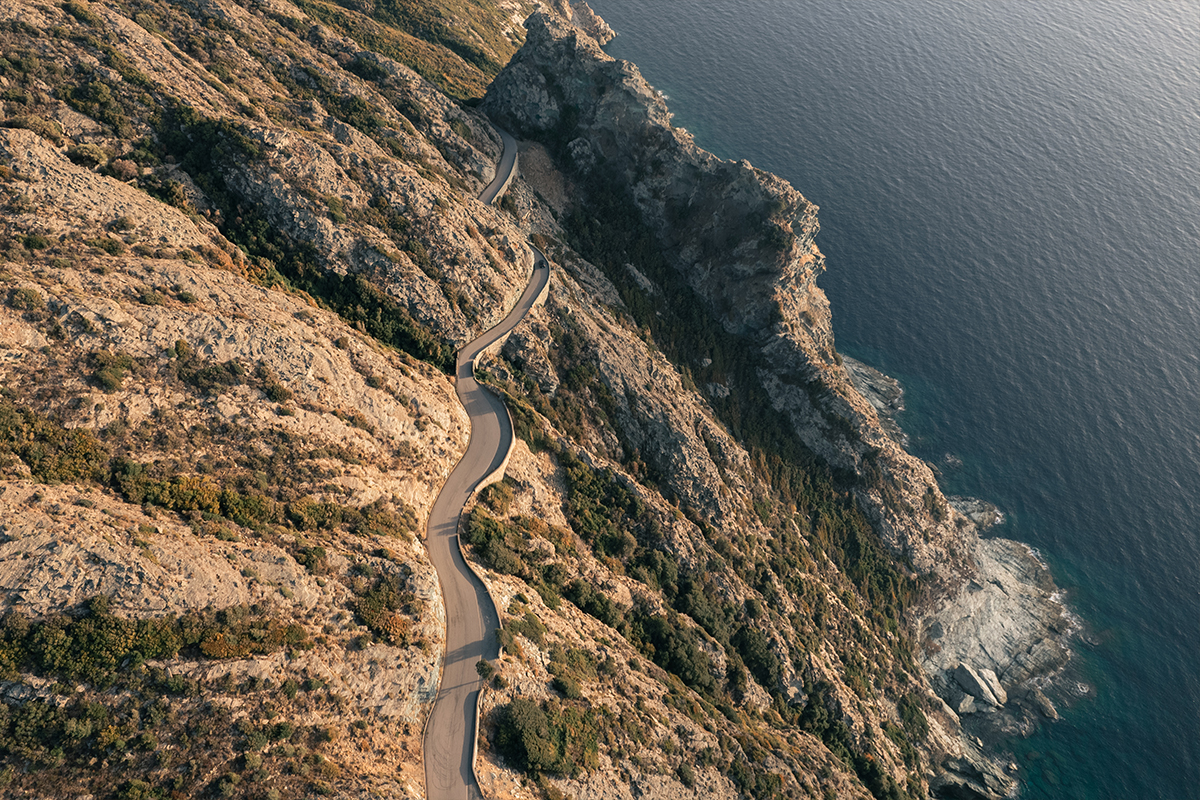
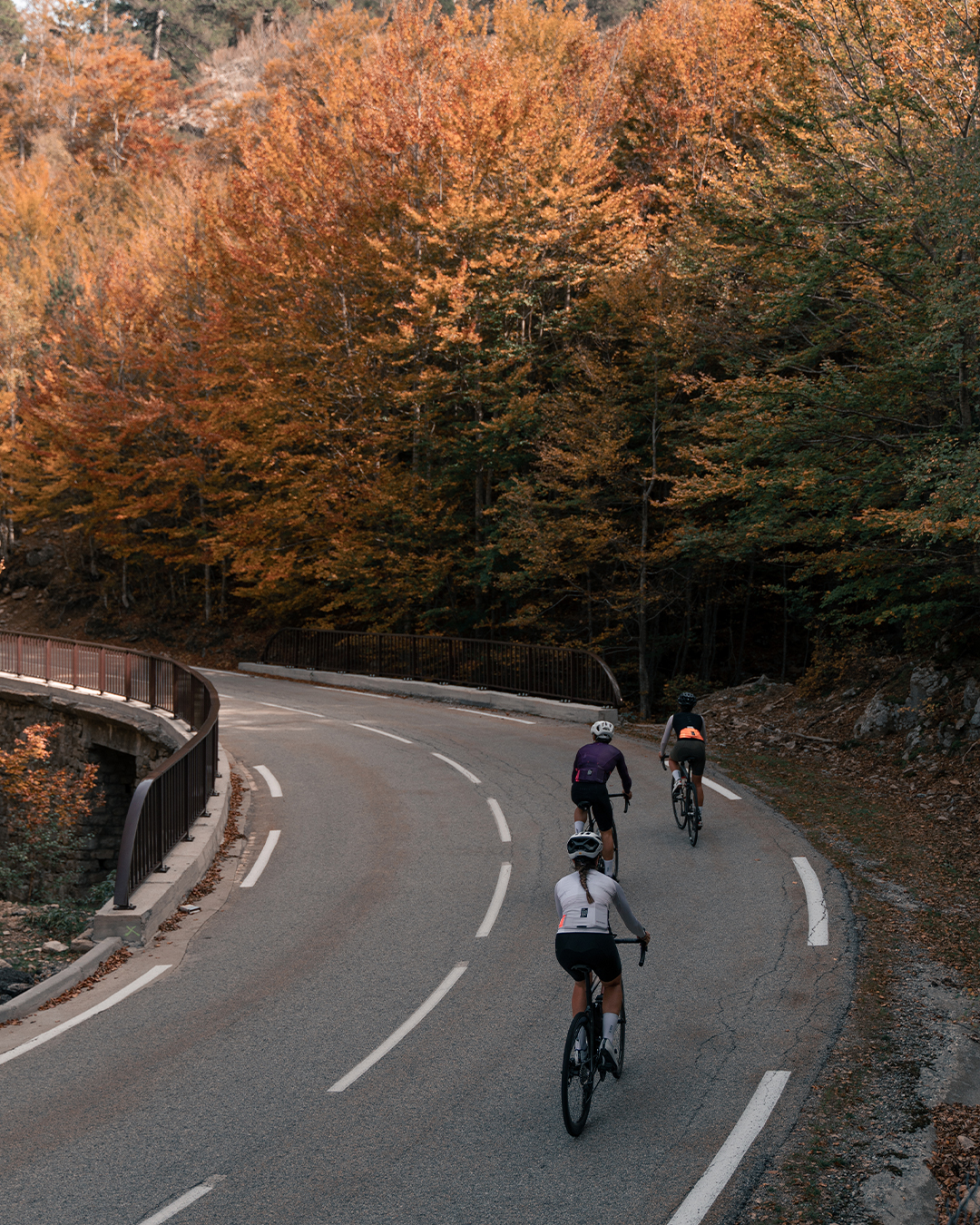
From there, you kept seeing the sea but from the height of the cliffs to the town of Saint-Florent. After going around around Cap Corse you enter the interior of the Balagne, an area where you can enjoy small towns with a lot of history and full of GT20 – CORSICA artisans that the route goes through. In the last part of this area, before reaching Porto and Piana, the GT20 goes along a road that goes up and down enjoying the views of the Gulf of Porto, the Capo Rosso and the “ Calanches de Piana”, a UNESCO world heritage site, where the next day we would go on a boat trip to see it up close.From this point the GT20 enters the island and we would only see the sea at some points but in the distance. On the third day we faced the longest and hardest climb of the entire route, Porto Vergio, 32km and +1450m, passing through areas that reminded us of landscapes from Avatar,to reach the final part, where autumn was imposed, dyeing the landscape of yellows, oranges and browns. From there we descended to the Niolo region along a fast and fun road, to end up in a gorge of granite rocks with ocher tones that reminded us a lot of Morocco.
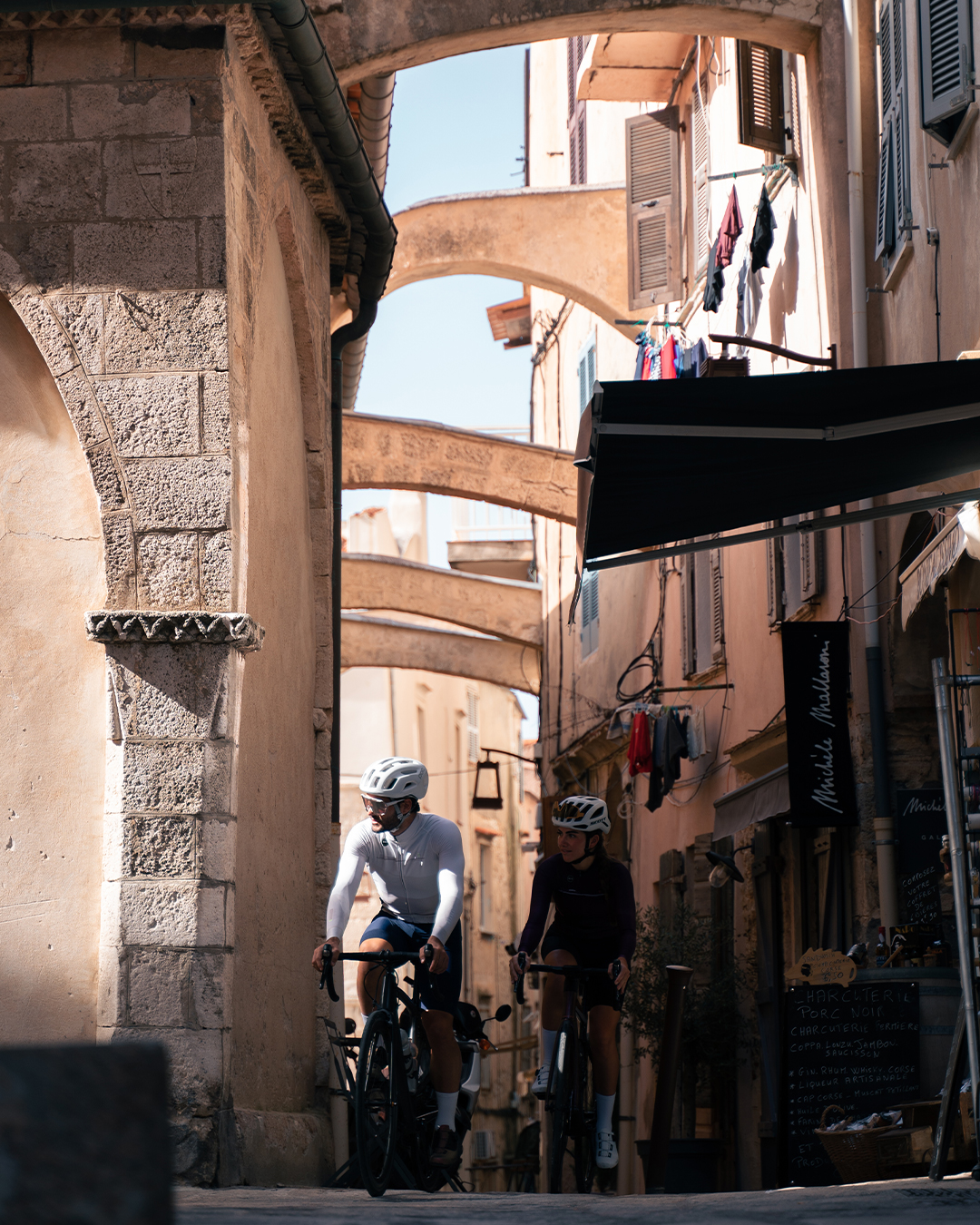
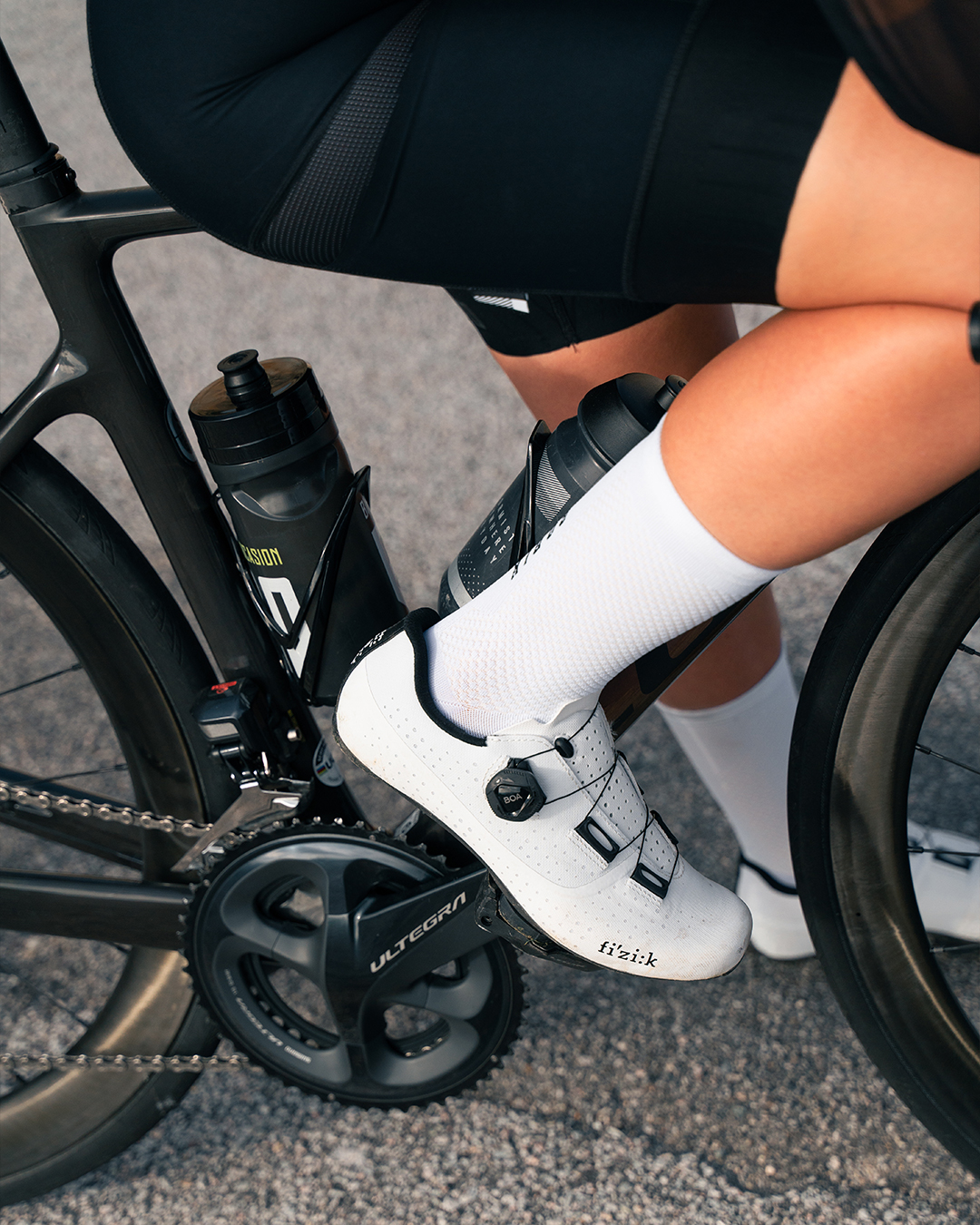
COSTAL MOUNTAINS AND TOWNS
In the 4 stage we were surrounded by mountains, we crossed the Regional Natural Park of Corsica, the Marmanu forest, and passed through inland villages such as Corte, Zicavo or Zonza, from which you can have a spectacular view of the Incudine mountain massif ( 2,134m ).
On the last day we rode over the mountain pass of Col de Bacino, the last of the GT20, to descend to Sotta and finish the route in Bonifacio: a beautiful town hanging on some white cliffs, preserving the medieval atmosphere of when it was founded, it is an essential town to visit and an unbeatable point to finish the route.
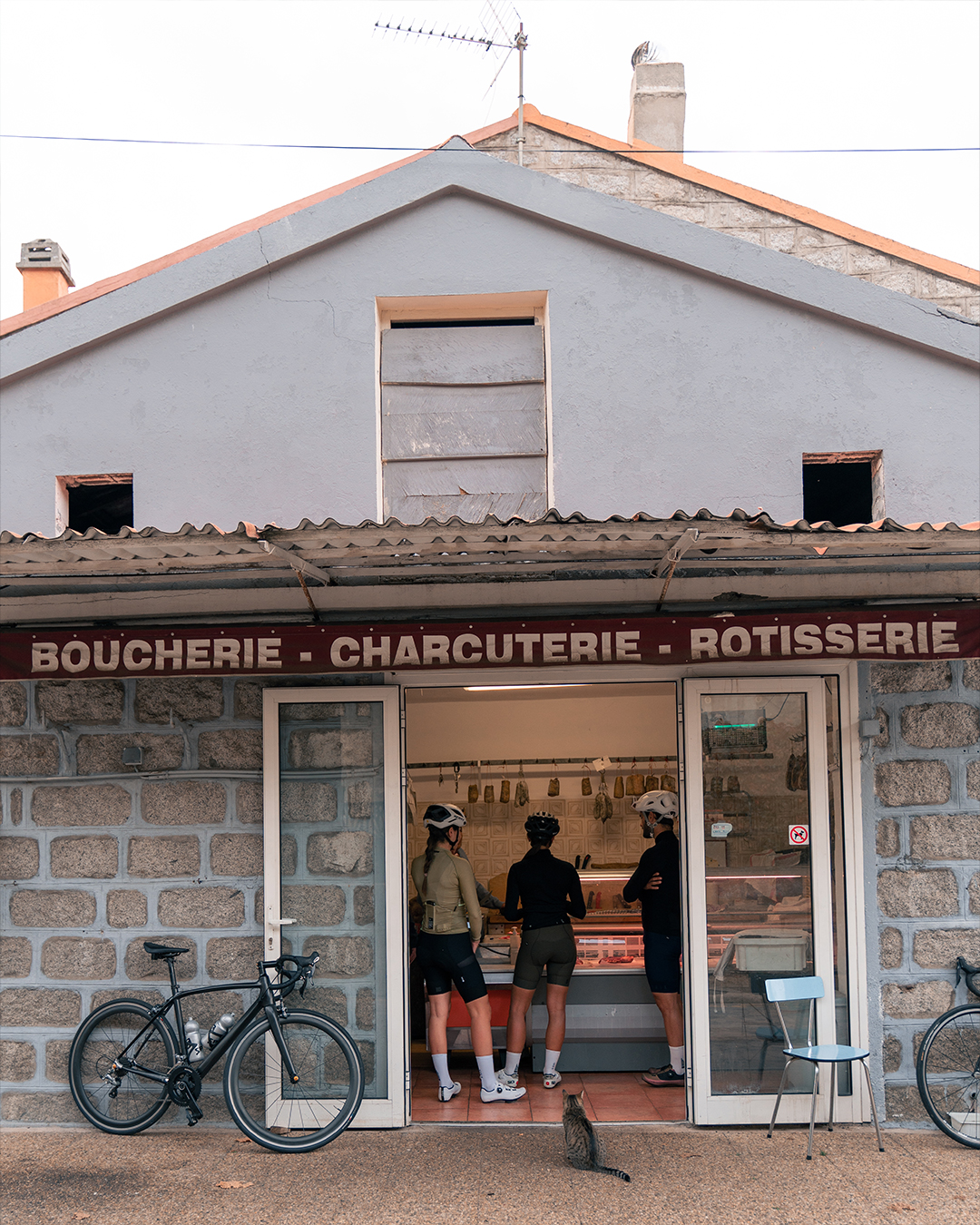
A ROUTE FOR ALL RIDERS
During the days we were there, we came across “bikepackers”, cyclists with ebikes, road, mountain bikes, and even city bikes, and they were all following the GT20. The GT20 runs largely on secondary roads to be able to not only enjoy quiet and safe cycling, but also the landscapes without losing any comfort: accommodation to sleep, restaurants to eat, and museums and historical heritage to visit, which is great for a few days of sightseeing by bike without missing out on everything the island has to offer. The entire route is marked with signs at all the intersections with which it is very easy to follow the route without getting lost at any point, so the GPS is not even necessary, it is very convenient.
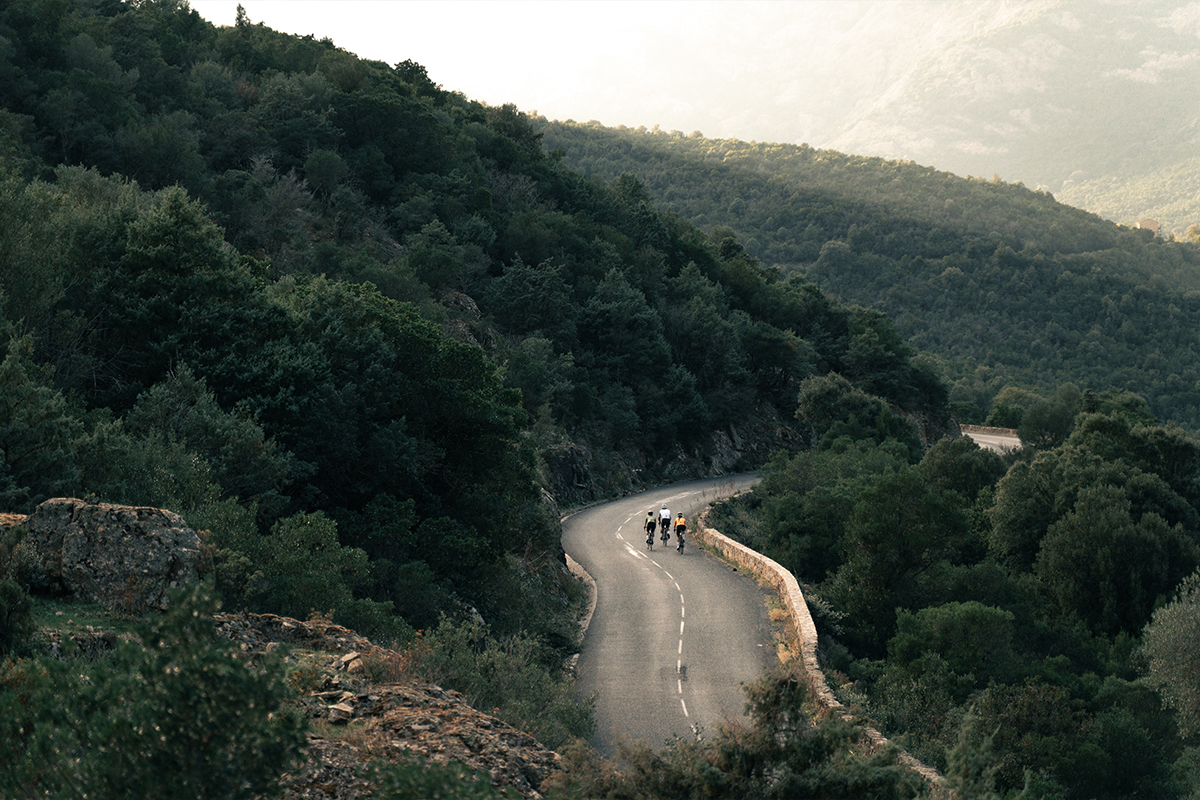
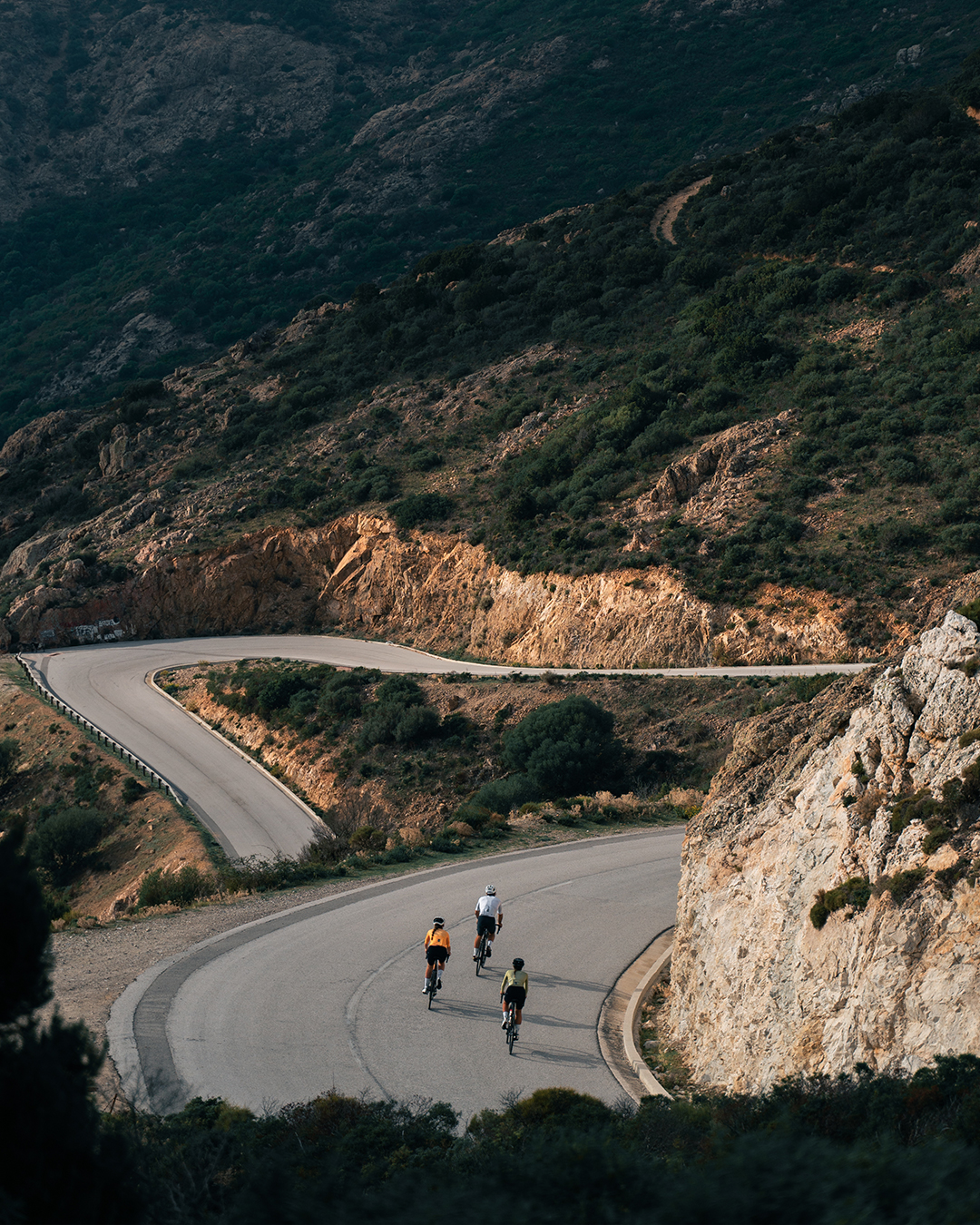
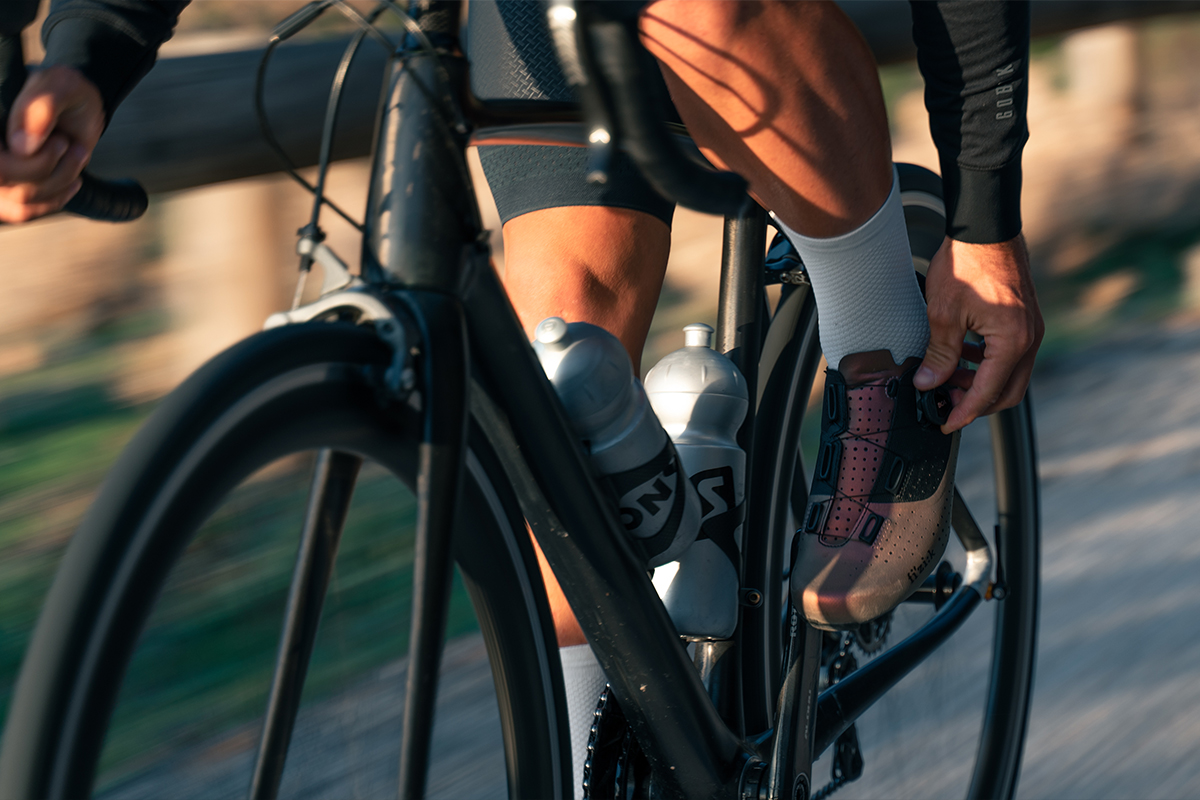
One of the things we appreciated the most was time. Corsica is a destination that can be enjoyed all year round, and for cyclists the seasons of spring and autumn are great. During the first and last hours of the day it cools down a bit and then, with the sunrise, temperatures remain between 20 and 26º, perfect for practicing sports. In addition, at this time you can enjoy the island with fewer tourists and fewer cars.


Production – ApperStudio apperstudio.com
Riders – Pol Tarrés poltarres.com
Mire Simó miresimo
Suzie Marachet suziemarachet
Transmadeira is a one-of-a-kind mountain bike race held on the small Portuguese island of Madeira in the middle of the Atlantic Ocean. For fifteen years, the event has welcomed adventurous visitors to compete on world-class trails for five days of racing across a course that covers nearly every part of this picturesque rider’s paradise. Last month, Marcelo Gutierrez joined Transmadeira, and he shares his experience below.
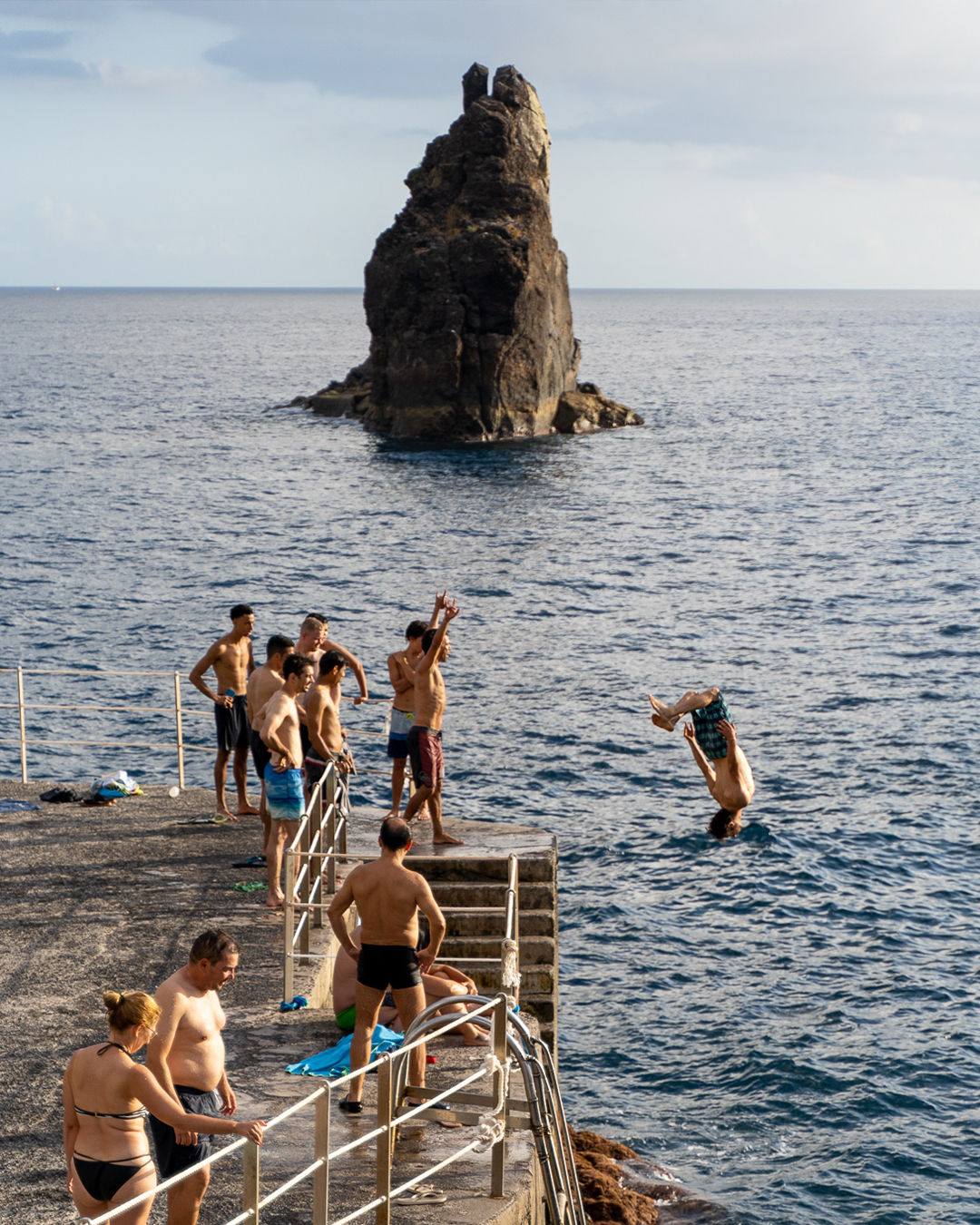
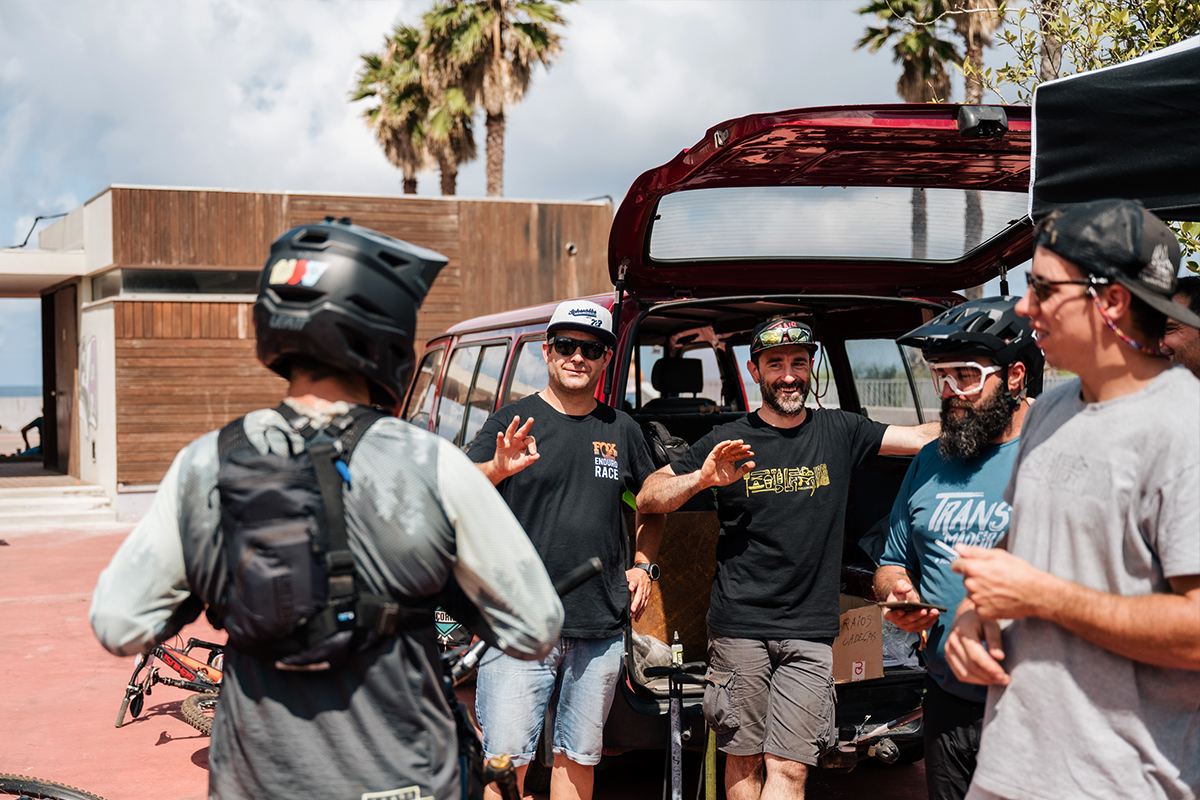
Almost 24 hours of moving time, almost 10K meters gain, and almost 250km in 5 days of riding and over 140 riders, THAT’S EPIC!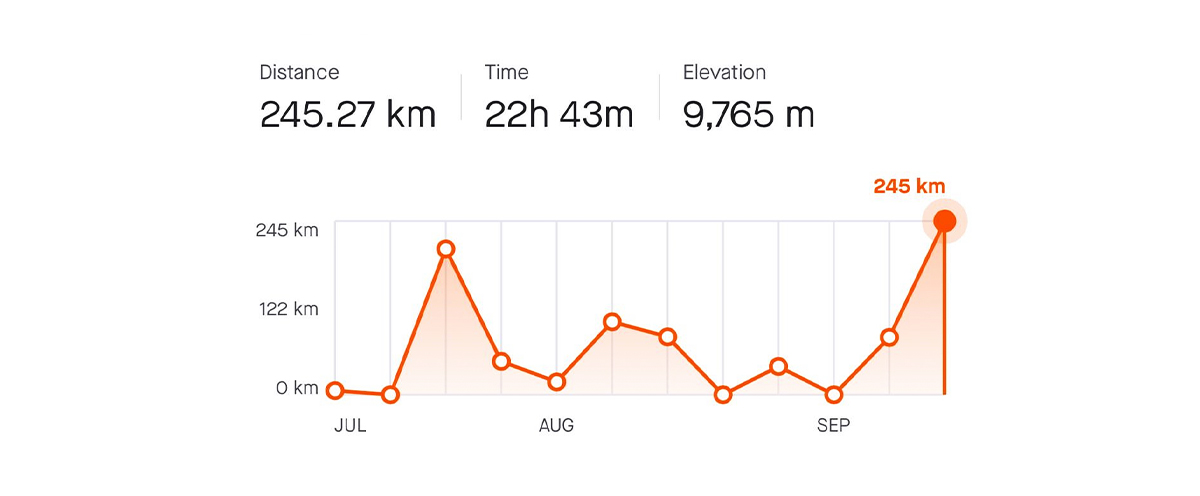
TransMadeira 2022 was an experience that I wont ever forget and better than that, a dream come true. 3 years ago that I stopped my racing carreer and decided to go and tick the boxes of those places and advenutres that I have wanted to do for a while, so I am so glad and grateful that have finally made it to Madeira and even better than that, have finished on 2nd place on this magical adventure.
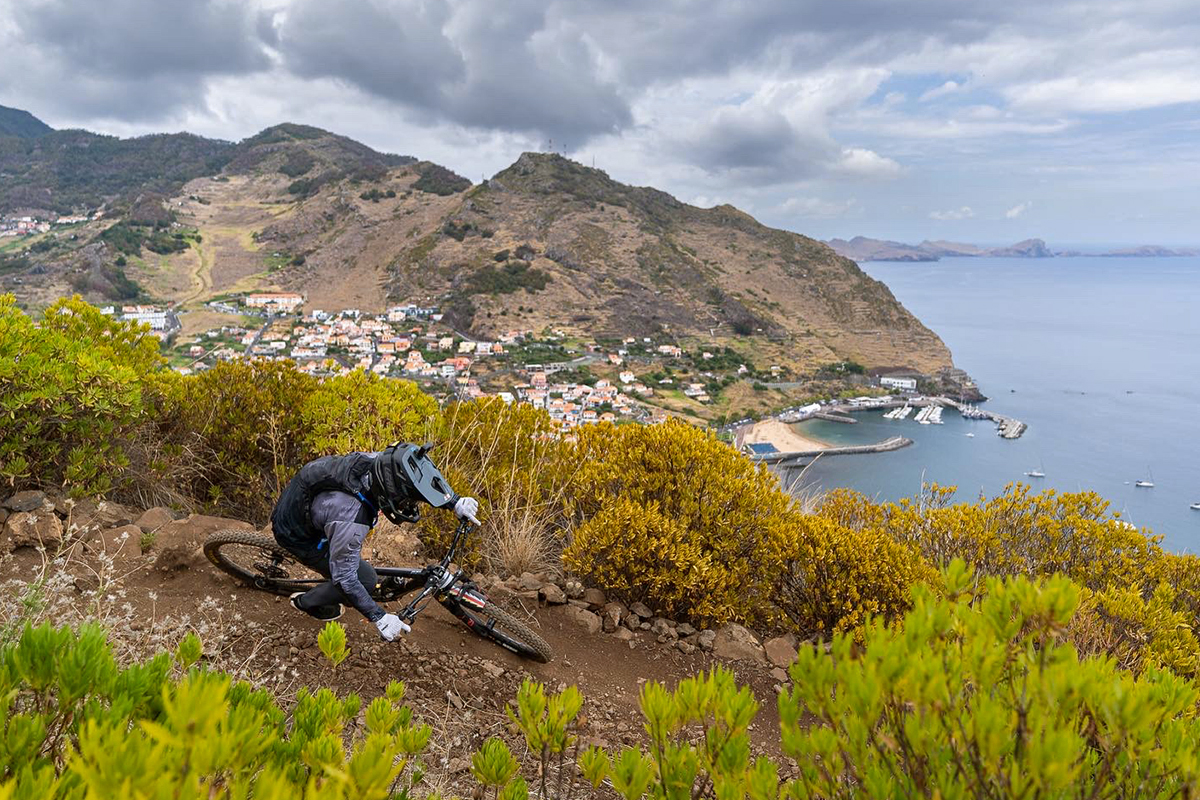 A five days event is definitely a challenge not only physicaly but mentaly. One thing is to race 1 track on a dowhill race, one things is to race an enduro race where you might have 5/7 stages that you sort of have an idea of what’s coming and it’ll be for one day or max two days, but a whole different game is to race BLIND 30 tracks in all sort of different conditions for 5 days in a row.
A five days event is definitely a challenge not only physicaly but mentaly. One thing is to race 1 track on a dowhill race, one things is to race an enduro race where you might have 5/7 stages that you sort of have an idea of what’s coming and it’ll be for one day or max two days, but a whole different game is to race BLIND 30 tracks in all sort of different conditions for 5 days in a row.

 It was a constant battle between my racing self and my new mindset… Of course you are on a race, but at the same time there are some rad flowy sections and some insane views that almost make you want to stop and repeat or simply enjoy the view. But well! I belive I won the internal battle and manage to enjoy every single stage, give my 100% make tons of new friends, manage to ride clean and steady so I could keep the bike in good shape for 5 days and also being aware of my own energy so I could attack each day as hard as I could.
It was a constant battle between my racing self and my new mindset… Of course you are on a race, but at the same time there are some rad flowy sections and some insane views that almost make you want to stop and repeat or simply enjoy the view. But well! I belive I won the internal battle and manage to enjoy every single stage, give my 100% make tons of new friends, manage to ride clean and steady so I could keep the bike in good shape for 5 days and also being aware of my own energy so I could attack each day as hard as I could.
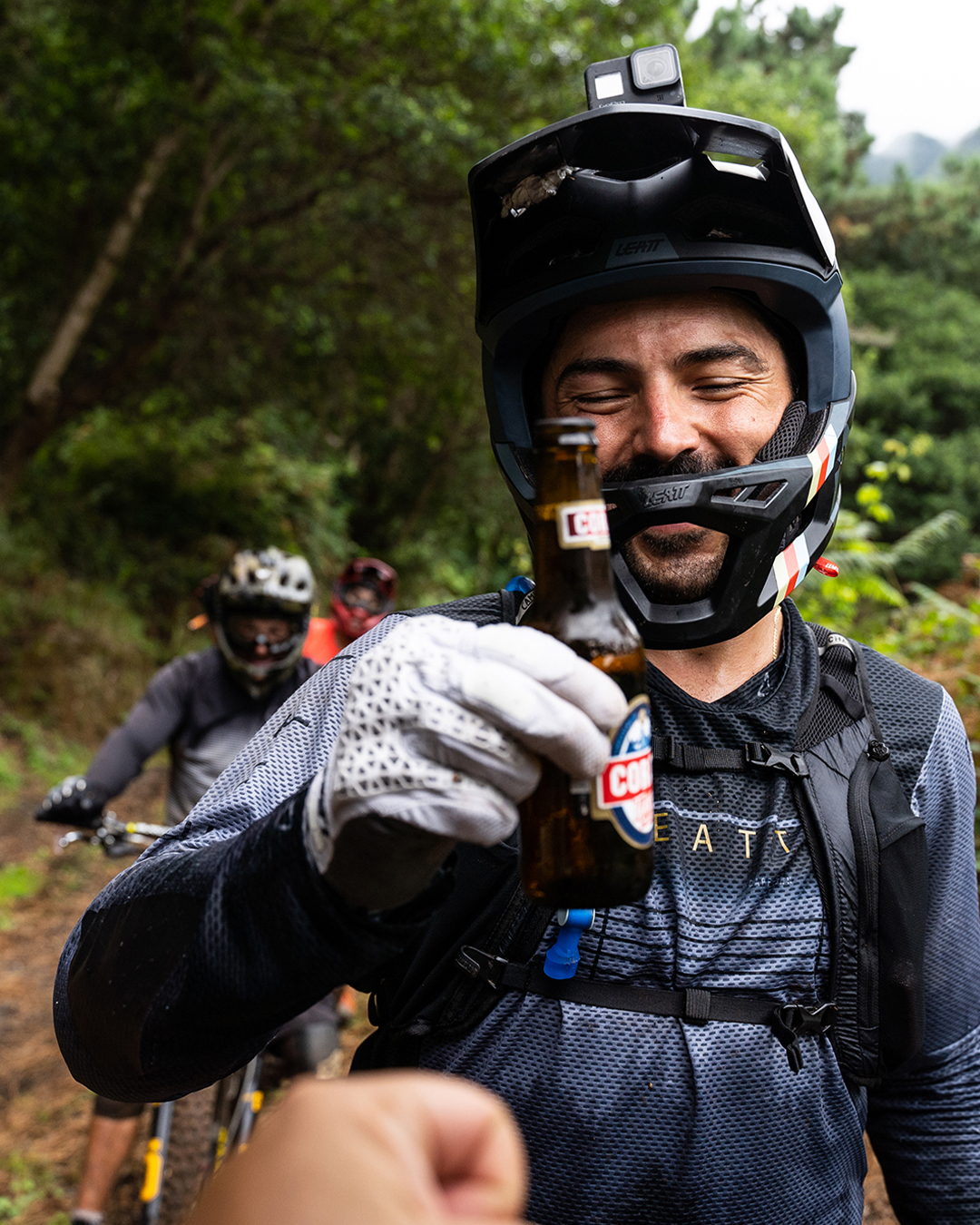
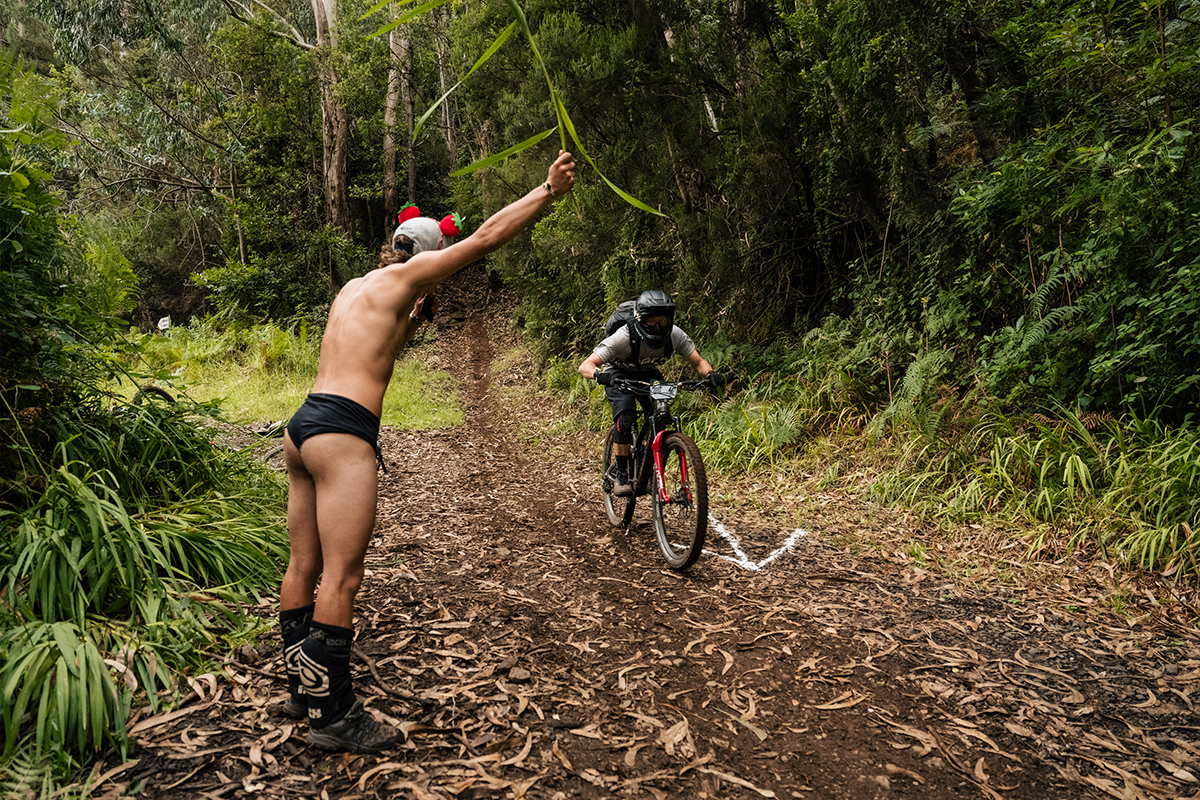
The biggest thing that I would take from these sort of events is to see how amazing the bikes are, gathering 140+ people from 25 countries, ages from 17 to 64, men and women, hardtails, trail bikes, enduro bikes and even some crazy dudes almost in DH bikes. All of us with one goal: have a good time and ride bikes. There was nothing else that mattered during those 5 days than making the most of the experience. Lots of interesting conversations, the most incredible views; I belive it does not get much better than that!
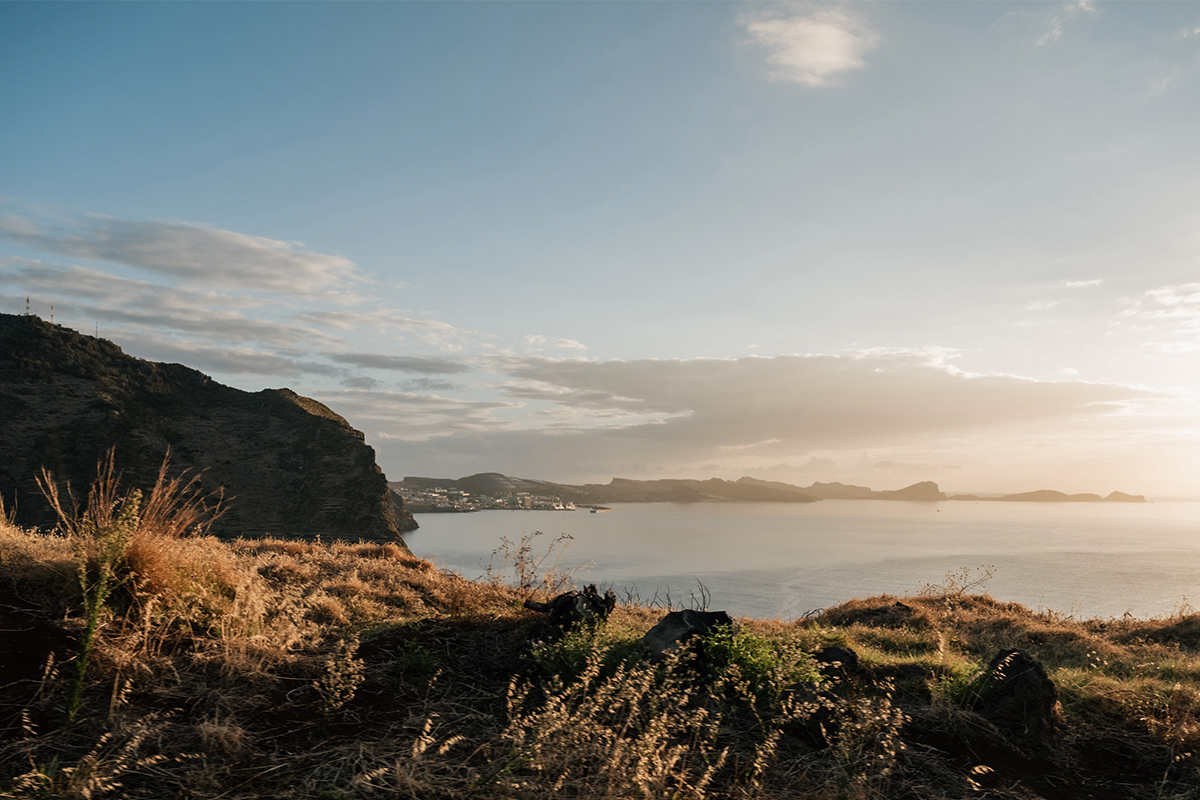
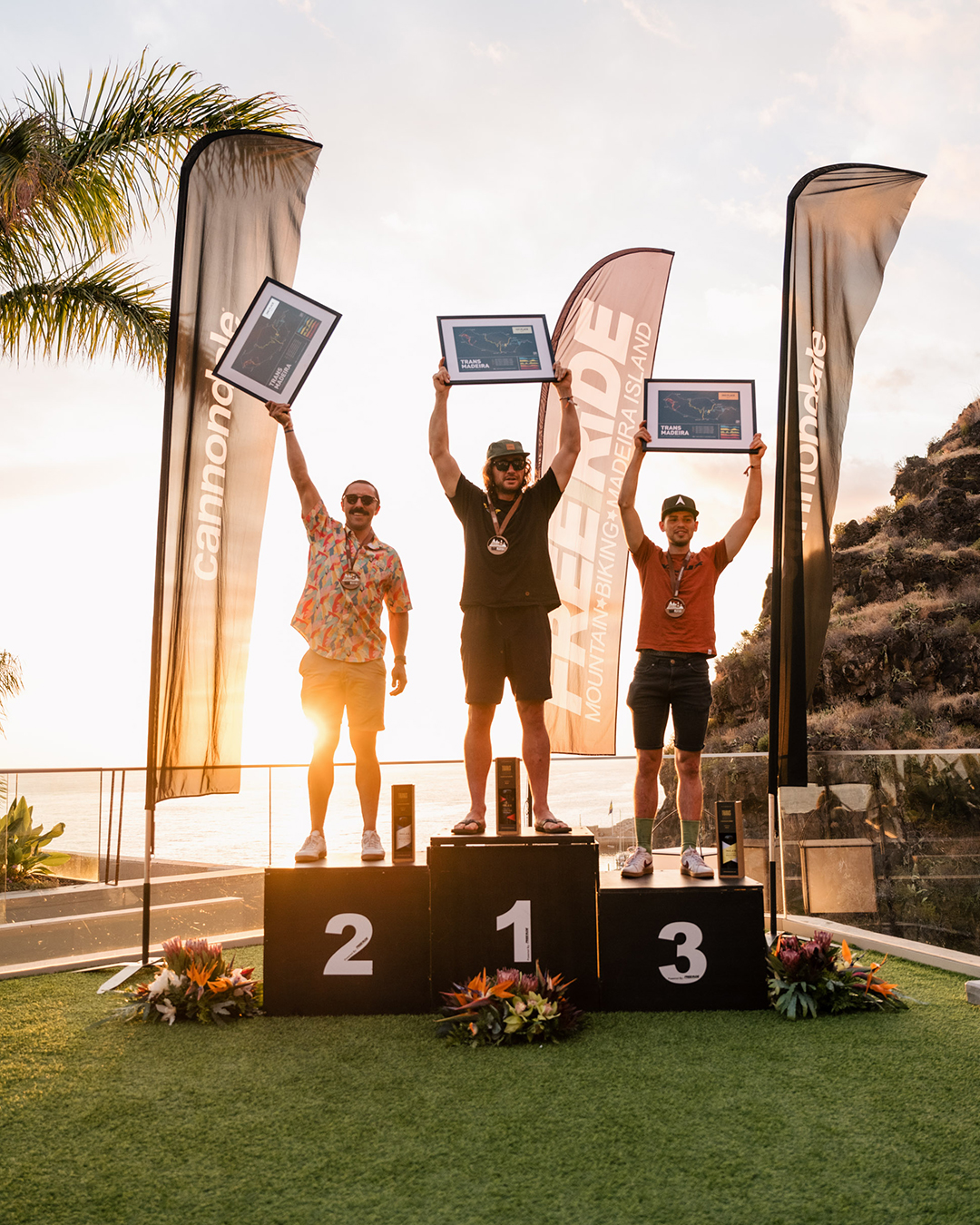
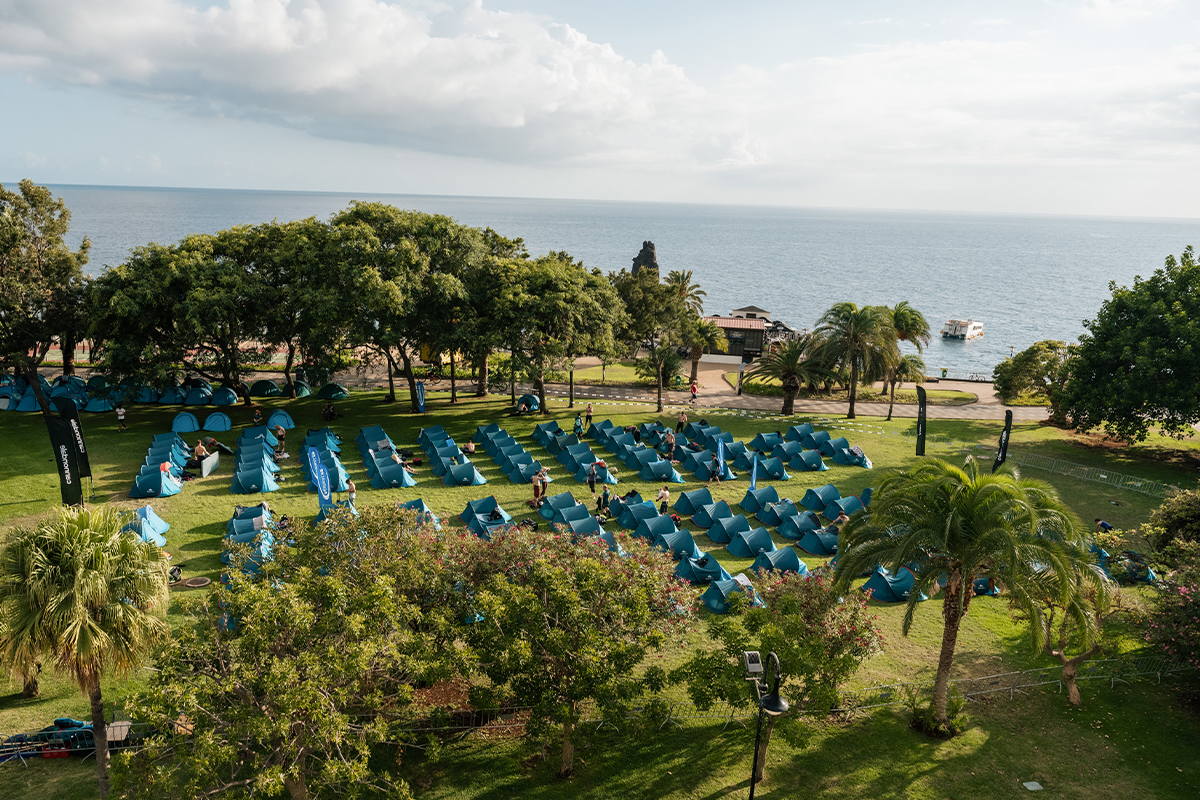
Rider – Marcelo Gutierrez
Cinematography & Editing – Marcelo Gutierrez
Photos by @valen_tinr @carlodesantiphotography @johndrfernandes @
The land above the Arctic circle is not the most well-known bikepacking destination, not even for Finns or Norwegians. Henna Palosaari from the Shimano Gravel Alliance was no exception, despite the fact that she’s snowboarded on these mountains outside Ylläs for years. When she heard about the 400 km Arctic Post Road route from Ylläs, Finland to Alta, Norway, she knew she had to see what was under the snow.
On June 22nd, Sami Sauri got a message from Henna that read: “I’m planning to ride Arctic Post Road in August, would you be keen to join?”. “Omg, yes would love that”, was Sami’s instant response. Next question: mountain bike or gravel. “I was thinking of doing the MTB version of the route but with a gravel bike”, Henna wrote back with laughing emojis. Sami was in.

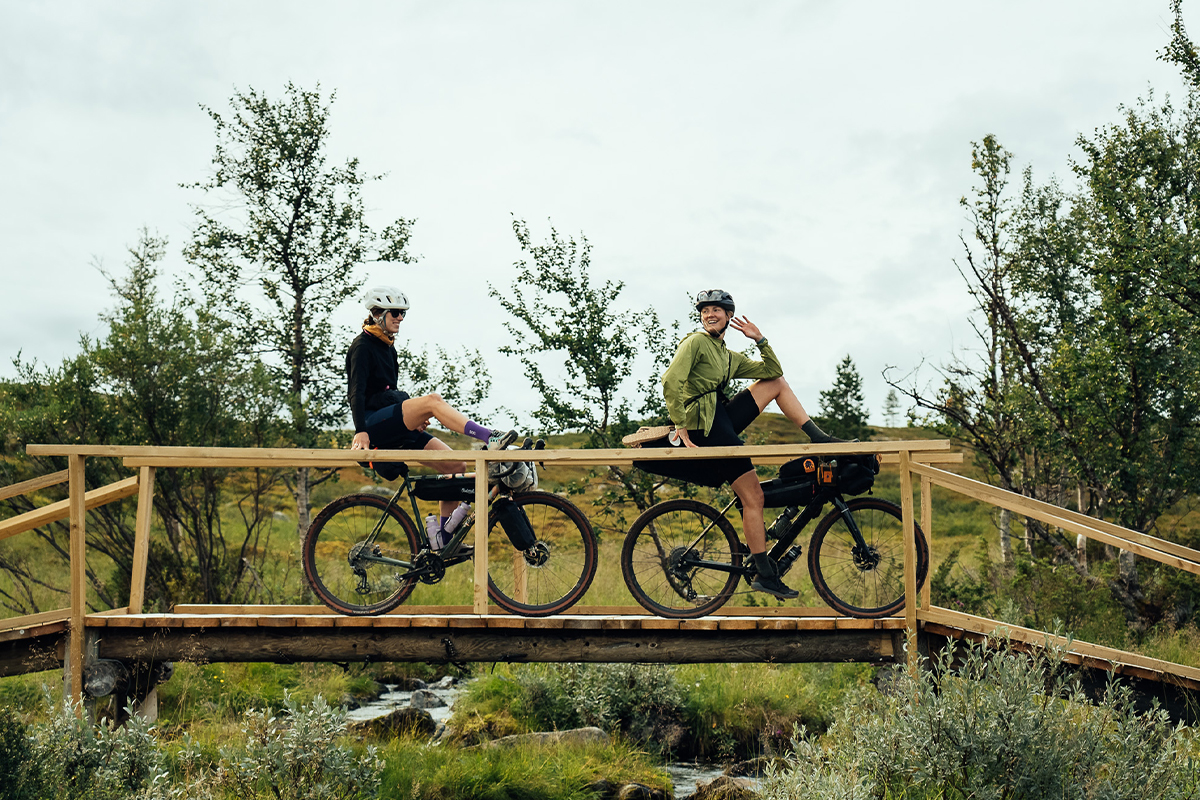
The Arctic Post Road bikepacking route follows the remnants of the old Copenhagen-Alta post road. It starts from the fells of Pallas-Ylläs national park in Finnish Lapland and runs through the Finnmark highlands all the way to Alta on the Arctic Ocean. The wilderness area created by Finnish and Norwegian Lapland is three times the size of Belgium and one of the largest spaces like this in Europe. With a reindeer-to-man ratio of 5:4, you will likely encounter more reindeer than people on the trails. However, reindeer are not here to be adorable entertainment for bikers, they are also economically important for many Lappish and Sámi. To respect that, the route is closed during the critical season in late September when herds of thousands of reindeer are gathered together for fall round-ups.
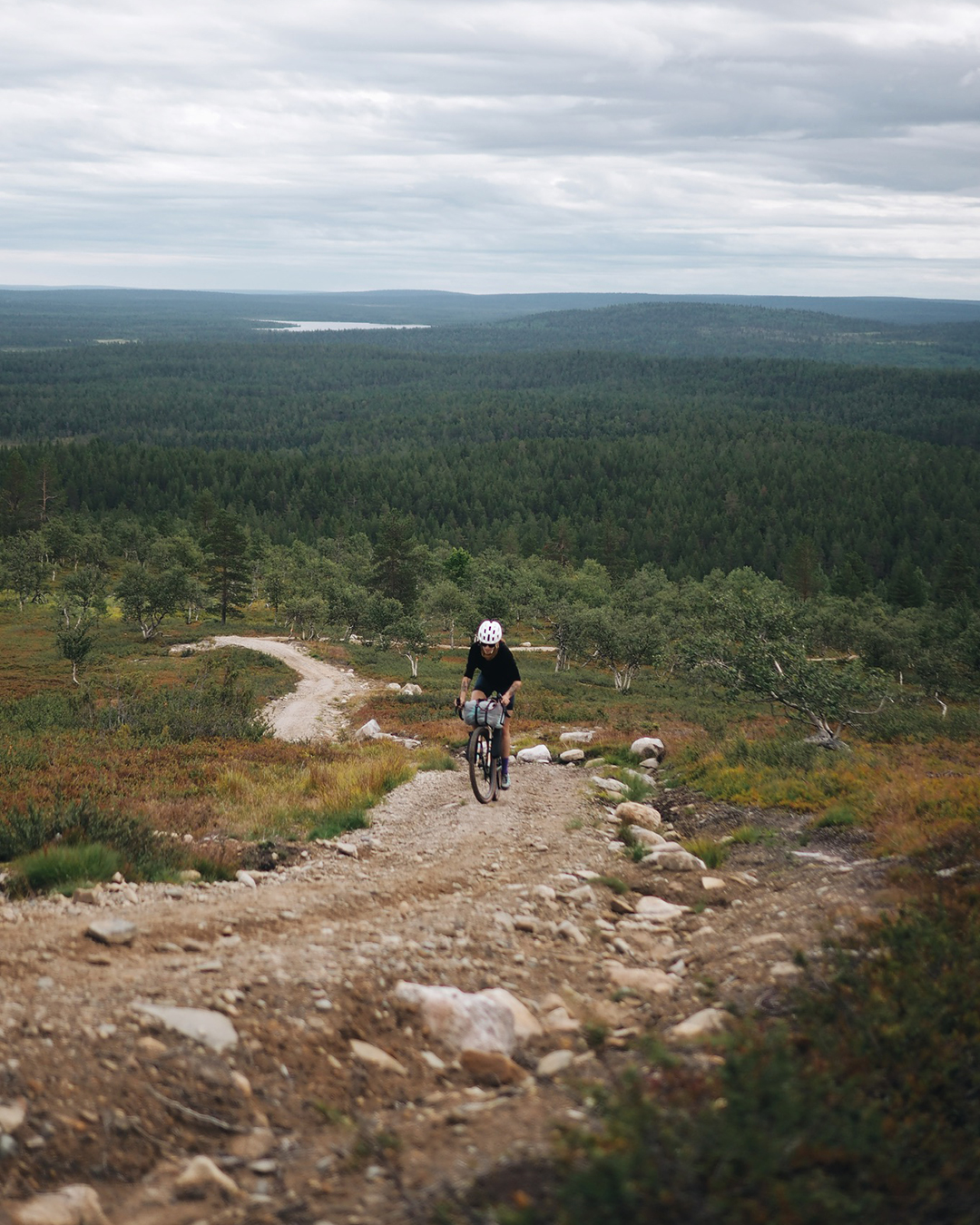

Besides that, it is also recommended to take Räkkä into consideration – that’s the season when there is high population of mosquitos, black flies, biting midges and horse flies in the Arctic, unless you plan on wearing a full body mosquito net while riding. Despite never having been to Lapland before, Sami had heard all about the mosquitoes and duly came prepared with a mosquito head net, bracelets and repellent. Räkkä starts usually by late June and lasts usually till mid-August which makes the end of summer and fall a great time for bikepacking in the Arctic. By September, the Northern lights often light up the night sky as well.
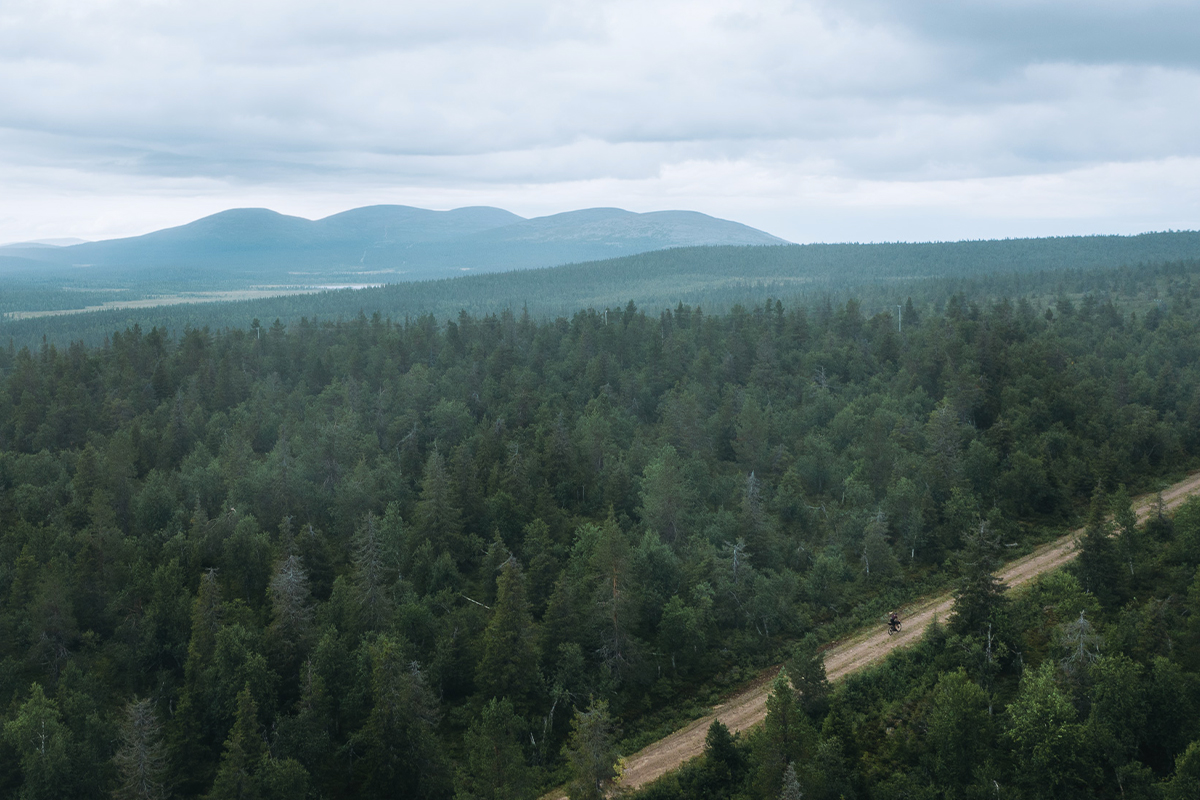
RIDING THE ARCTIC
Forest dirt roads and occasional tarmacked roads lead us from Ylläs to Pallas, where we get the first glimpses of the beautiful seven fells of Pallastunturi. While the original plan was to avoid all roads, Henna knew that the next section from Pallastunturi would be tough on a MTB, let alone a gravel bike, so they made the decision to go by road and stop off at Restaurant Loimu instead. When we turned into the parking lot at Loimu, it felt like we had stepped back in time – a really charming and modest spot, but the gas pumps and interior radiate a serious 70s vibe. Experiencing the simplicity of life up North and the local culture combined with the tranquility of the long wilderness sections creates a bikepacking experience that takes you miles away from the city hustle.

The sky started to clear after some rain showers and we get back on the forest road that leads us to our camp spot by the lake. A quick dip in the clear watered lake and mosquito nets on before dinner, grateful that there are so many lakes and rivers to make our lives easier when it comes to camping and resupplying our water. In signature Spanish style, dinner is accompanied by a cheese plate.
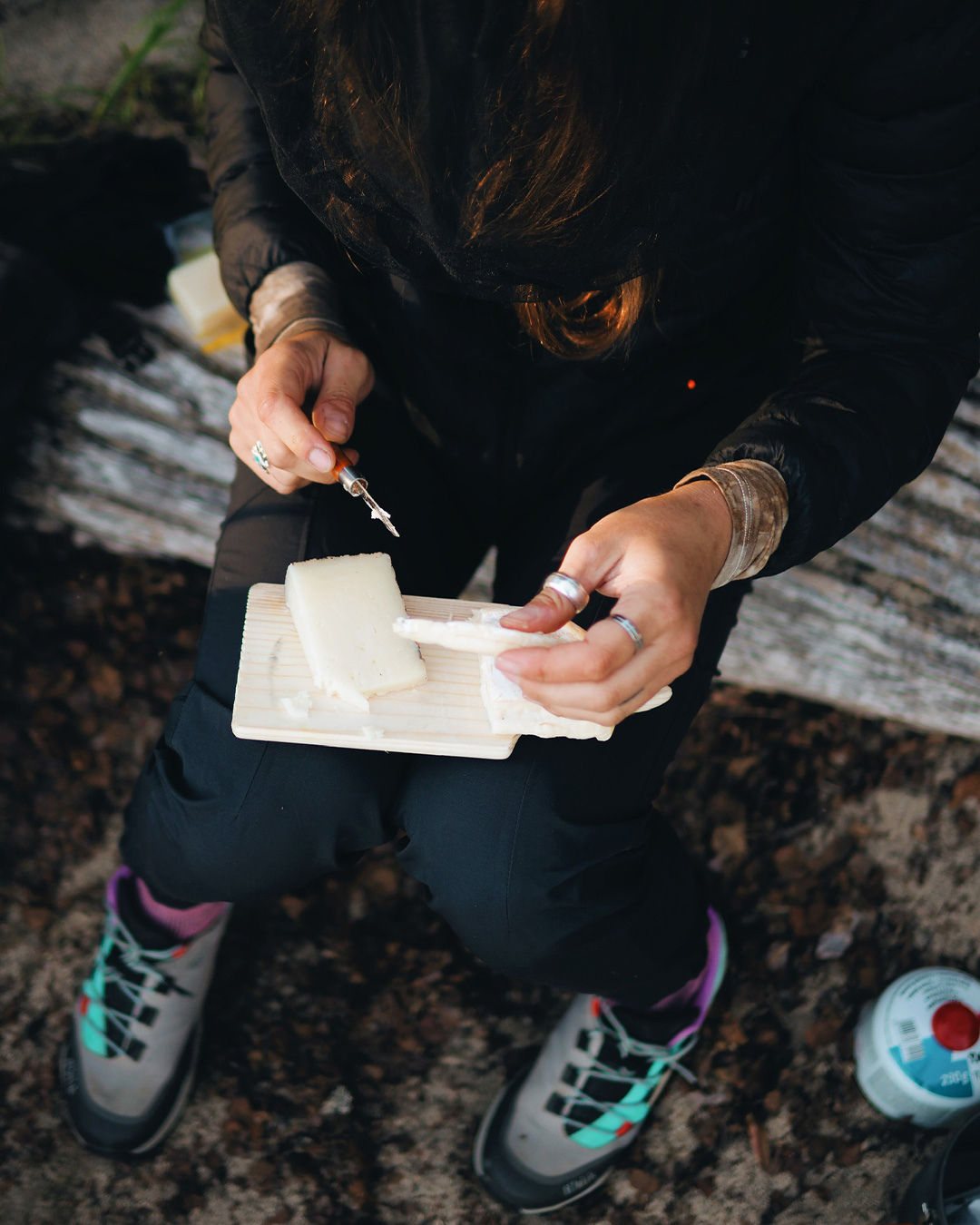
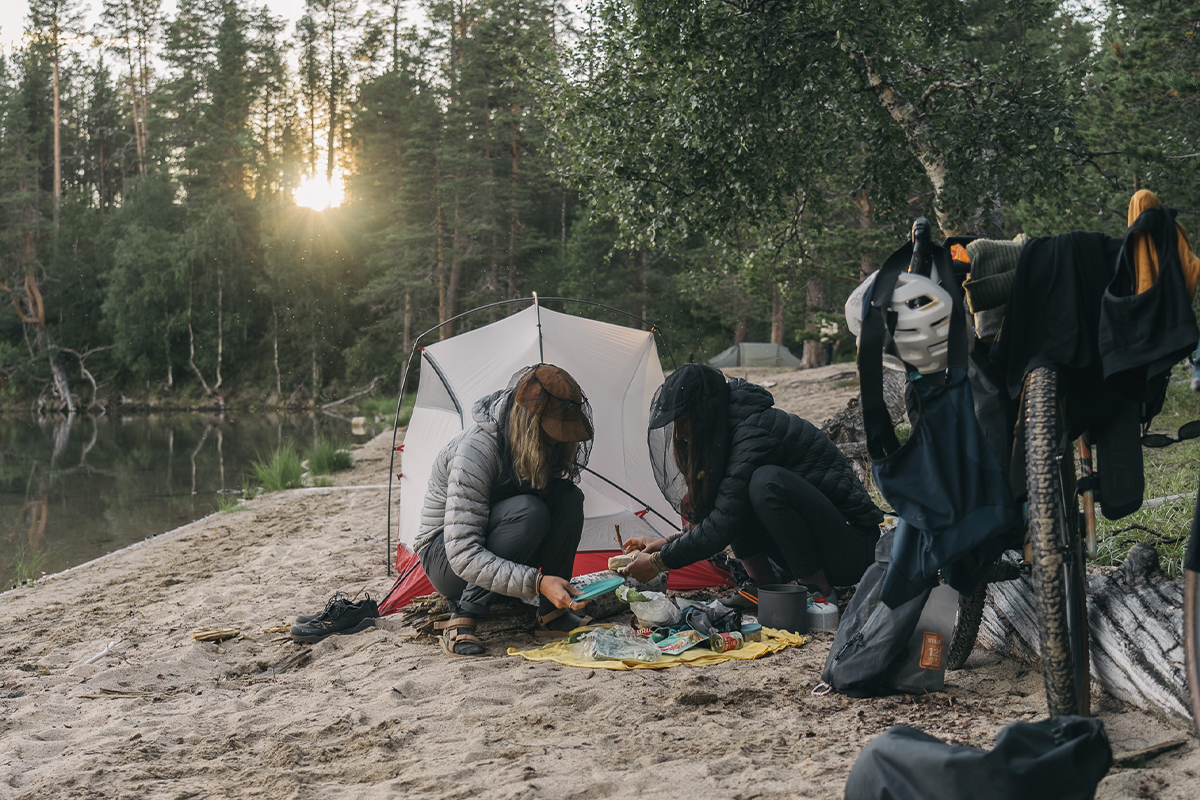
The first two kilometers of the second day gave a taste of what lay ahead on the Arctic Post Road – steep trails, rocky sections and loose sand that forces you off the bikes from time to time. It slowed us down but we were pleased to be away from the road, especially as we were rewarded with amazing vast views in every direction. The route is more well-known as a hiking route so the hikers of the Hetta-Pallas hiking trail were surprised to see two girls with gravel bikes up there riding down the rough trails, balancing on the wooden boards and carrying their bikes over rocks.
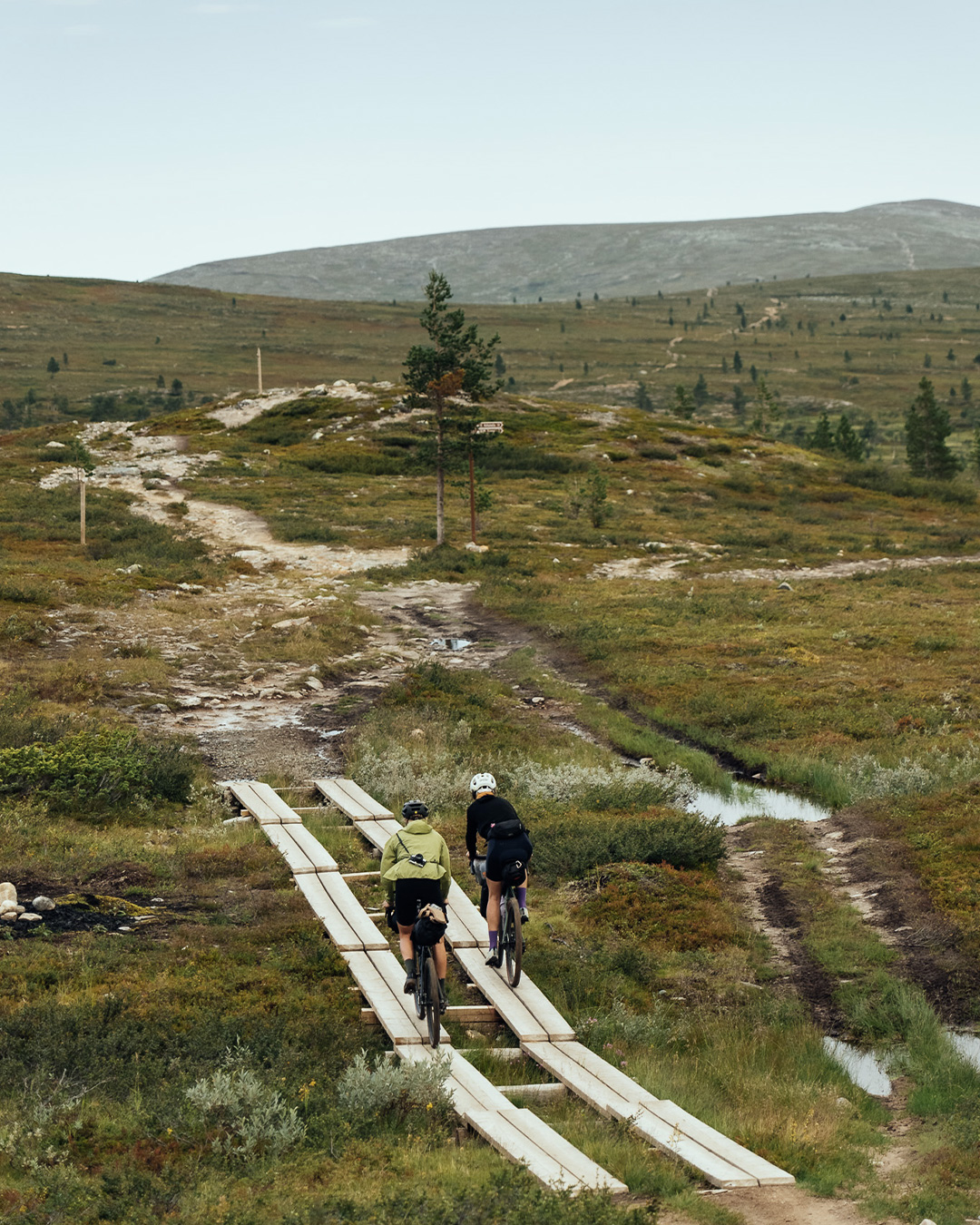
We stopped to enjoy local treats at the wilderness cafe and learned from the local lady that there had not been a mushroom year like this in 60 years, which explained why we saw mushrooms wherever we looked. In Hetta, we restocked and made a decision to keep riding the MTB route even though we had heard rumors of the next 25 kilometers being rough. The rumors proved to be right – not even that much because of the rocks, but because of the endless swamps and bogs that could not be ridden through. Tired and a bit broken, we stopped at the wilderness hut halfway through the section but decided to keep riding because the forecast promised heavy rain that would make the trail even worse. We also thought there was accommodation in the next village, Näkkälä, but there were no signs when we got there and Google maps was no use due to the poor signal. We were tired and starting to feel the chill. Finally, a quad driver told us the owner of the place was out fishing without his phone and he was the only one who had access to the key. Knowing that the next accommodation was 13km away in the wrong direction, we decided to pitch our tent on the parking lot of the hiking trail. When the tent was up, the pouring rain started and lasted the whole night.
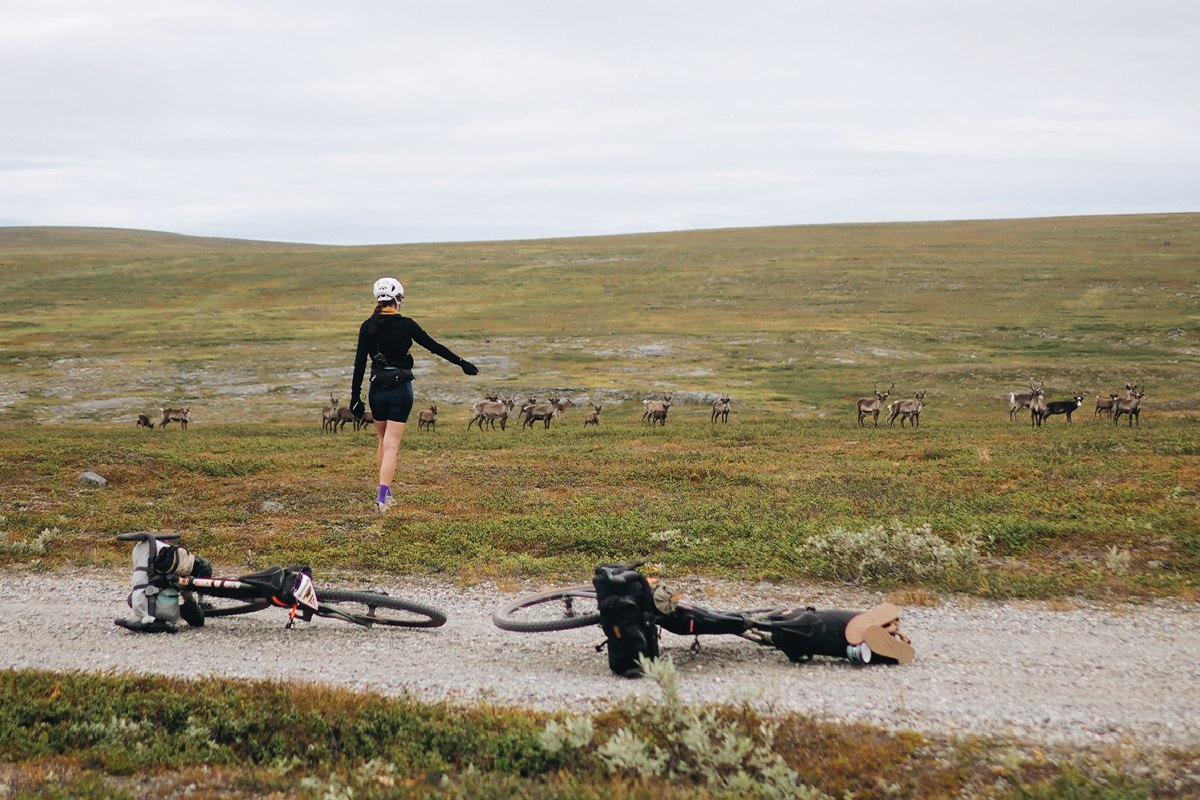
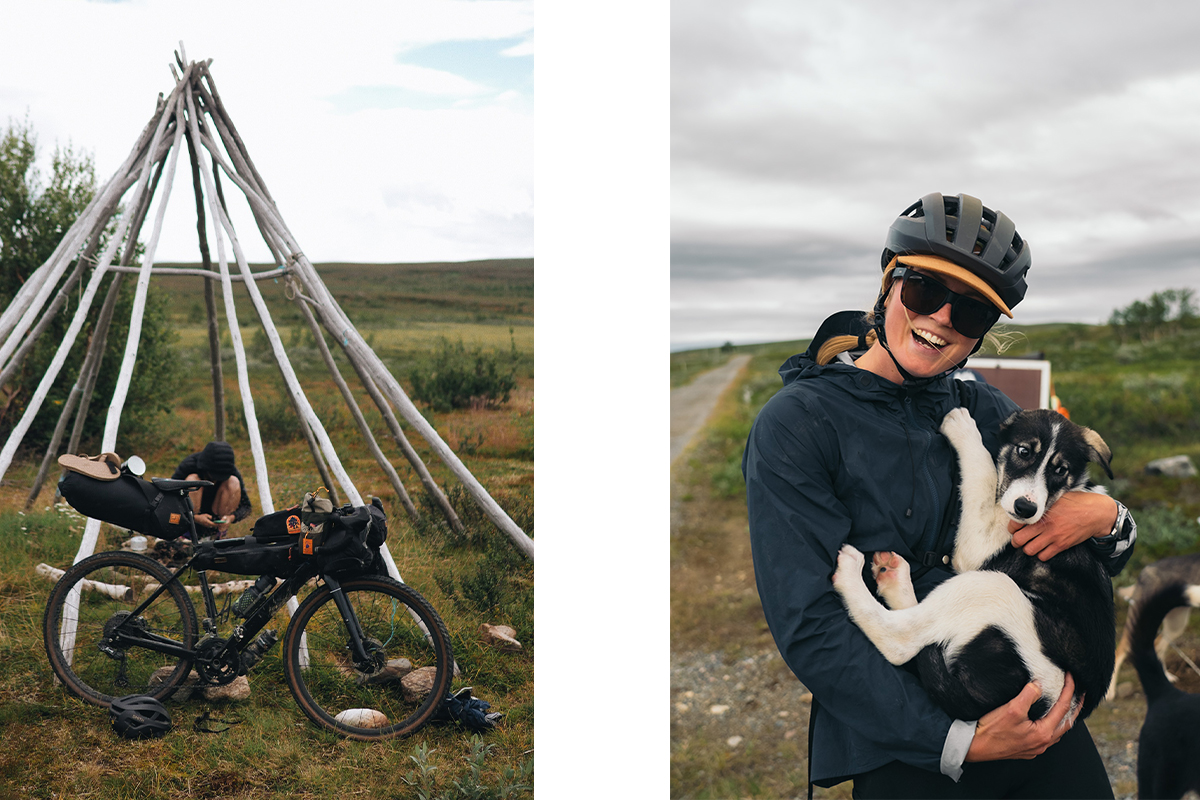
The cold and rainy morning meant that the start of the third day was not the most inviting but we hopped on the bike with the goal to reach Kautokeino and sleep somewhere warm and dry for the night. The rocky trails changed into sandy trails but the big puddles from last night’s rain as well as the swamp and river crossings kept the pace slow. In this section, we really felt like we were on our own in the middle of nowhere. “The most surprising part has been how long you can go on a gravel path before you see a house again. Endless hours and endless kilometers on the bike without seeing anybody or anything, not even an animal or a bird,” Sami says pensively. The border between Finland and Norway could easily have been overlooked; there was just a reindeer fence following the line but nothing particularly official-looking. Welcome to Norway. Finally, after what felt like hours and hours of riding we saw huts on the other side of a lake. First, we just had to cross a thigh-deep river mouth to get there. When we got to the other side, the owner of the house welcomed us in Norwegian and invited us in for a coffee. Starving and tired, we were thrilled to have a break and meet the family.
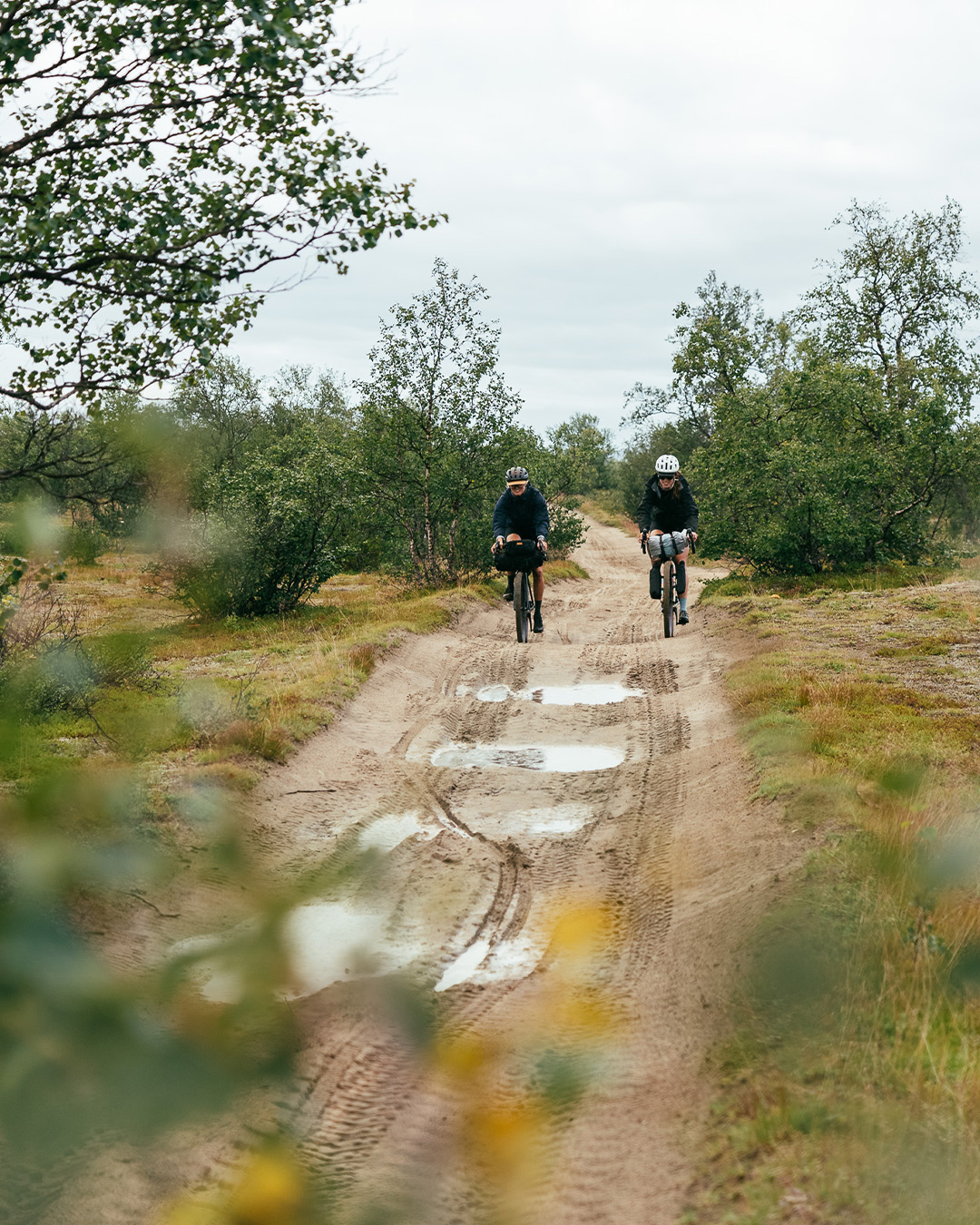
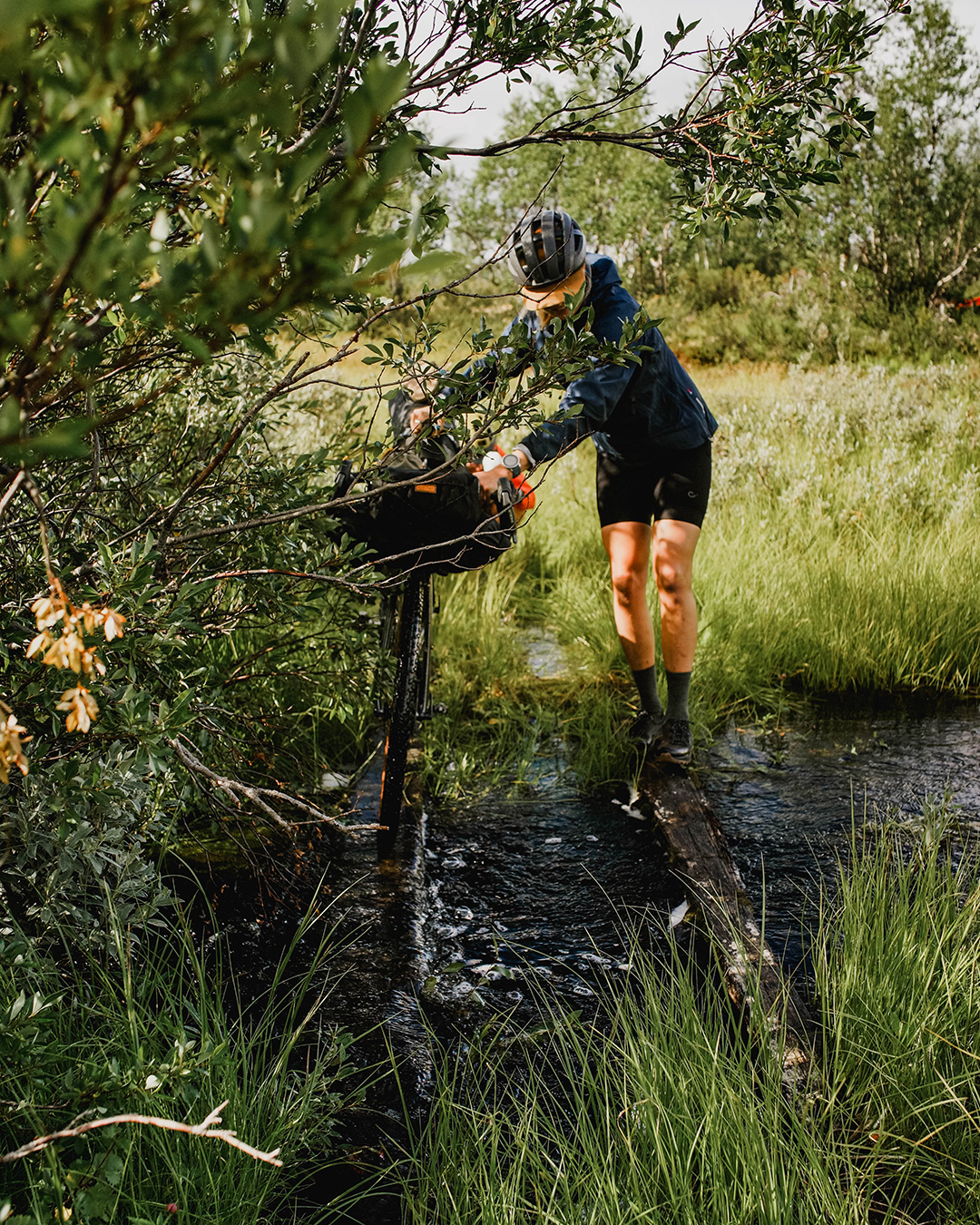
It was idyllic. The grandma was sitting on a deck knitting, the young boy spoke perfect English, sheep were roaming the backyard, we shared stories over local food, including reindeer tongue, dried reindeer meat, cold-smoked salmon, brown cheese sandwiches, cloudberries and blueberries – Norway at its finest.
Henna and Sami agree. When we asked if we could pay something, the answer was a resounding no from the dad of the family, who instead opened his arms for a hug. When we are ready to leave, the dad runs outside with a big piece of dried reindeer meat to take on our journey.
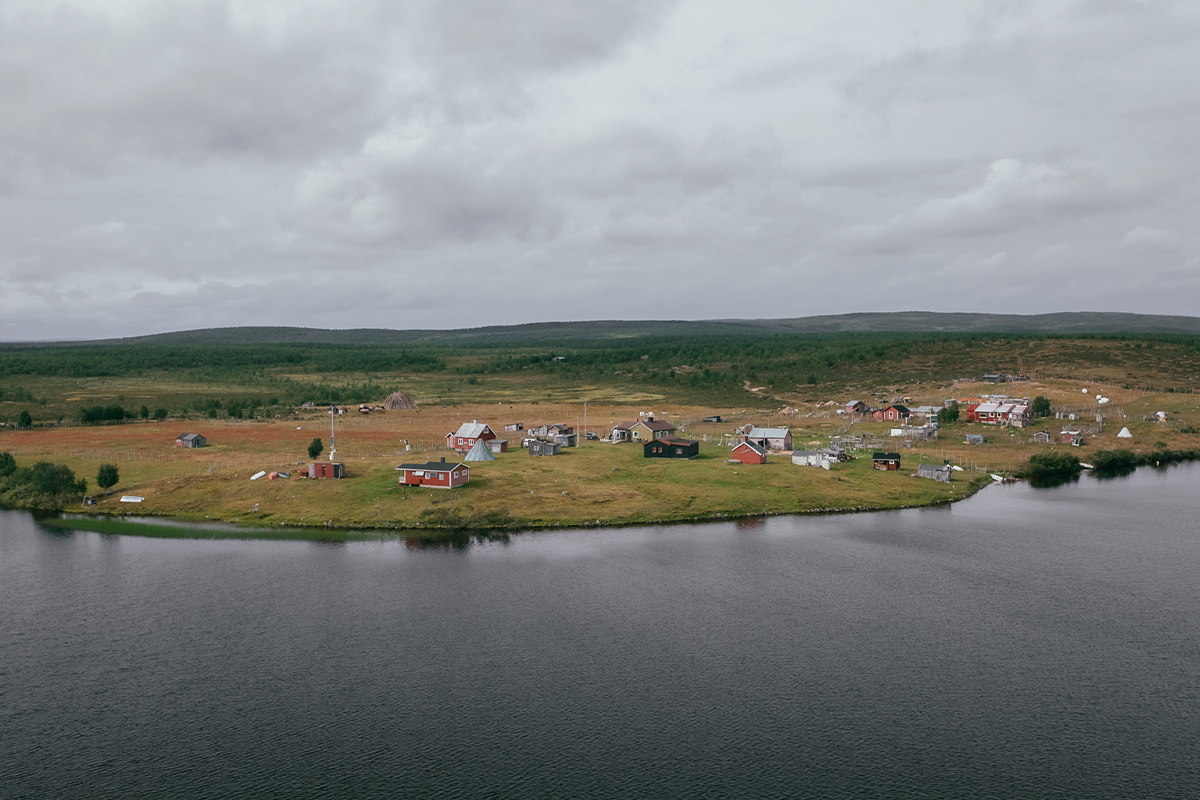
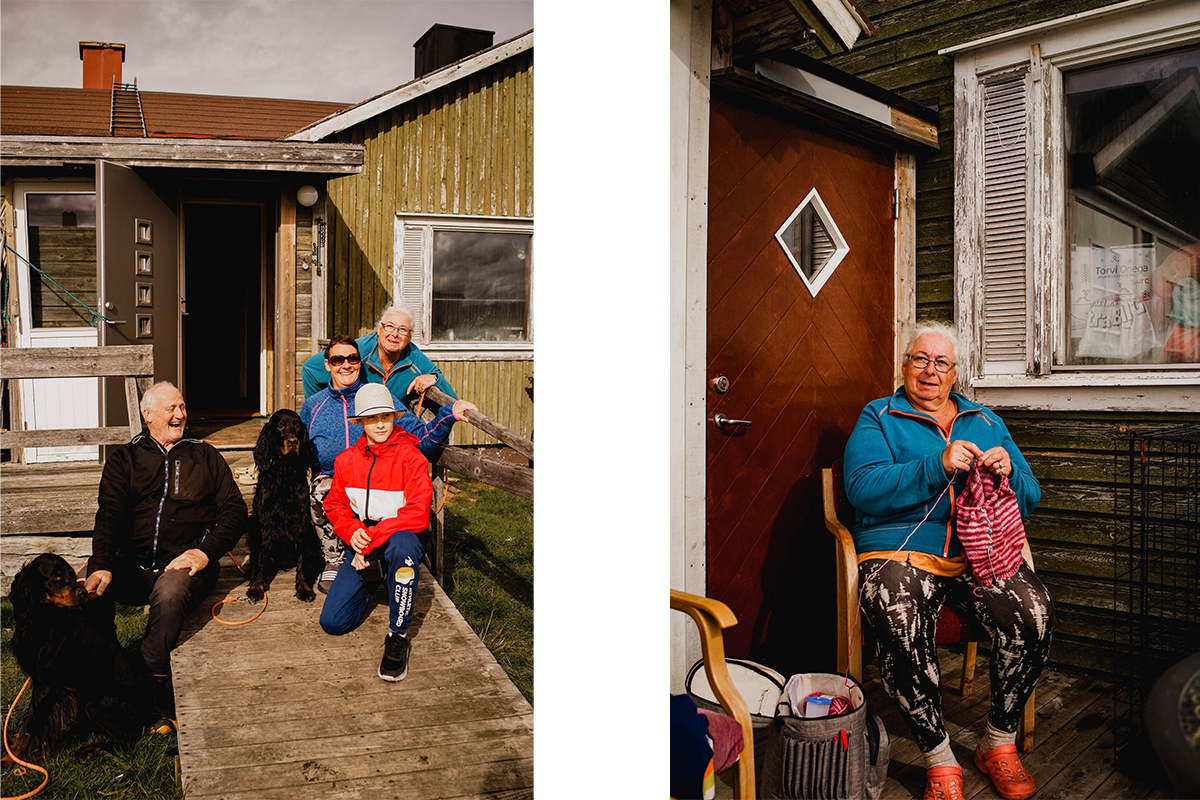
The hardest part of the route was now done. The final 145 km to Alta would be on a gravel road so we were confident we would be able to pick up our pace a little bit. After a hot shower and a good night’s sleep, we were refreshed, following the river out of the town. By midday, we get above the treeline and enjoy the vast mountainous views. We make lunch at a reindeer herder’s tipi before riding along some of the longest straights we have ever seen. Given the openness of the landscape, there’s a unique tranquility here – it’s magical almost. True to tradition, we don’t make it to the Suolovuopmi fjellstua, an old mountain hut, with dry feet today either. The previous night’s rain had left big puddles on the road – some of which Henna got to experience thoroughly. The Fjellstua provided us a cozy stay and let us enjoy a delicious local dinner of arctic char and potatoes before going to bed.
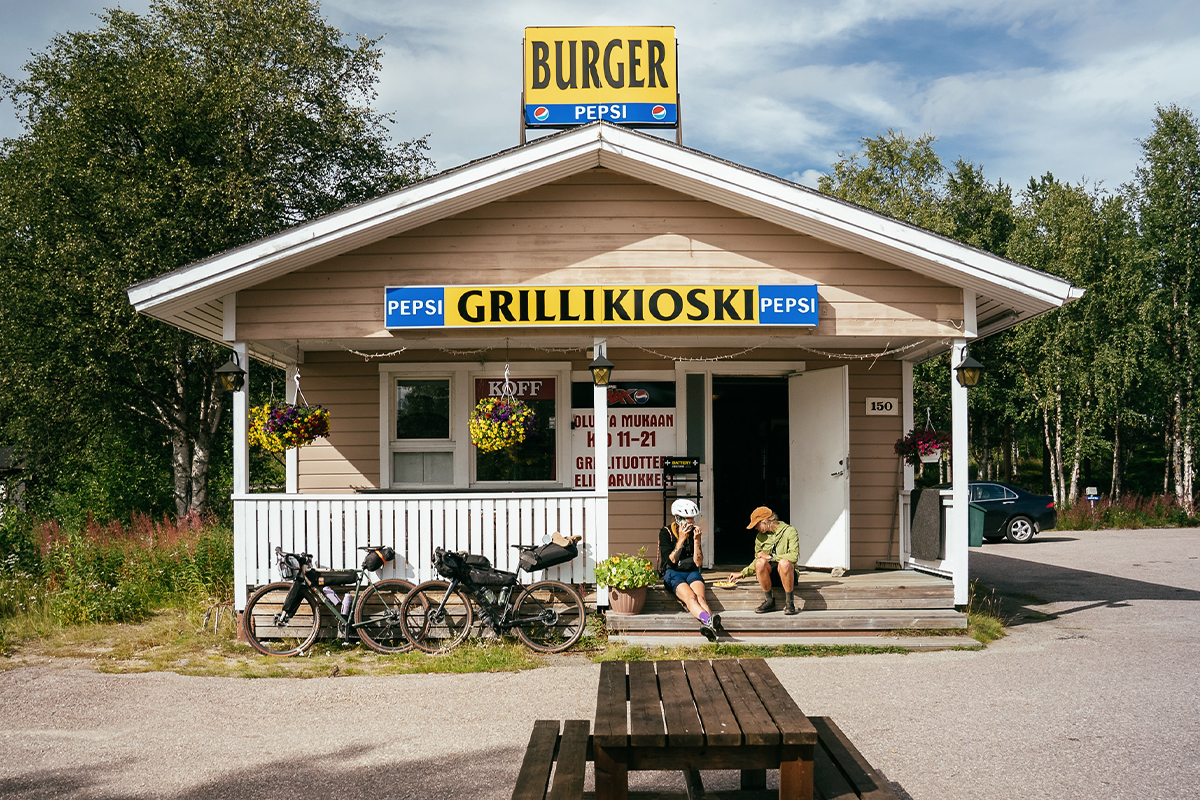
We had been faster than we expected – there was only 65 km to go to Alta and the gravel road was reportedly in a great shape. We started with a climb up to the fells where crispy northern winds welcomed us. On the horizon, we could see the high snow-covered mountains of Norway while we were cruising along these rolling hills above the vast highlands. A couple of reindeers soon turned into hundreds. “Even for a Finn,” Henna says in awe, “it’s a cool experience to ride among the reindeers and Sami turned into a proper reindeer whisperer on this trip.”. Another highlight of the final day was running into a mum and daughter duo with a dozen huskies that they were training to compete in the famous Finnmarksløpet, the longest dog sled race in Europe. Compared to our gravel bikes, they were moving at quite a pace, but were happy to let us stop and cuddle. Reenergised, we pushed forward to reach our final destination, Alta. Not to make the final part too easy, we hopped back onto the MTB route that consisted of singletracks along the river Alta. It’s hard to say for certain if we made the right decision here as some sections were great fun while others were too muddy to ride, but eventually we made it to the famous Alta church to finish our 380 km ride through one of the largest wilderness areas in Europe.

The weather may not have been the warmest but the vast landscapes, reindeers, friendly locals and magical light made it an unforgettable trip – the kind that warms you more from the inside, than the out. And isn’t that why we all do this sort of thing?
Riders – Sami Sauri & Henna Palosaari
Cinematography & Editing – Mikko-Pekka Karlin
Graphic Design – Constanze Maier & Henna Palosaari
Photos by Mikko-Pekka – Photos and words by @samisauri and @hennapalossari
“The Canary Islands have for some time been considered a must-see destination for traveling cyclists. But what route does one follow when they simply must see all of this incredible archipelago? Linking six individual islands, each connected by ferry, GranGuanche is not one, but three cycling routes—road, gravel, and trail—each designed to take travelers through the heart of this cycling paradise. Recently, Cento Canesio and Nadia Moro undertook the epic gravel option, sharing their experience through the words and images below.”
Islands in the middle of the ocean, where you can ride without too much stress because the ferries slow things down and make you feel like you’re on vacation, even when you have to notch up four or five islands in a row in just a few days.
One after another you cross them, you string them like beads and you take them with you.
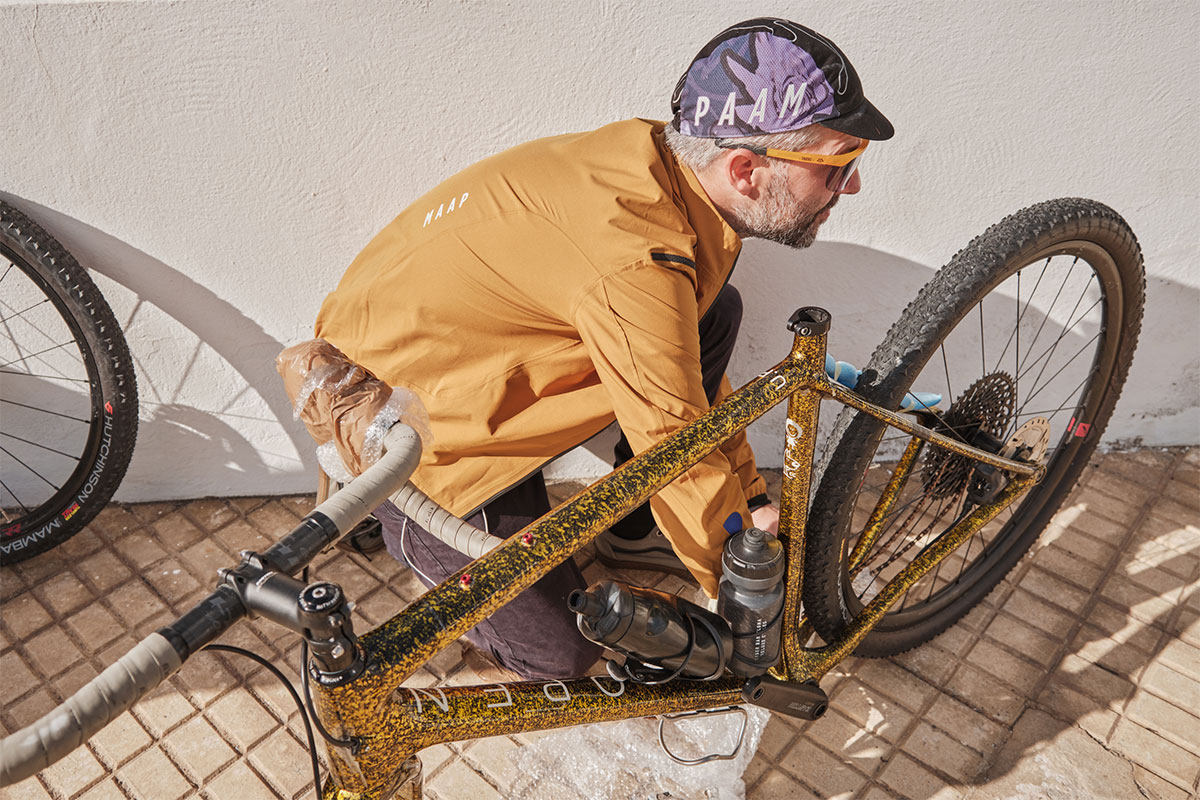

Who has never thought, after arriving on one or more of these islands, “I almost want to move here to live” … especially if you’re coming from some gray, crowded, polluted metropolis.
Matteo with the Granguanche did this — a good example. He seems like a very relaxed sort, extremely meticulous, who knows what he wants and how to get there, always ready to take an engineering approach. The Granguanche is a case in point.
Lanzarote smells of light and dark earth, of bays where you can surf even when you’re passing by on your bike.

In the off-season a quiet, isolated land that’s never too bad.
Scattered lava with craters of all sizes, to remind us that not all that glitters is gold …
Fuerte Ventura, though, reminds you that it’s always windy and that mi cabra es tu cabra, in the desert, along the cliffs, or climbing the mountain passes to descend on the other side and add this island to the string as well.
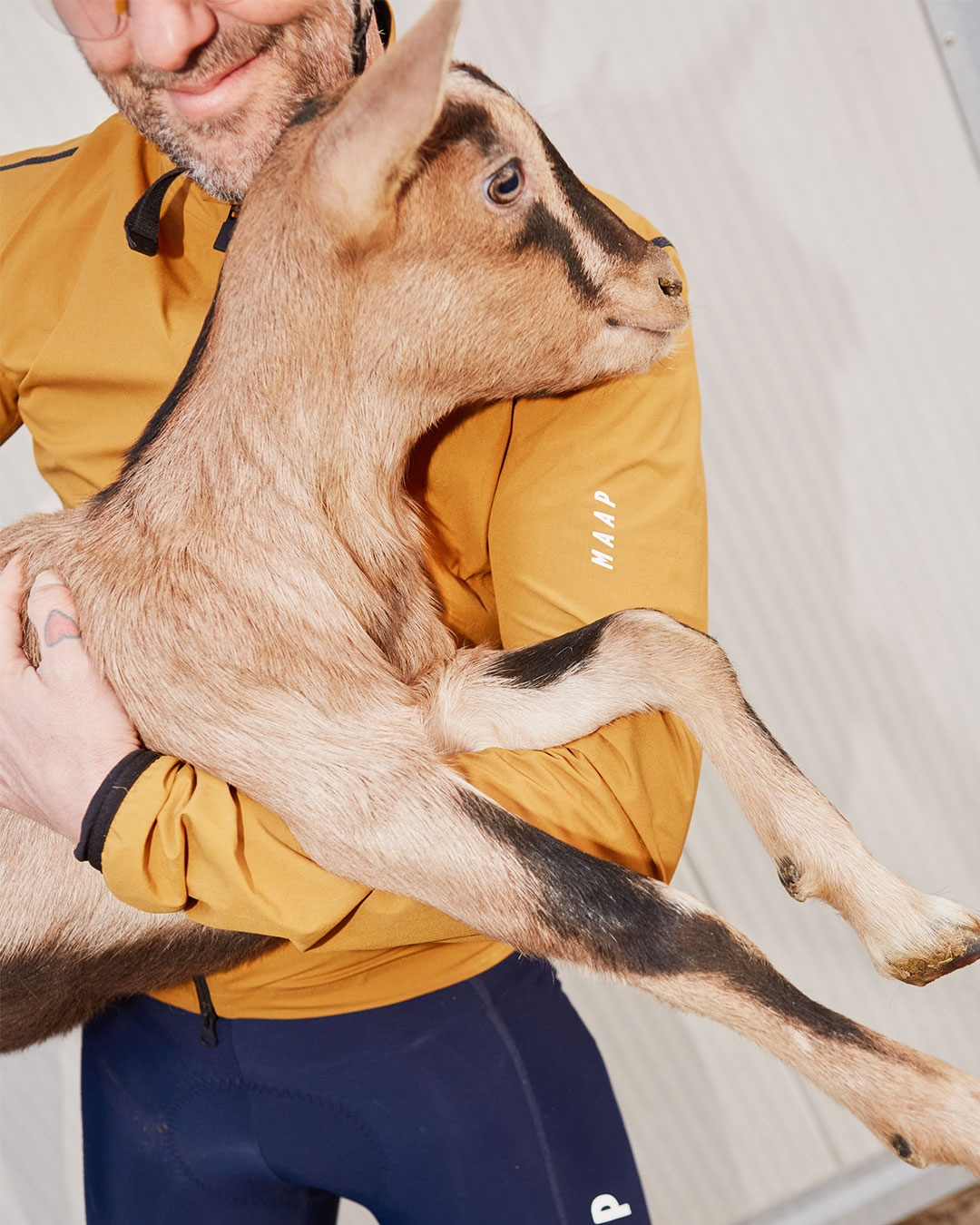
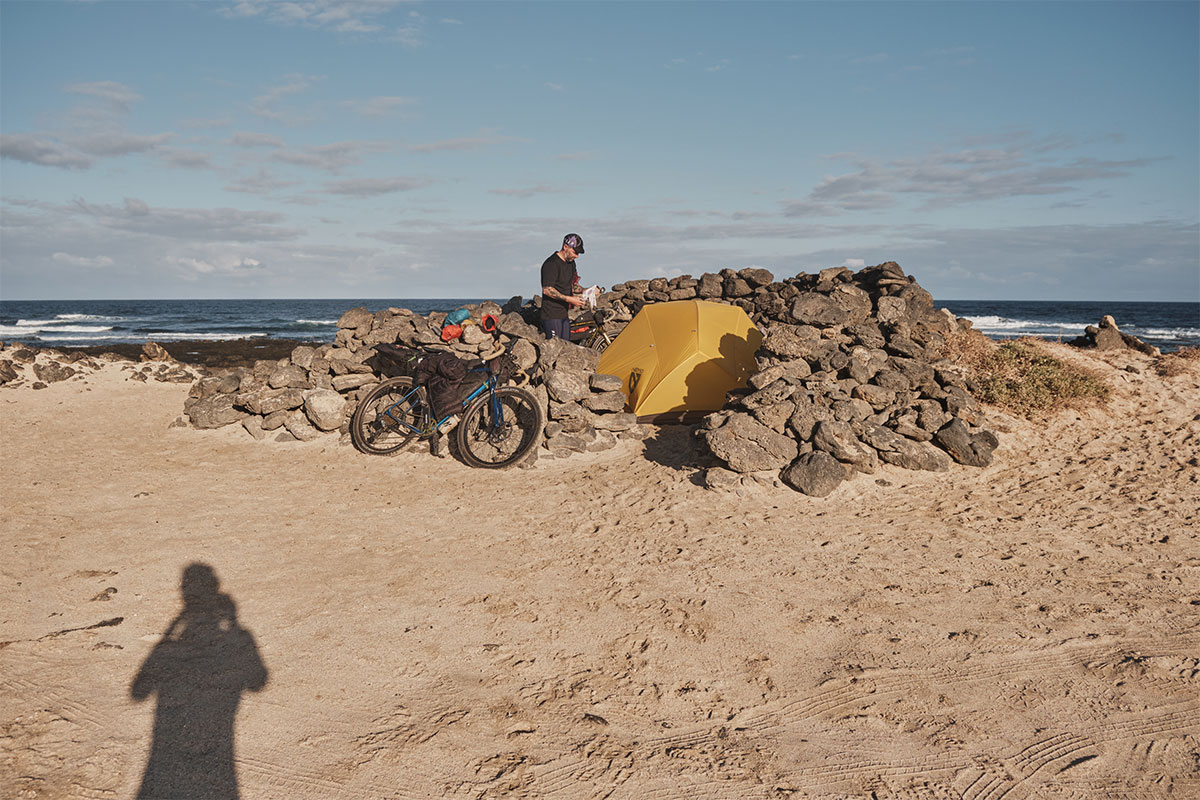
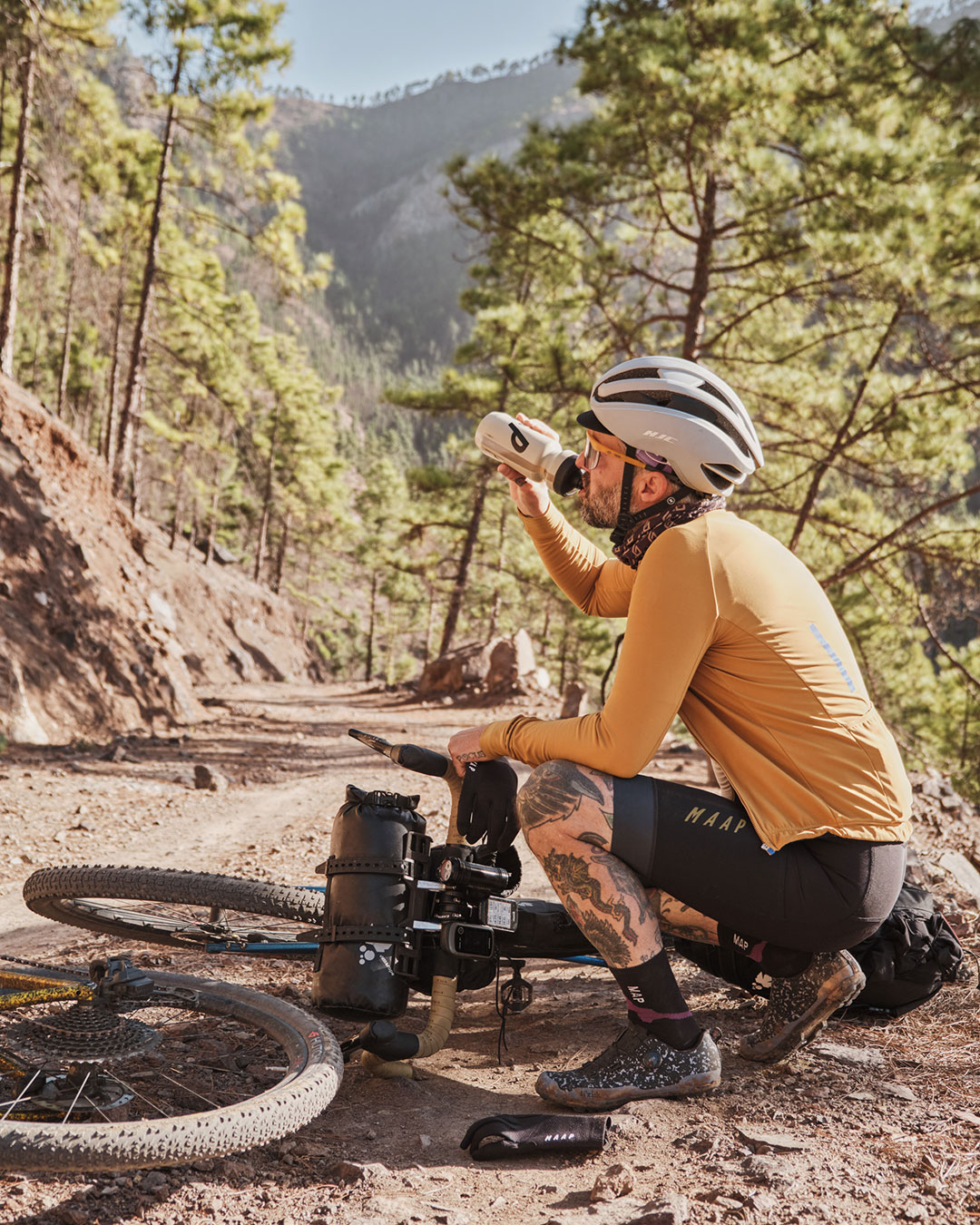
And it made us feel how we wanted and where we wanted.
Like the first, second, third, fourth, fifth night, whether it was in a tent or in accommodations arranged at the last minute.
It was nice to find a small rock fort that sheltered our tent from the wind along the south coast of furious Ventura. Too bad a seagull managed to break into the backpack with our food for breakfast before we came out of the tent in the morning … Damn bastard.
It was fun sleeping at the ferry dock on a bench (Ste on the ground as usual, but not me because I’m afraid of mice) to be ready for the transfer from Fuerte to Gran Canaria. The charming ferry attendant begged us that night not to sneak in to sleep on the ferry or he’d lose his job, and he made sure to come wake us up at 5:00 in the morning to urge us to get ready for departure …
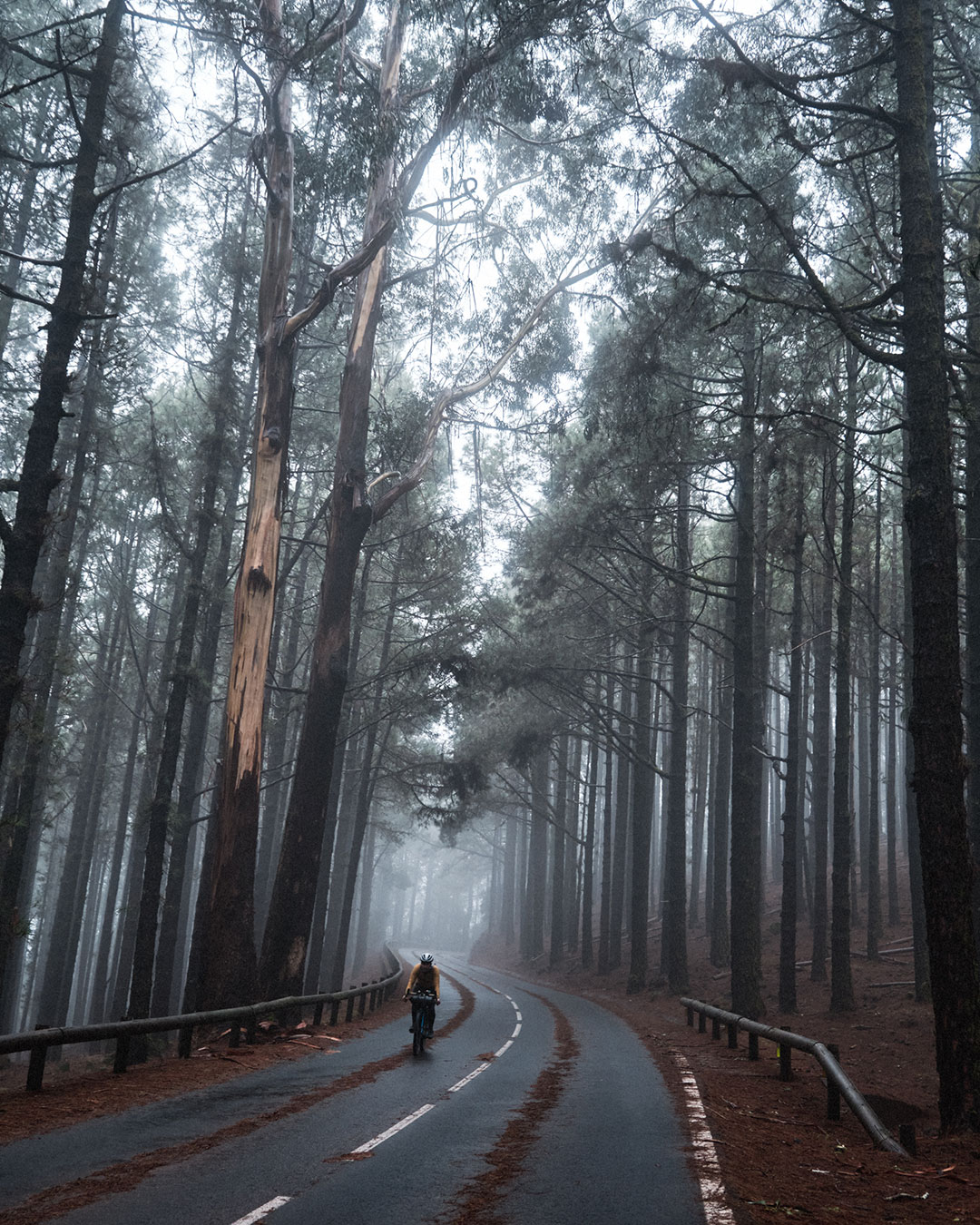
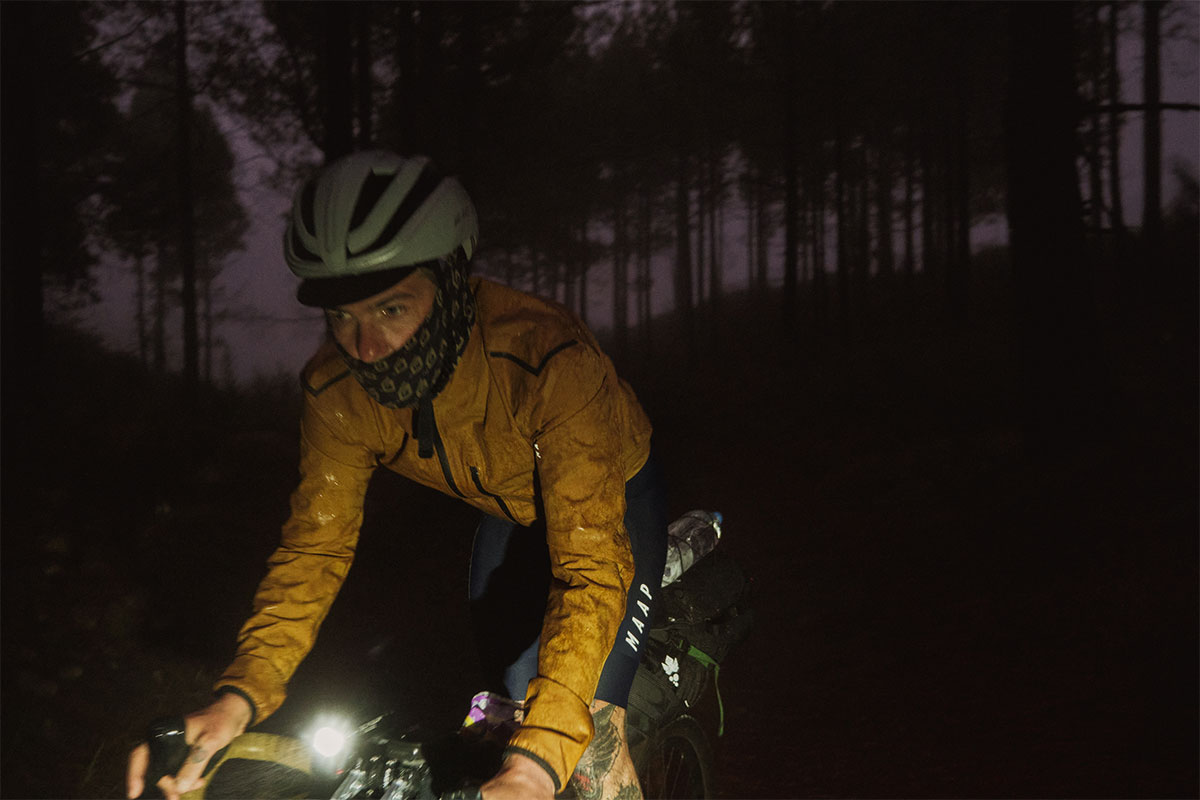
You reach Gran Canaria a bit relaxed, unaware of the ramps that will take you to the top of Pico de la Nieves. There I felt a little less at mi casa/cabra, etc. … Especially when the off-road ramps are spiced up by gusts of wind in changing and unpredictable directions, wet with rain and black as night. An interesting mix. I screamed at Ste to take the curves inside … On gravel and without guardrails, it would be hard to figure out where to find him if he were blown away by the wind.
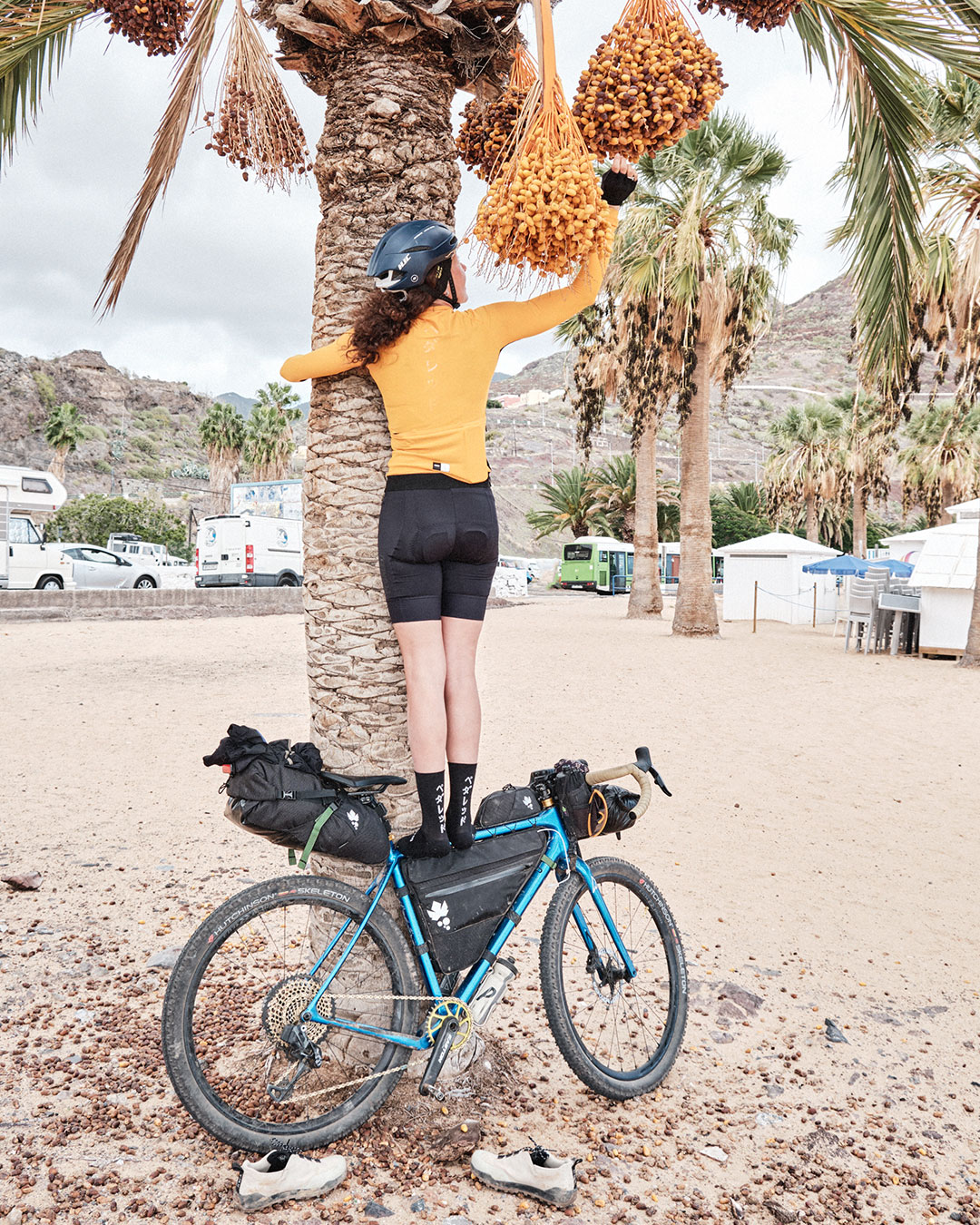
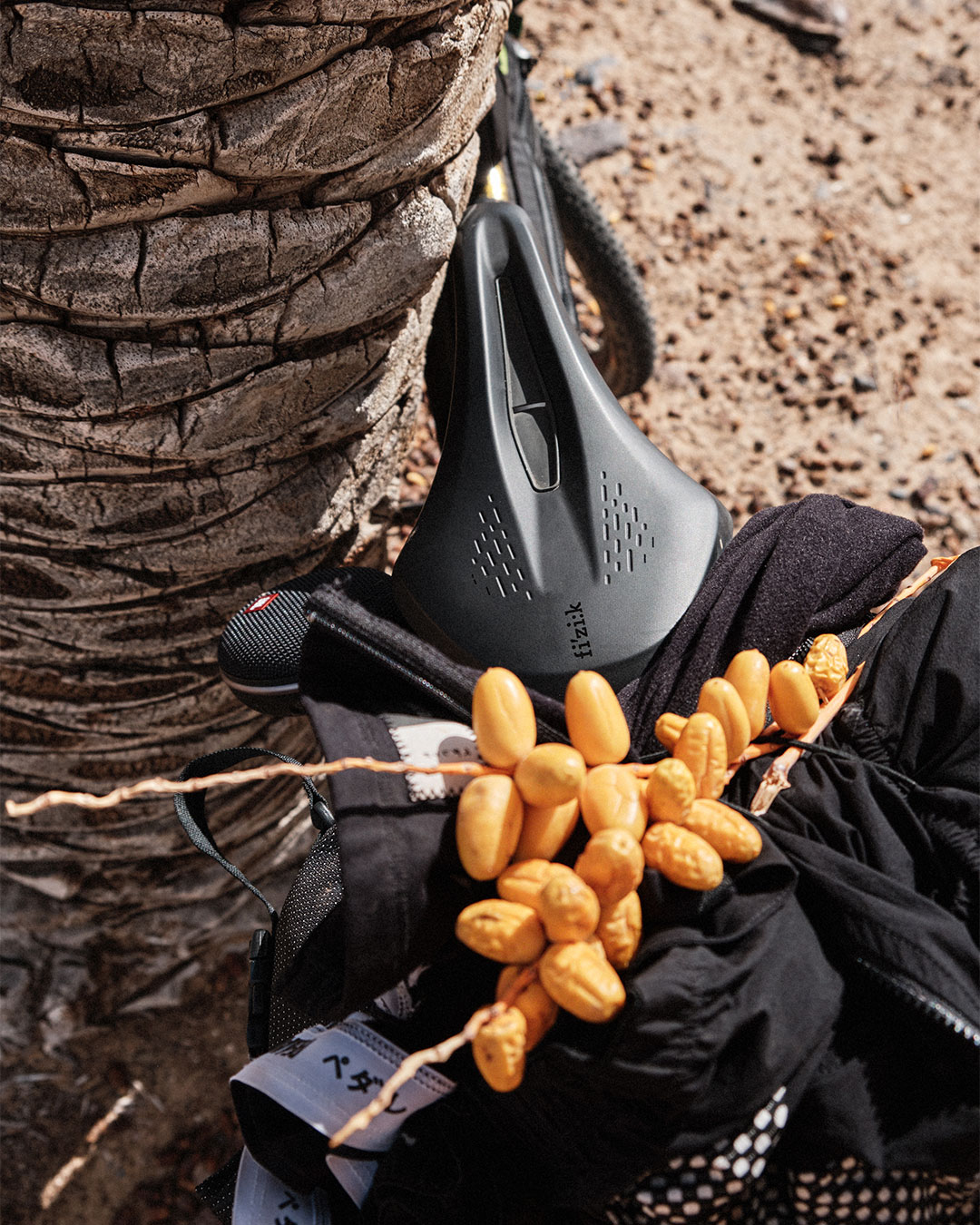
And then if you take the wrong road and have to climb back up an extra 500 meters for nothing, you feel like a real idiot.
But we had fun, especially the next day, descending with a view over the ocean and the sheer cliffs rising from the water. Then with the sunset …
Tenerife, great love — green, barren, desert, either dark or light — it has a little bit of everything. Even people in the dance club who’d take you home.
Teide won us over. Climbing among those pines loaded with moss and lichens, I felt like a hobbit on two wheels.


Fortunately, after all this the open sky returned, above 2,000 meters.
A roller coaster of temperatures, weather and humidity until you glide to the coast after 40, 50, 60 kilometers of descent, and if you’re lucky you end up in some karaoke bar for tourists at the beach and you feel at home there too, especially if the place is managed by and filled with Brits from Manchester.
It’s true, mi cabra es tu cabra, and the Canaries are a place for many but not for everyone (let’s not fill them up — they’re beautiful like this).

Photos and words by @nadiamoro
Having experienced many different trails and races across Europe, one cannot say Enough Cycling Collective has a local approach to gravel riding and adventures. The Canary Islands and Spanish deserts as well as the Balkans and Moroccan Atlas Mountains are just a few of the places the Italian riders have crossed with their bikes over the last couple of years.
When it comes to gravel, though, it’s safe to say that Europe and the USA seem to be two different worlds—or even better, two sides of the same coin. It’s no wonder Enough Cycling was so keen on getting to Kansas to race Unbound Gravel. Arguably the most famous gravel race in the world, Unbound unfolds throughout the Flint Hills around Emporia with three different course lengths: 100 miles, 200 miles and 350 miles.
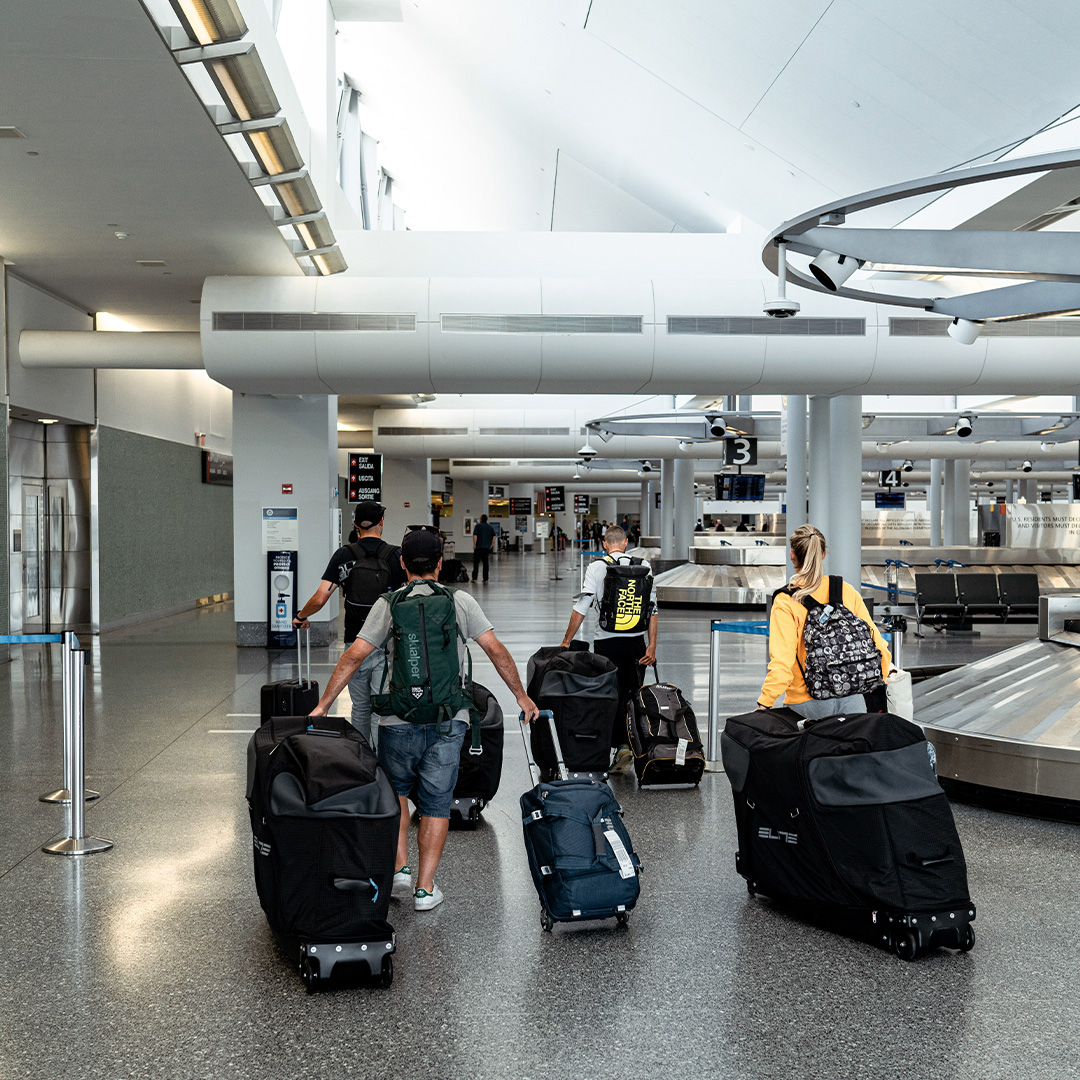

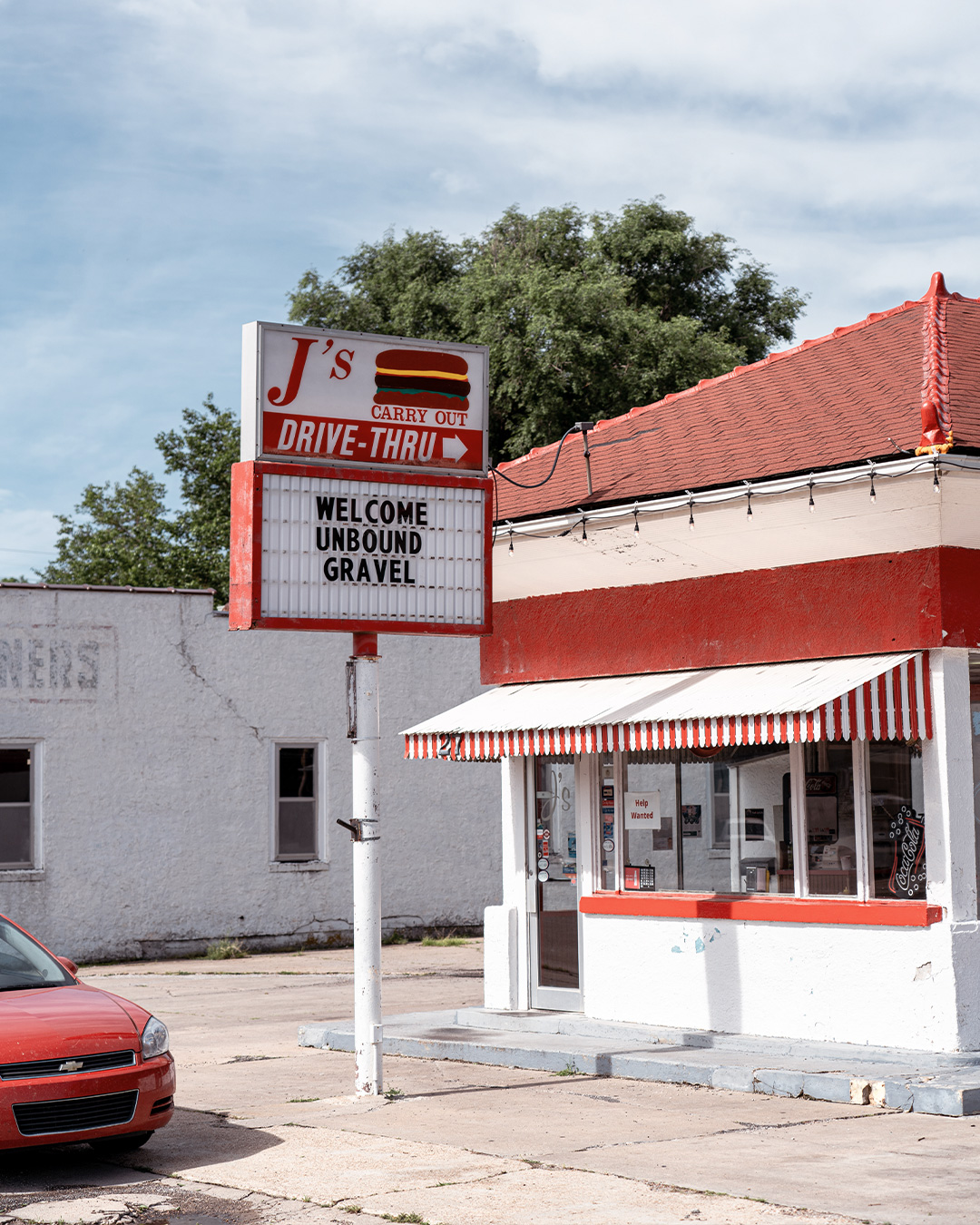

While challenging, even the longest 350-mile course can’t be considered a true adventure race, not by Enough standards, at least. After all, everything at Unbound happens in less than 24 hours, the course and the info are very straightforward, and you know what’s ahead of you at all times.
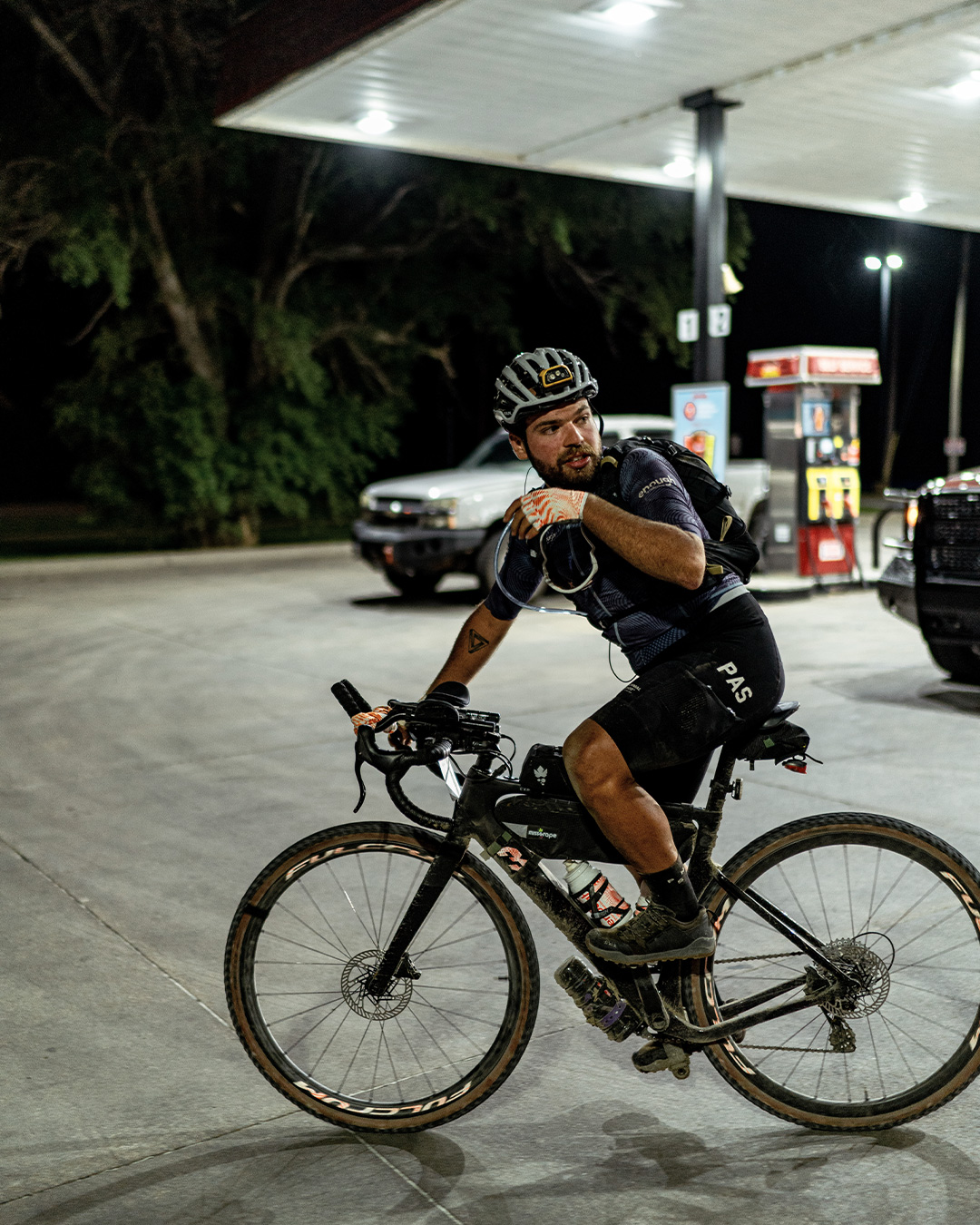

It was the first time we’d set foot in the States to race on gravel, and we can say the overall experience is what made it an adventure,” says FEDERICO DAMIANI, rider of the Enough group who tackled the 350-mile race.
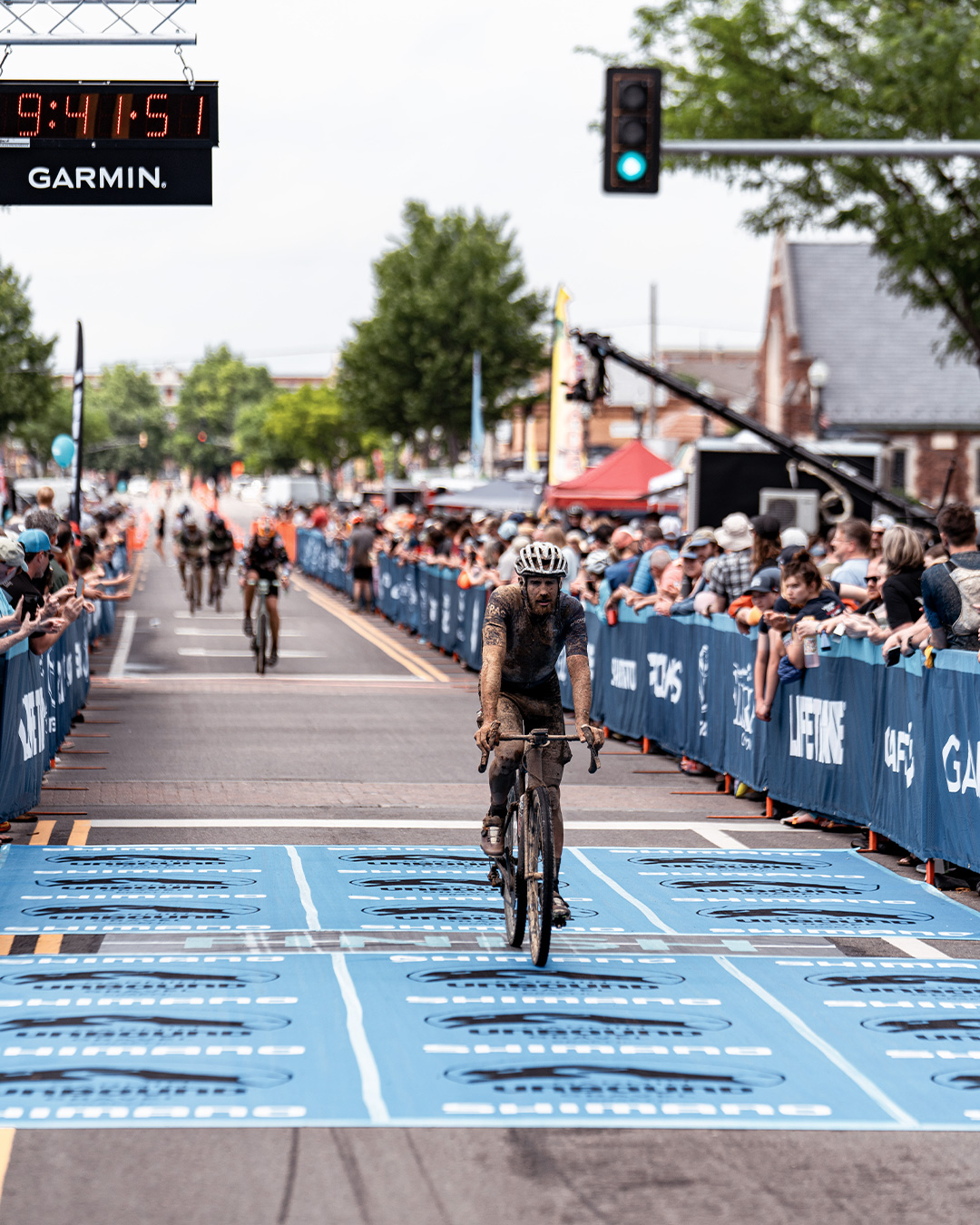
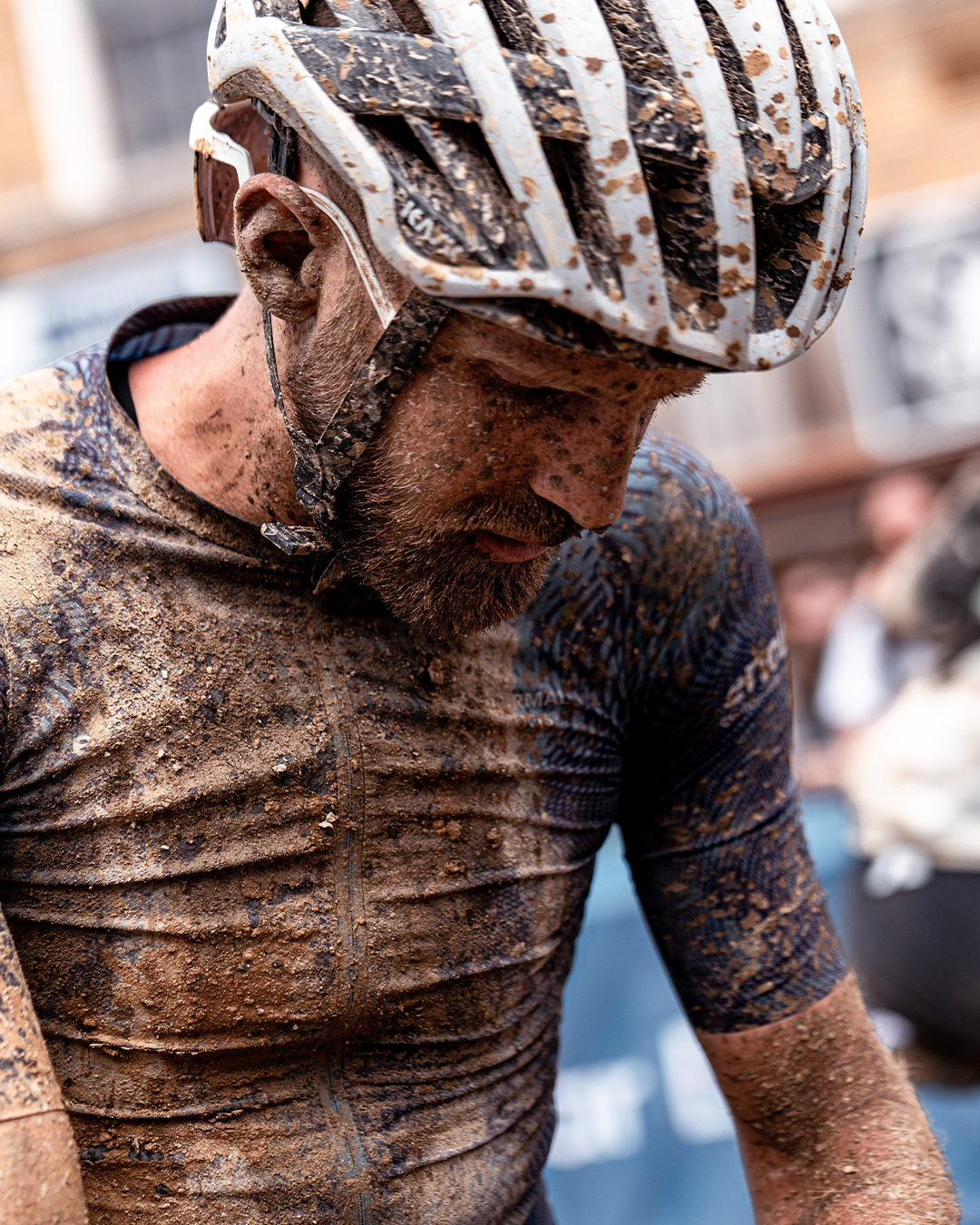
MATTIA DE MARCHI is, without a doubt, one of the most versatile and well-known gravel riders in Europe. At 31 years old and with a previous career as a road rider, he’d never been in the US before Unbound 2022. “When we landed in Kansas City, I was like, ok, this is really happening. I had waited for that moment for so long, and I couldn’t wait any longer. Being in the US was just great, and it felt like living in a movie for five days: the cars, the people, the houses, the supermarkets—everything like I imagined it to be.”
We understood that we needed our own crew in the last few days leading up to the race, and getting everything ready was not easy, but we managed to put together an awesome team, and our checkpoint breaks looked much like F1 pit stops. It was pure adrenaline!”
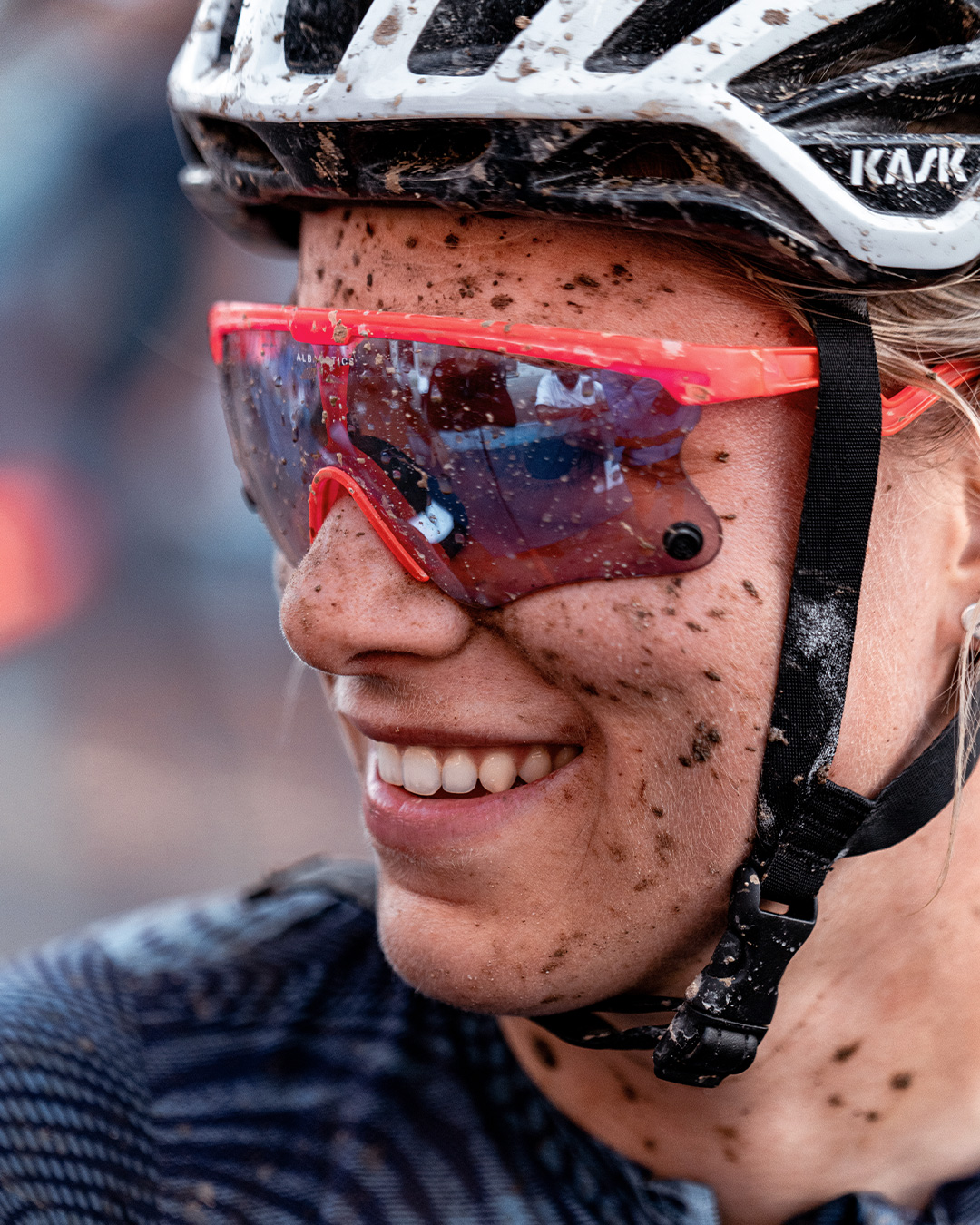
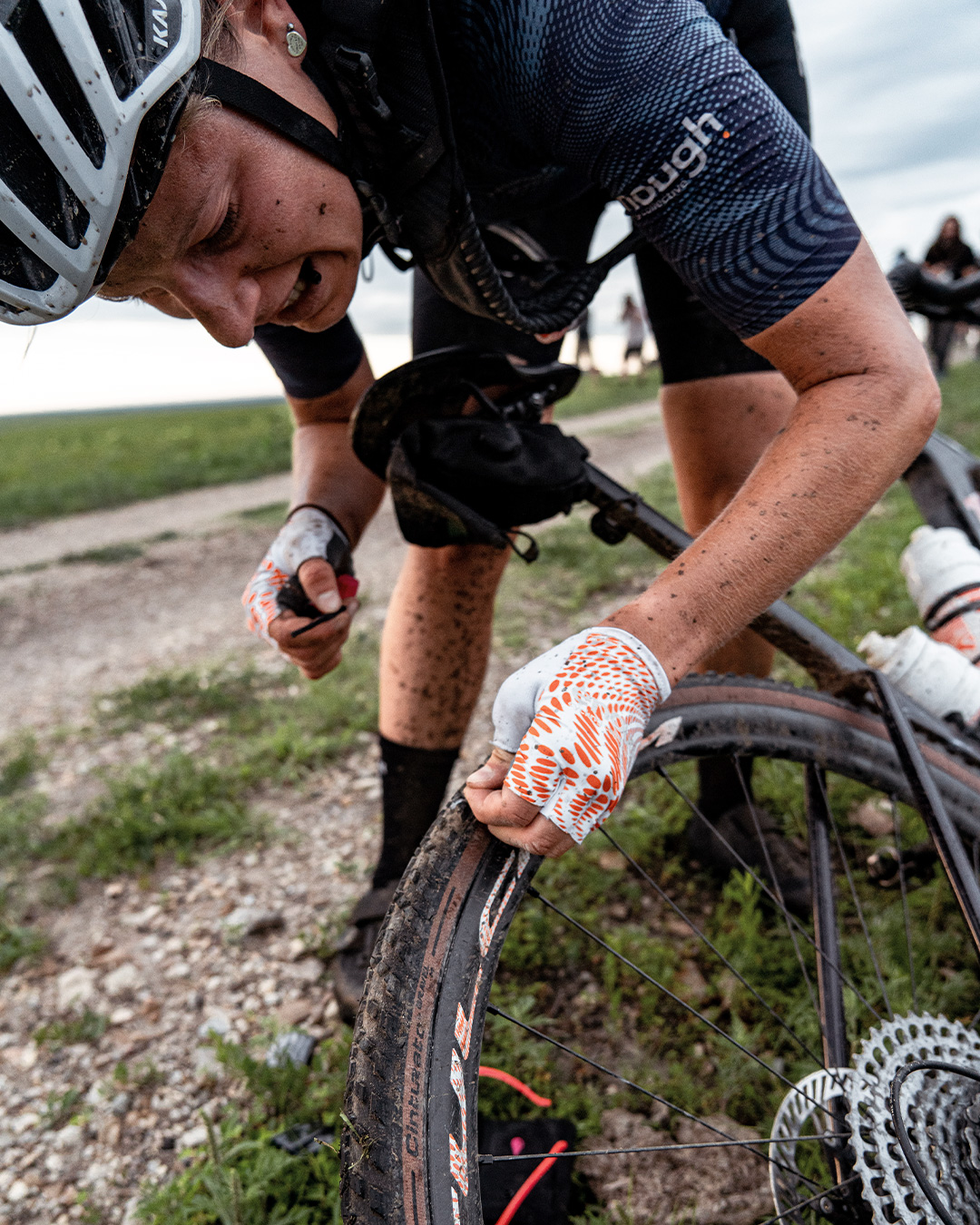
MARIA VITTORIA SPEROTTO had quite a different experience: “It was not the first time racing in the US for me. I raced the Tour of California on road when I was a Pro a couple of years ago, and I remembered a lot of enthusiasm and an awesome crowd on the streets. I was not sure if I would find such vibrant support here in Emporia for a gravel race, but hey, it was awesome! The start and the finish line were so packed and loud, and you can really feel the community is strong. I really didn’t expect that kind of excitement.”
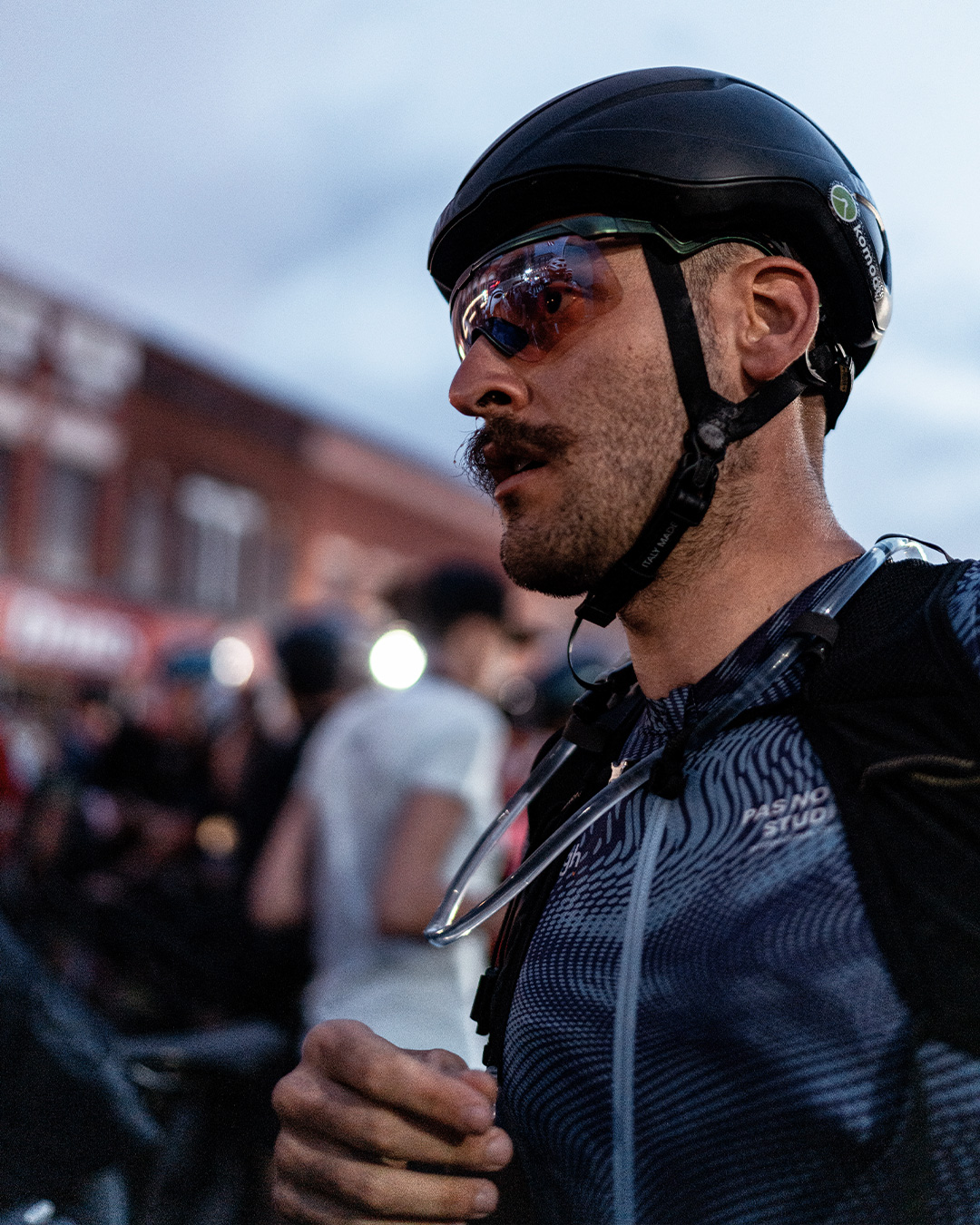

FRANCESCO BETTINI is another Enough cyclist who raced the 200-mile course, and it was quite an experience for him, too. “I learned that mud is just on another level here—so sticky and so difficult to ride on. As a matter of fact, I crashed and was forced out before CP2. But the experience itself was so good—being on the road with the guys was the experience of a lifetime.”
The best part? The journey. And the food of course. It can be surprising when it’s someone from Tuscany saying so, but once in a while, it’s good to eat true American food in a true American diner! Especially when you need to make up all the calories you burned during a 9-hour race.”
Federico views their time in Kansas from a different perspective: “I lived in the US for three months when I was younger, in New York. I was so curious to experience a different kind of America, and the Midwest proved to be on the other side of that spectrum with its wide-open spaces and hills. In New York, I was overwhelmed by the noise and the constant contact with people. The night of the race in Kansas, I experienced solitude and contact with nature and fauna.”
“It’s so great to know it’s truly a whole continent. I’ve just started to experience this, and there are many other awesome, different and interesting places and trails just waiting for us to go ride!”
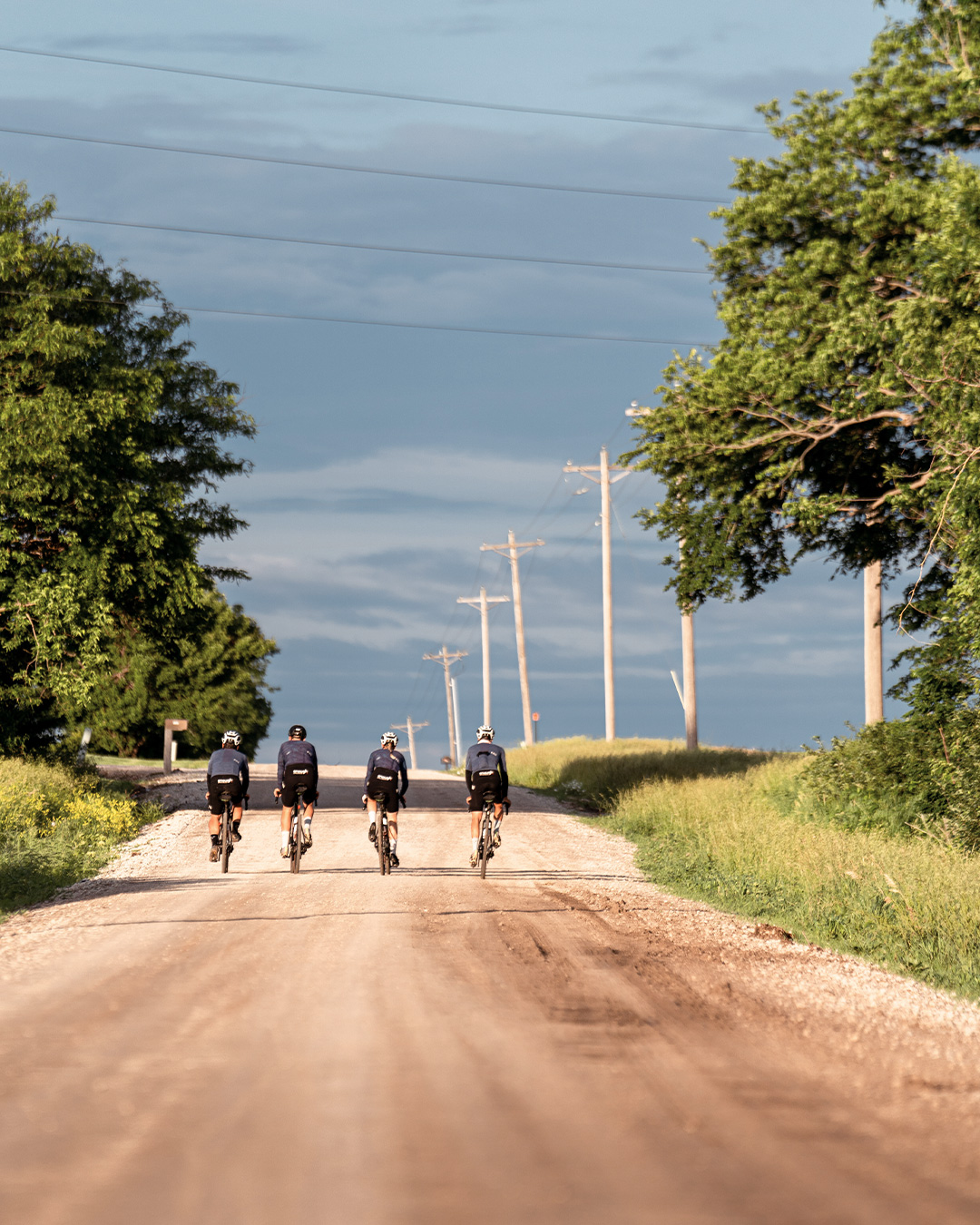
All in all, the whole Enough Cycling expedition to Unbound was an adventure indeed, as it always is when you set foot in an environment for the first time. This is only the first step in their walk through the American gravel scene and community. Who knows where and how far the path will lead them—we just can’t wait to see!
Photos by
(@samisauri)
Sitting in the middle of Macaronesia, about 520km off the African coast, lies the island of Madeira. Rising from the bottom of the Atlantic, the island reaches more than 1,800 metres at its highest point, and within a small area of 740 km2, you can find different climates, contrasts and breath-taking views.
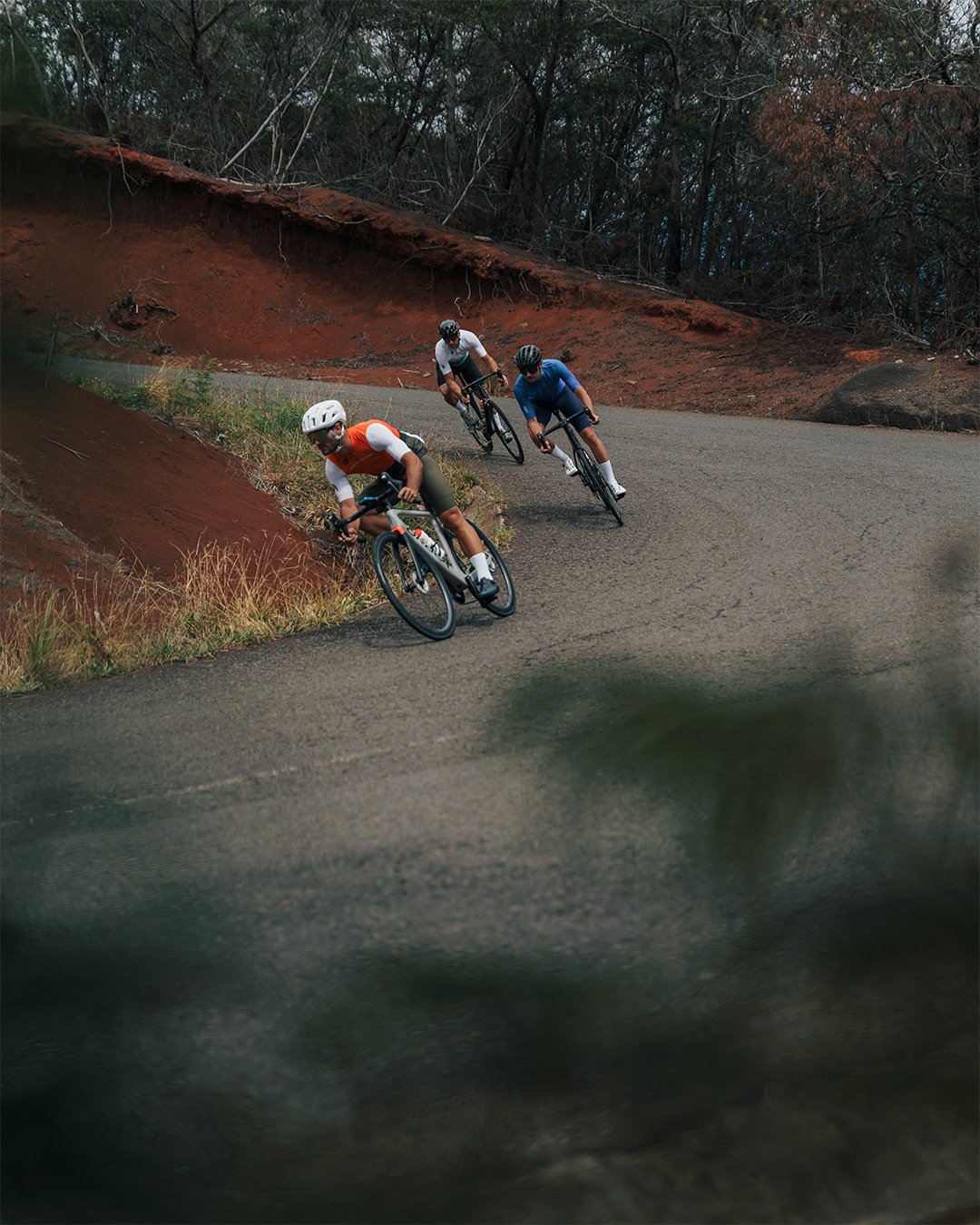


STEEP STREETS AND VOLCANIC SHORELINES
– 80km +2,390m
We started in Funchal, the capital of Madeira, and it was a pleasant start… for 10 minutes. After that, we tasted what was, at the time, the steepest road I have ever ridden. It was unbelievable; we had to ride in zigzags using the entire street. And we weren’t even out of Funchal. We can say that it was a hard start.
After suffering a little bit more, we left the city and entered a less-populated area where we started to see the green colours of Madeira. We were headed to Ponta de Sao Lourenço, the easternmost point of the island.
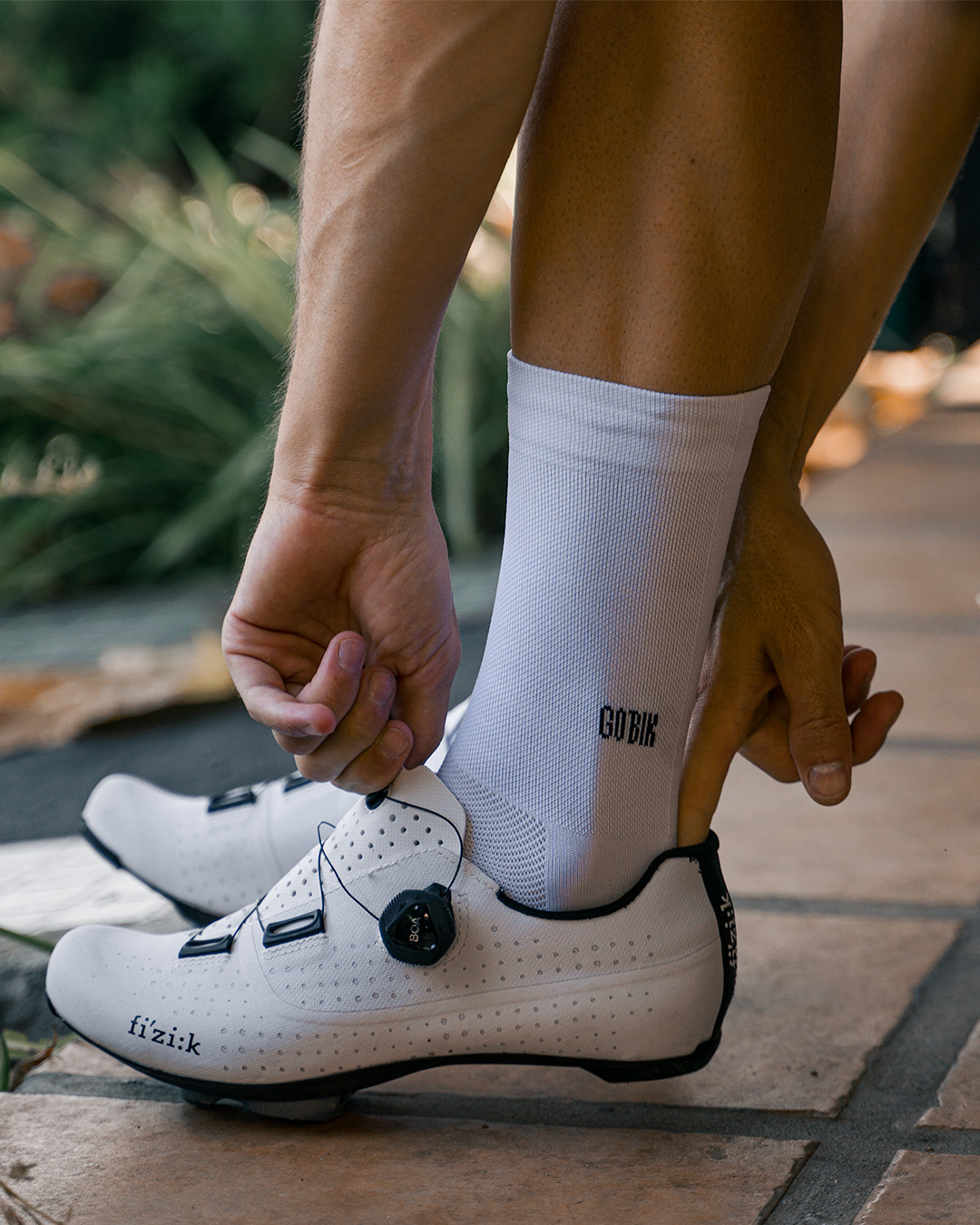
Ponta de Sao Lourenço is a completely treeless landscape where oranges and browns are the main colors. We rode to the end where we could see sharp volcanic rocks.
We turned back and headed towards Porto da Cruz, riding up and through a steep 4km pass, until we reached Miradouro do Curtado and rode down to Santana where we stopped for the first night.
CLIMBING THROUGH THE CANOPY – 70km +2,930m
This was a big day on paper as we faced an hors catégorie climb of 12km, from sea level to over 1,000 meters. We started in Santana, and riding along the ER101, we passed through a rural area where houses sat in the middle of small fields. Up and down rolling hills, it was a nice warm-up for the day ahead.
We crossed the small towns of Sao Jorge, Boaventura and Ponta Delgada on a nice road near the coast—all curves, ups and downs, a couple of tunnels and a short, steep section until we made it to the town of Sao Vicente.
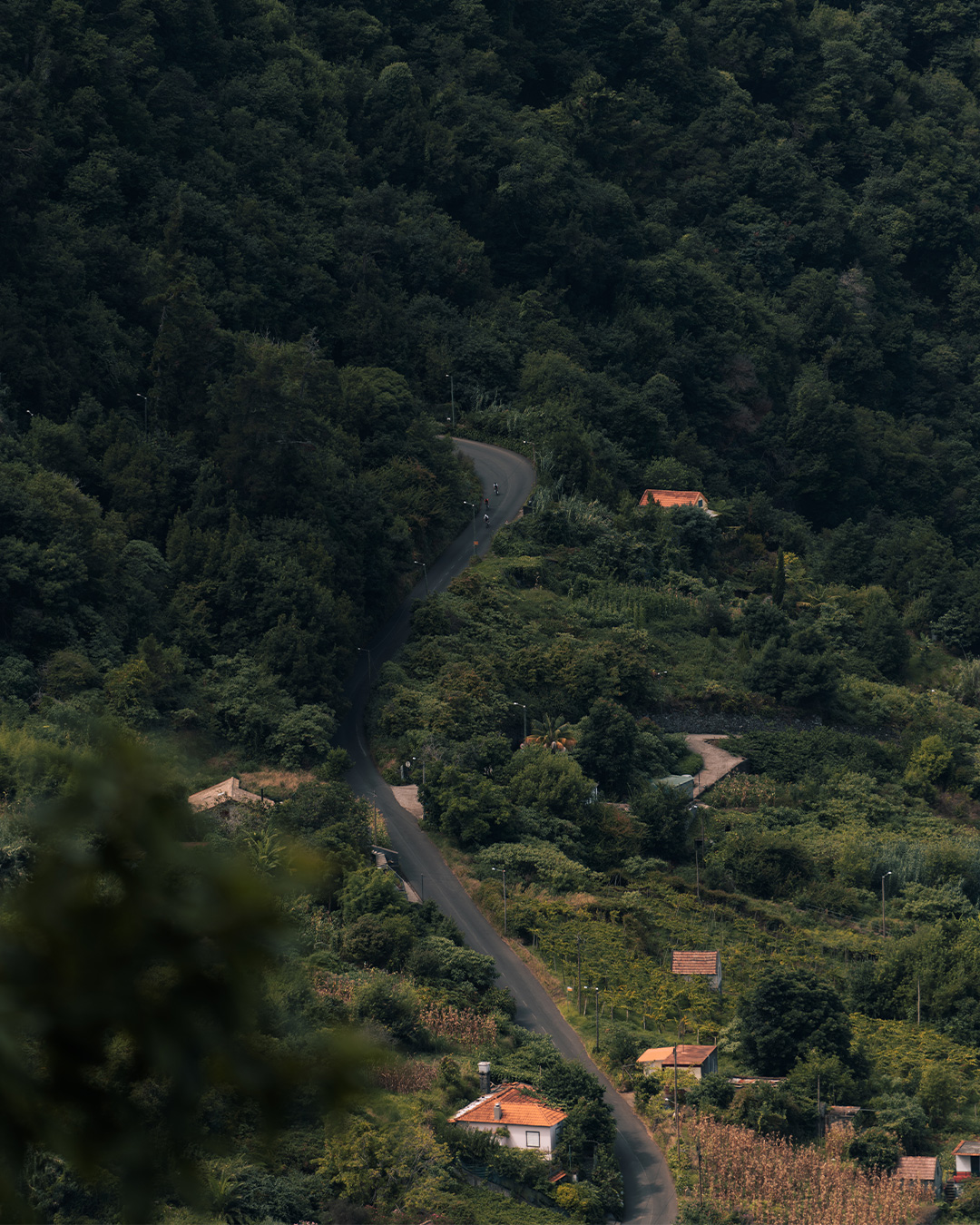
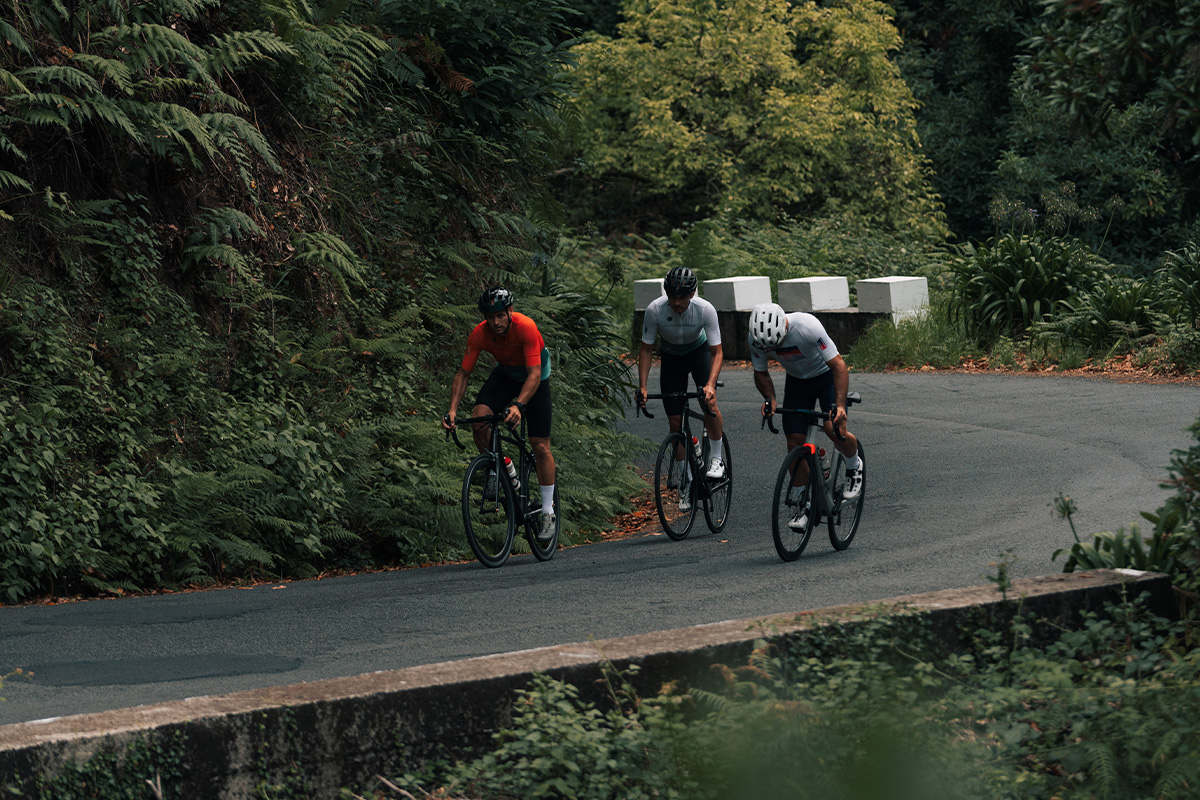
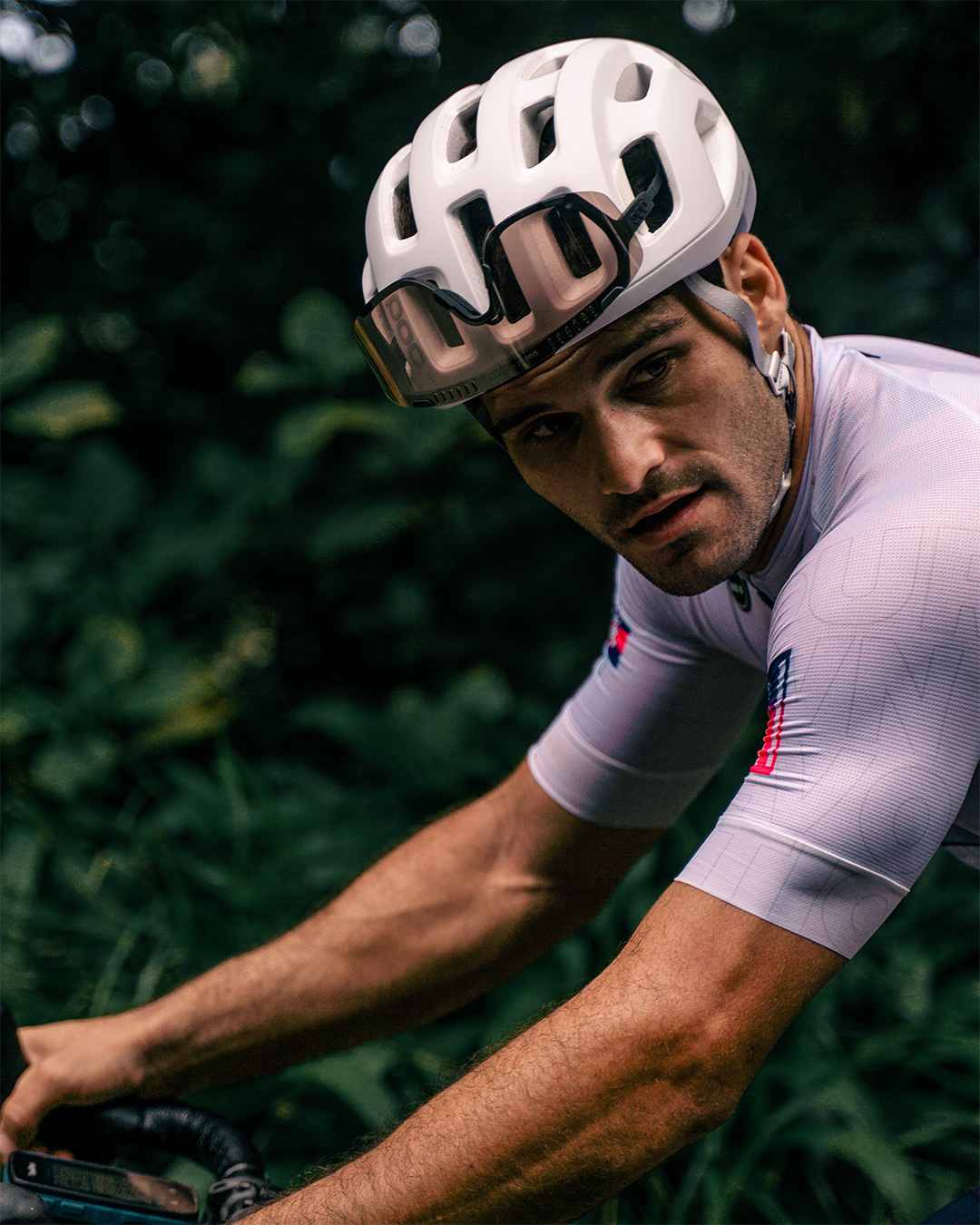
Even though we knew what was coming, it was tough. We had never ridden a climb like that; the steepness was unbelievable, but the scenery was unbeatable. It was like they built the road in the middle of the forest—so deep, so green and so full of life, you could hear a thousand birds.
After some suffering, we reached the top, and you could see both the north and the south coast of the island. You realize the steepness of the climb when you started with 25C° and sunny weather and when you reach the top, it’s all foggy and you feel the cold wind and 12C° temperatures.
It was time to go down. The hotel for that night was in Ponta do Sol (Ribeira Brava), so it was a 17km descent. It was nice to finish the day with a fun and fast downhill ride.
THREE SEASONS IN A DAY – 95km +1,840m
We started Day 3 with a transfer from the hotel (Ponta do Sol) to the Miradouro da Encumeada where we rode a short road with a couple of tunnels and curves with nice views of the valley.
The sun was shining when we started pedaling, but suddenly, fog covered the whole valley, and we had to put on our jackets. Even though we were only 16km from the sea, we were at 1,200 meters and the wind was really cold.
It was, again, a steep but pleasant climb. When we reached the top, the fog went away, and the landscape changed drastically. It was a big flat area full of windmills, and the road turned from switchbacks and slopes to straight and flat. Then, Andreu had a flat tyre and we changed it without any problems.
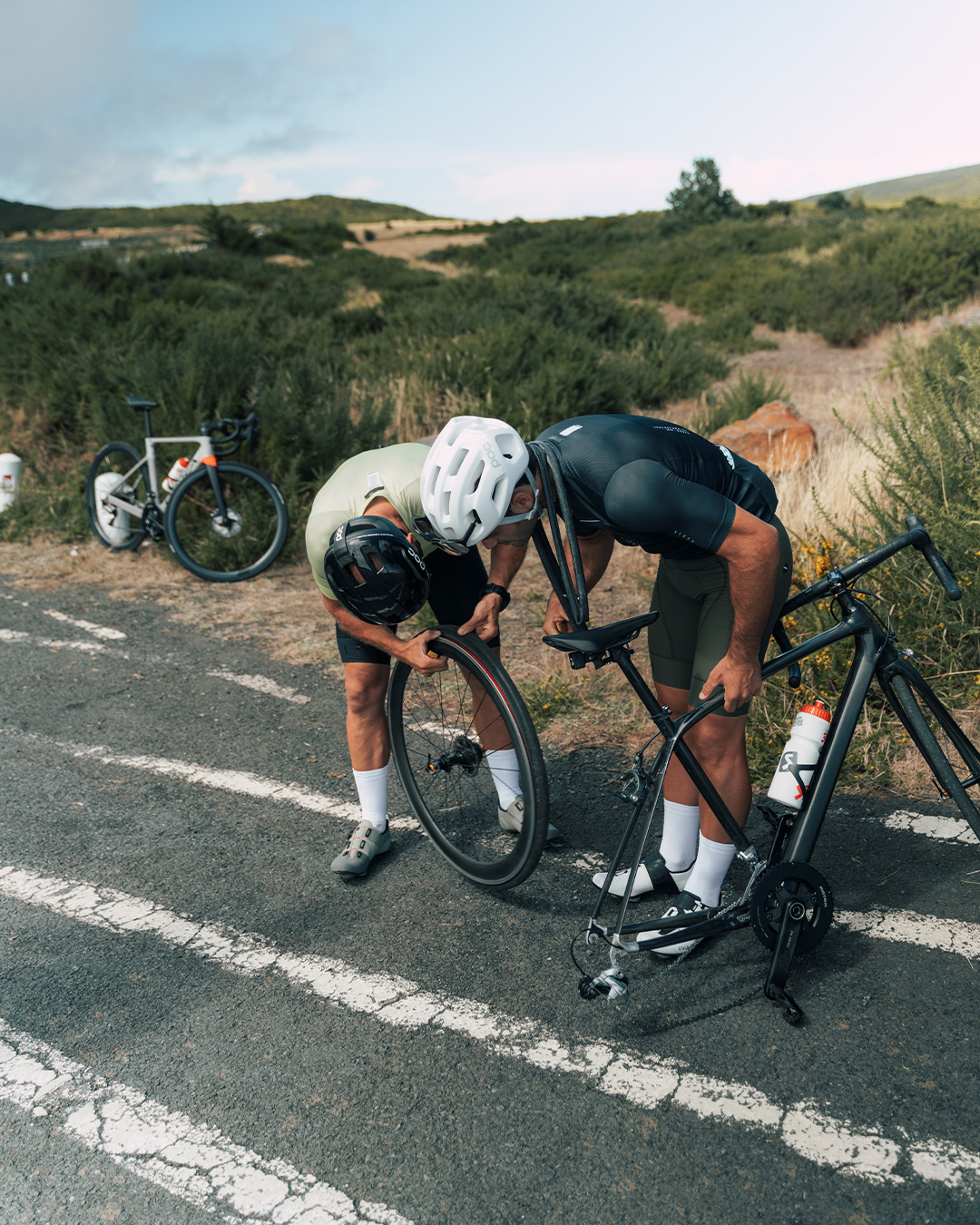
After the long straightaways, we started downhill to Porto Moniz: a 15km descent from 1,300 meters to the sea. At the start, it was nice—some relaxed downhill riding after all the long, steep climbs we had done the days before. But the descent got steeper, and the road was not very smooth. We could start to feel it in our hands and arms after some minutes as if we were riding a long trail, and again, we could feel the warmer temperatures as we went down.
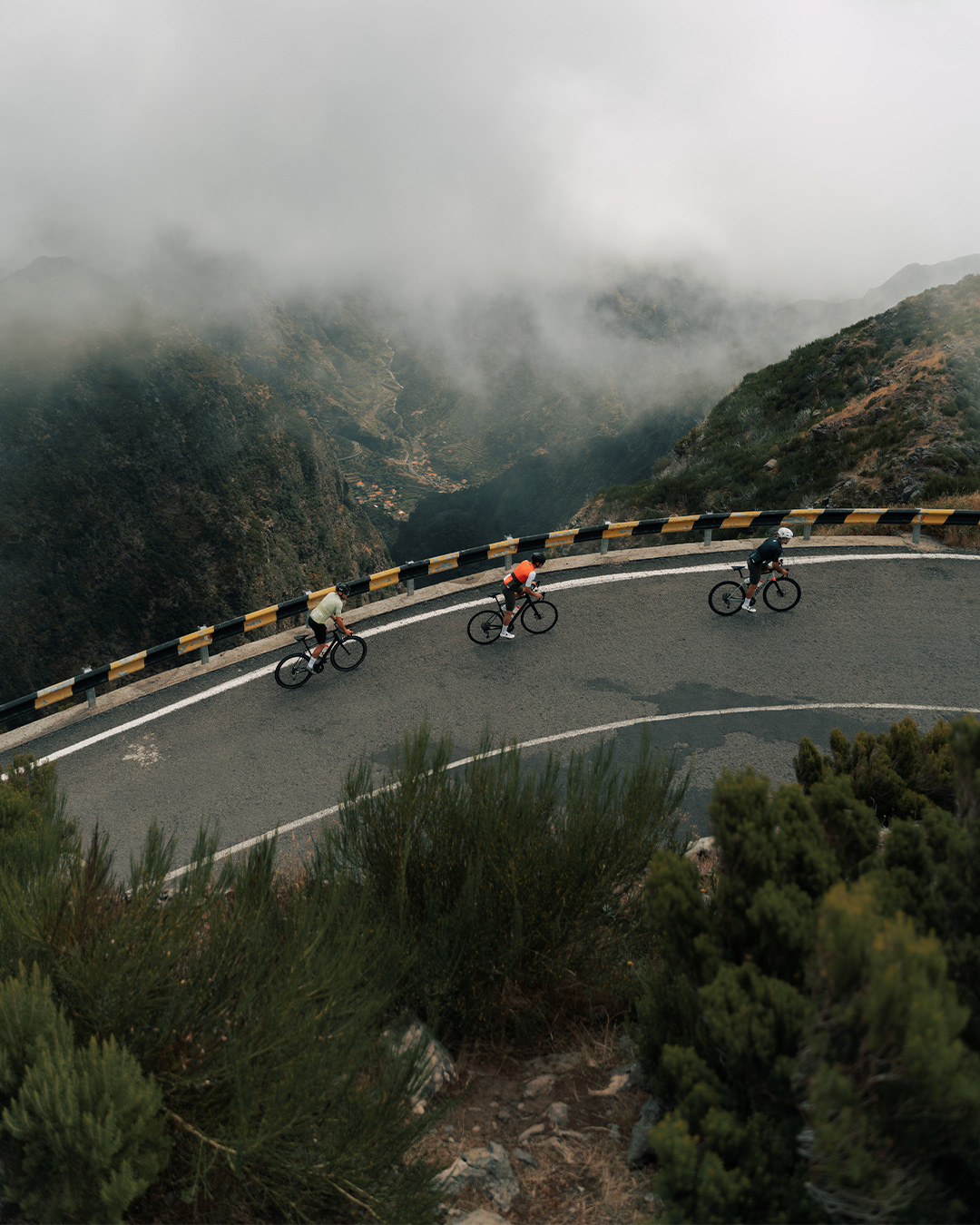

A quick break in Porto Moniz and back on the bike to do a 2.7km, 500m climb. It was tough but with nice views of the coast and the cliffs. After that, the road softened and entered a deeper forested area as the sunset. More short ups and downs and we got caught by the night and fog again.
The hotel was still some kilometres away, and it started to rain a bit. Luckily, we were near the coast, and it was not cold. Finally, we made it to Calheta where we would spend the last night.
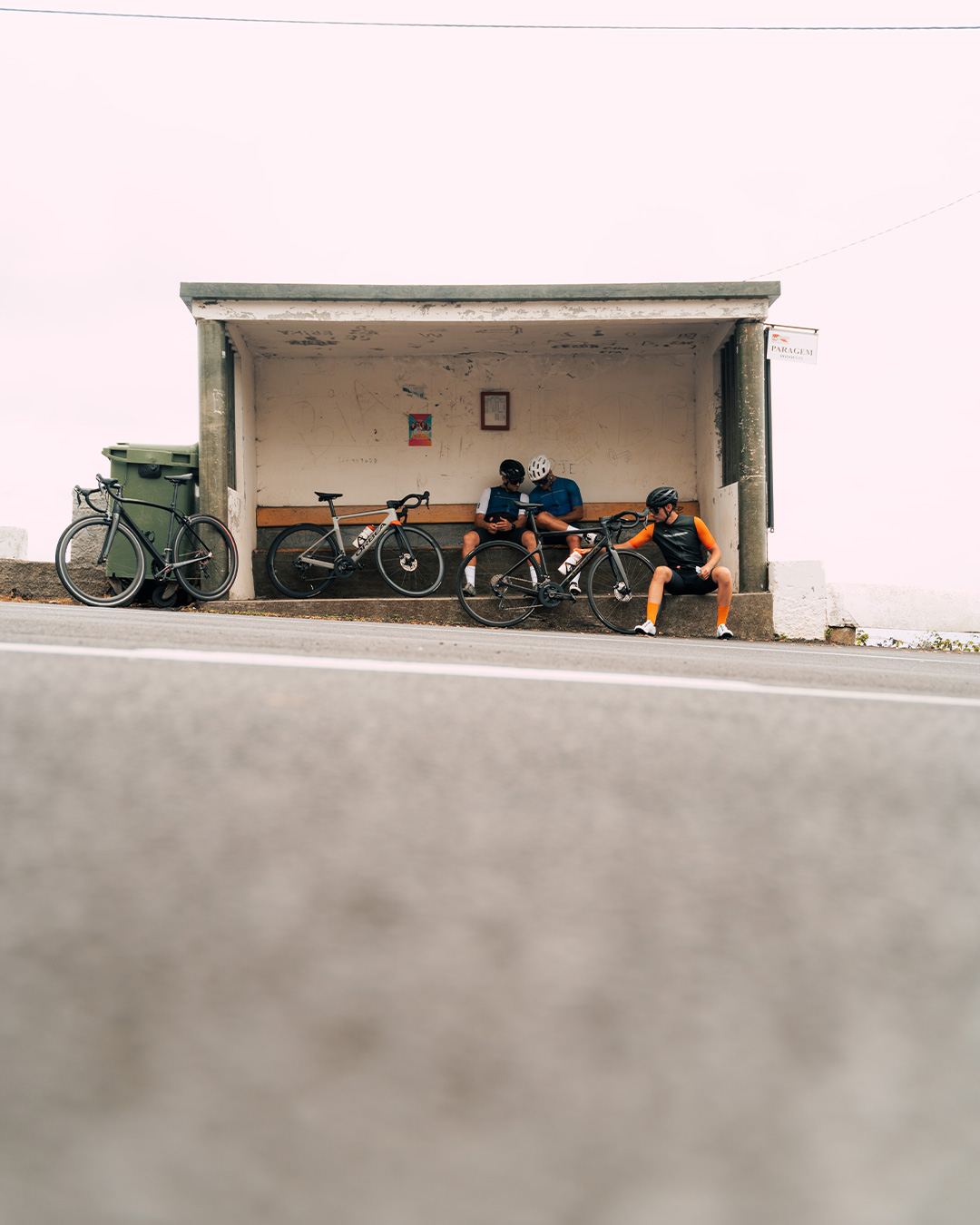
ONE FINAL FAREWELL -51km +1,350m
51km +1,350m The last day, after 297 kilometres, 8,530 metres of climbing and countless hours on the bike, we have to say we loved Madeira, and despite the hard climbs, it was worth it. To be honest, I don’t think you can see so many different types of scenery in so few kilometres anywhere else.
We recommend going, but we also recommend putting in some training hours beforehand, so you will enjoy the island even more, because it is really tough.
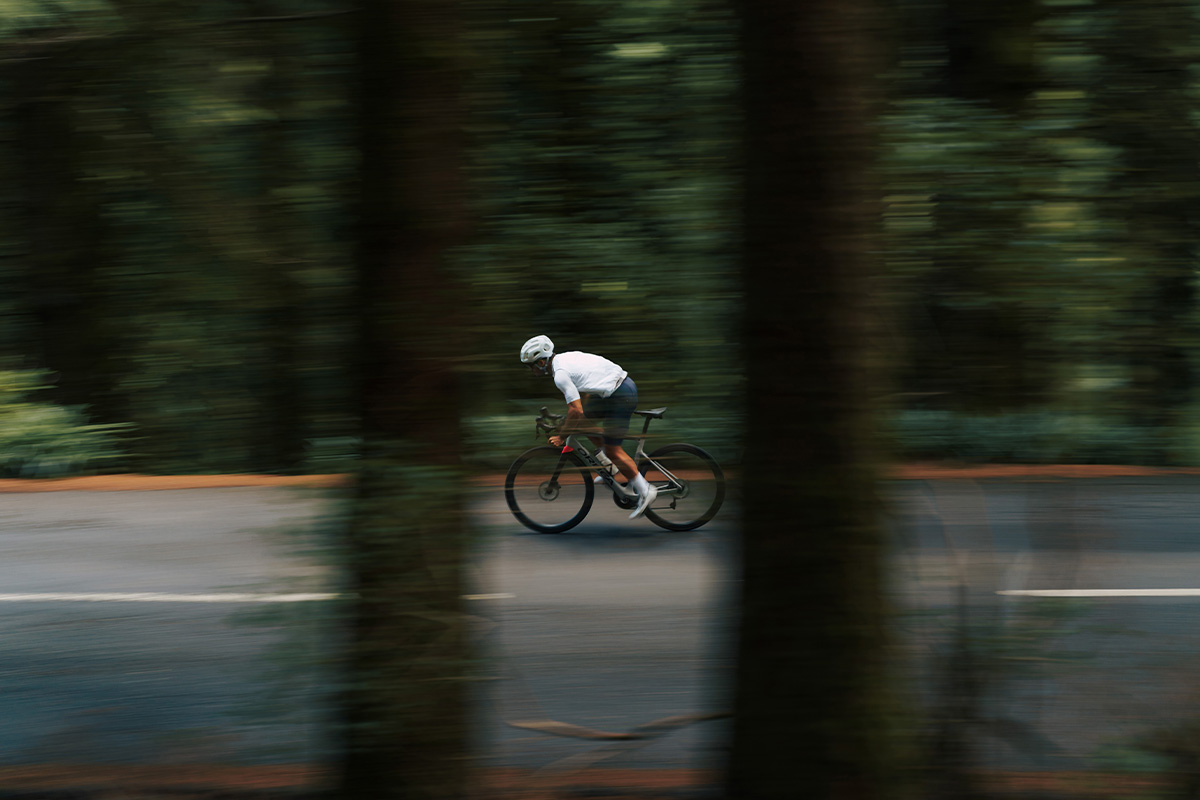
Make sure to follow Pol Tarrés (@pol.tarres), Andreu Miró (@andreumiro), Eloie Paré (@eloipare49)
Pictures by Alvaro Rodríguez and Ernest Adalid (@alvarokrodriguez / @ernestadalid )
Production by apperstudio ( https://apperstudio.com )
Ultra-endurance rider and racer Sofiane Sehili is no stranger to solitude. Carrying only what he can fit on his bike, Sofiane regularly embarks on solo endeavors in some of the most remote parts of the planet. Counted amongst his many adventures are wins at last year’s 1,800 kilometer Silk Road Mountain Race in Kyrgyzstan, Morocco’s 1,200 km Atlas Mountain Race, as well as the French Divide, Inca Divide and Italy Divide events.
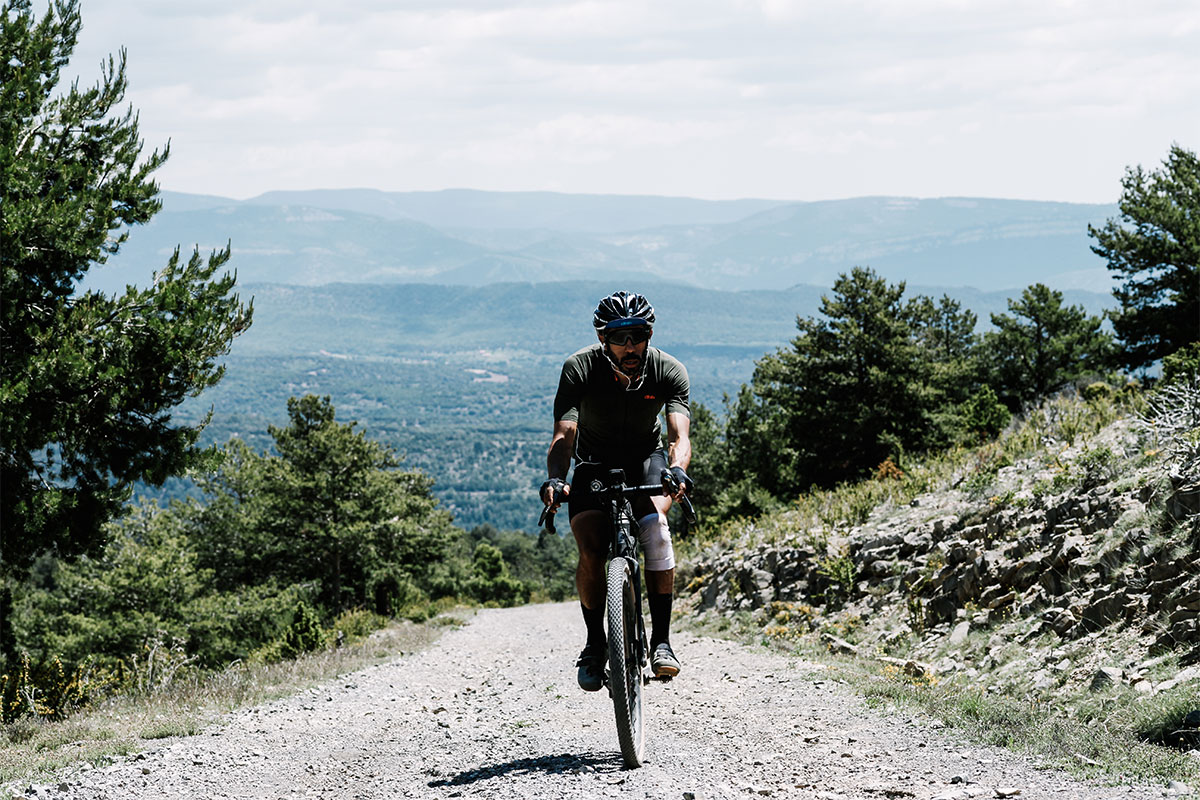
Amidst some of his biggest wins, Sofiane had to face one of his most difficult challenges when a collision with an automobile resulted in a fractured tibia and a long, steep climb to get back on the bike. What followed was months of painful healing, doctor visits and physical therapy until finally Sofiane was able to spin his legs again. Ready to set out on his first journey after the slow road to personal recovery, Sofiane sought a location that could bring him what he’d missed most: the freedom to find solitude.
And what better place to plan a quiet escape than in one of the least populated parts of Europe? Located a few hours east—and a world away—from Madrid, Spain, Montañas Vacías, is a 700km bikepacking route established by another intrepid adventurer, Ernesto Pastor, to highlight the beauty of the country’s most uninhabited region.
Ride along with Sofiane as he returns to the trails in the best way he knows how—self supported and on his own, surrounded by a quiet world waiting to be explored. Watch Solitude Paradise below.
With Lachlan on a flight path that shows no signs of slowing down, we’re honored to welcome him to the fizik family of athletes and look forward to equipping his many exciting, unpredictable adventures ahead.
Film and photos by
(@jpmothes)


